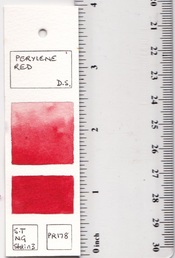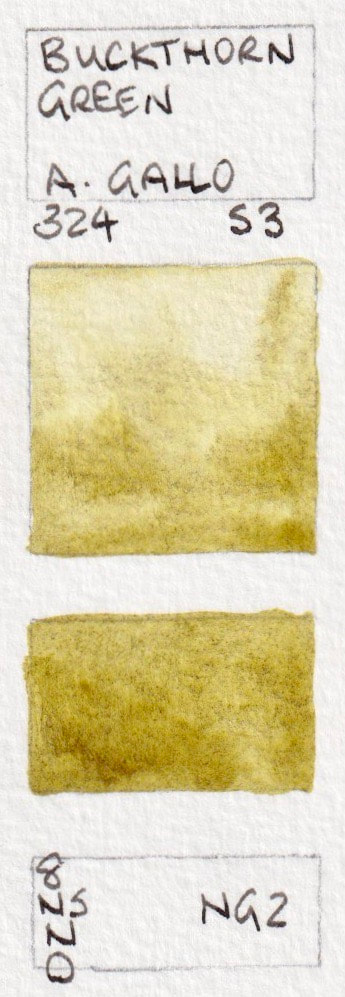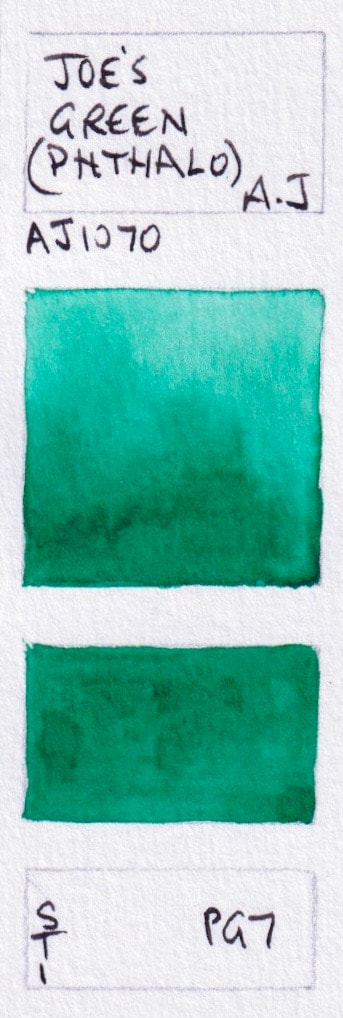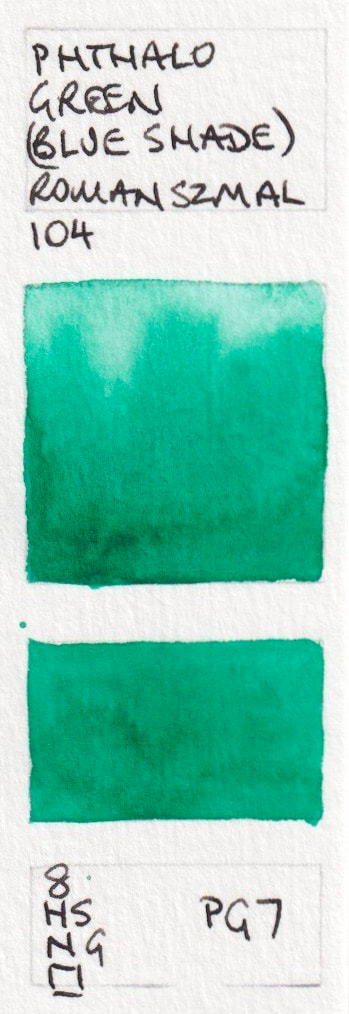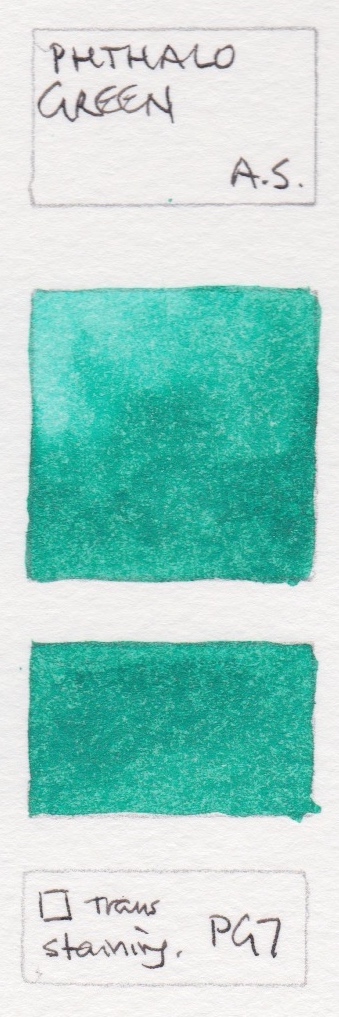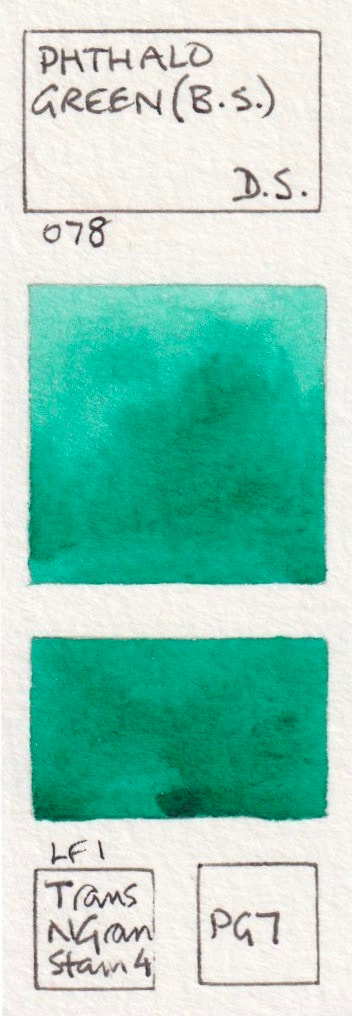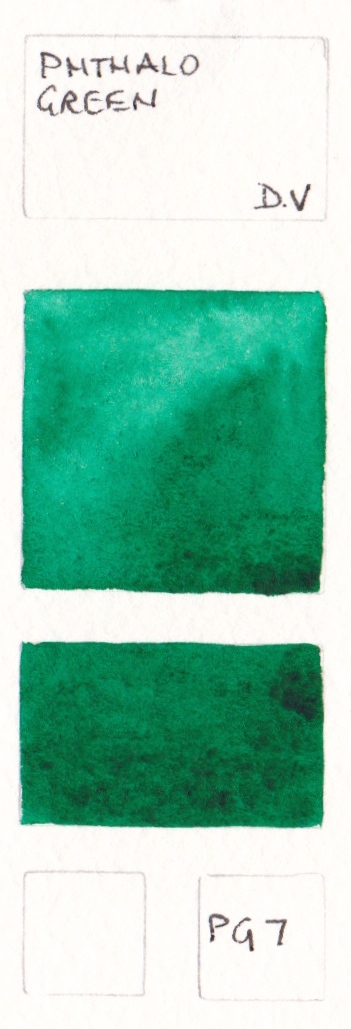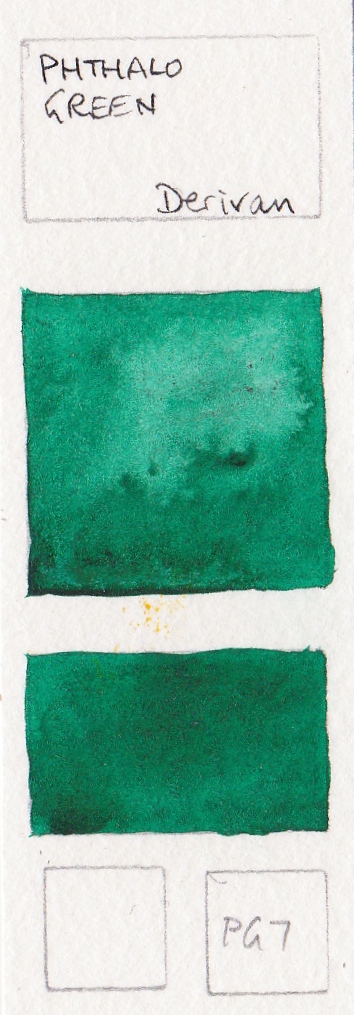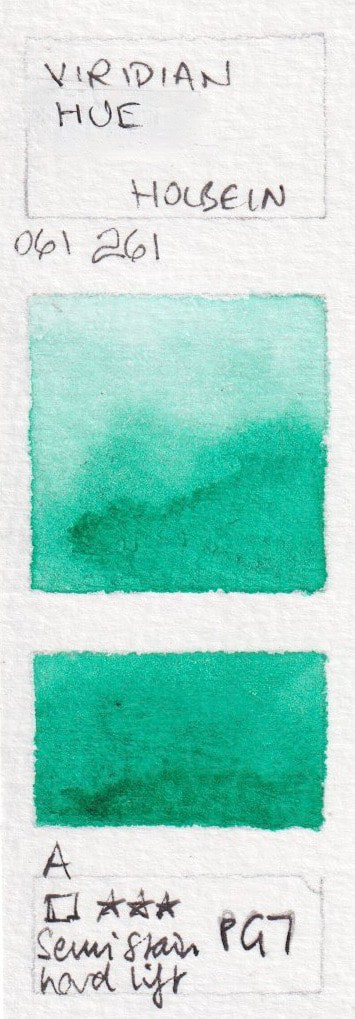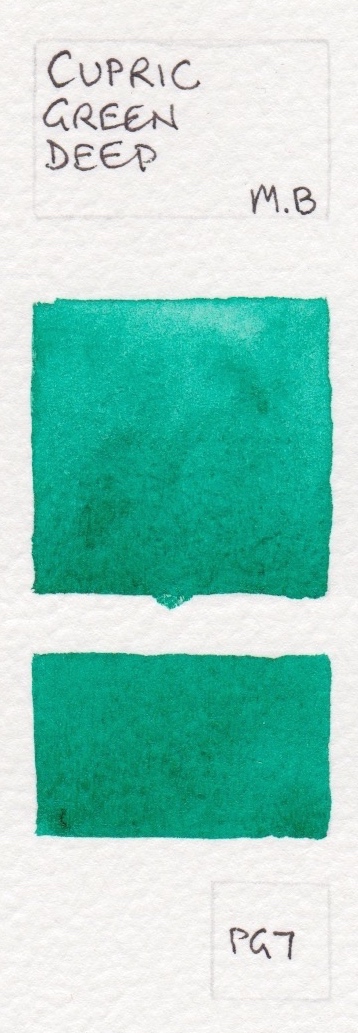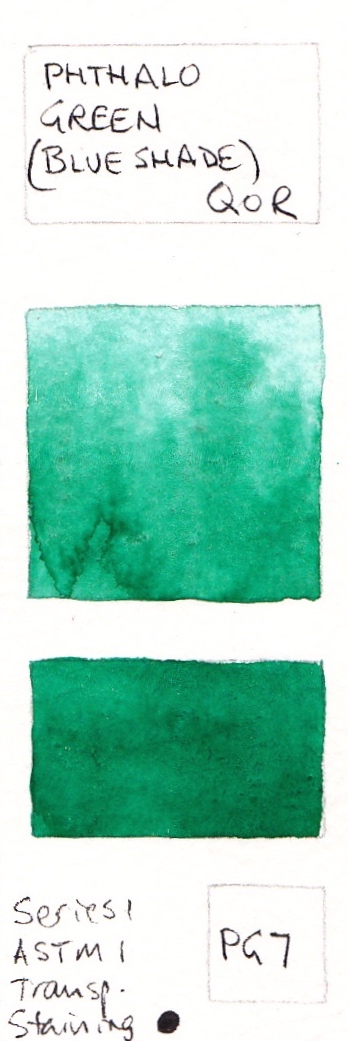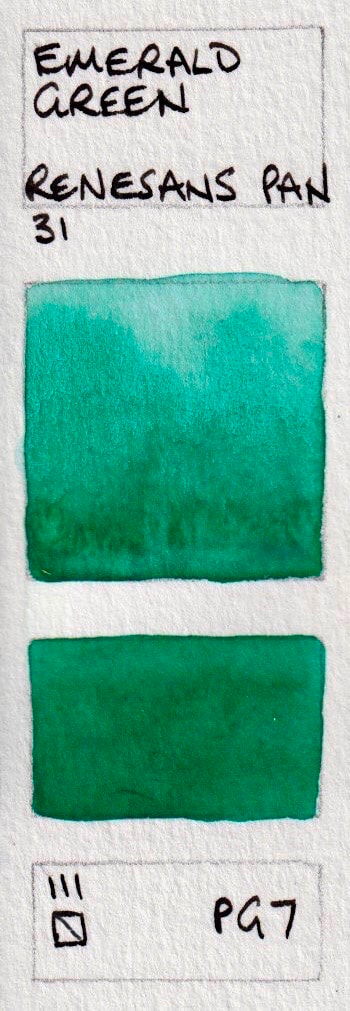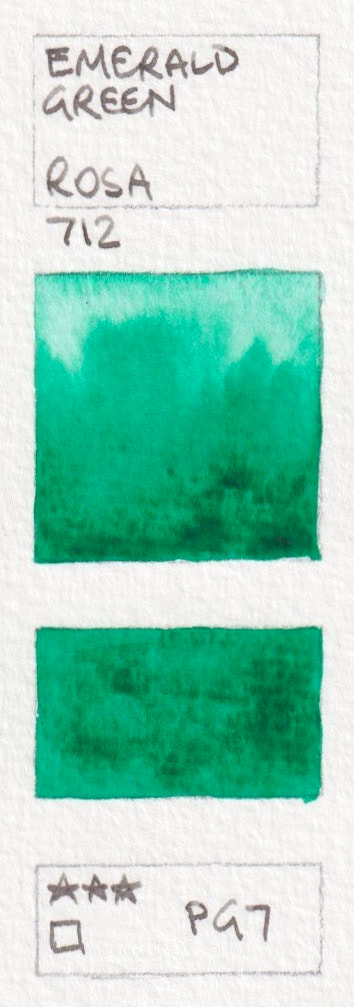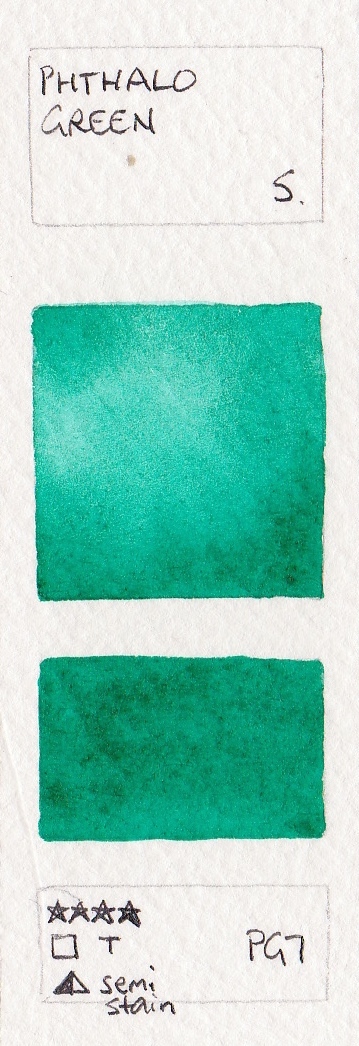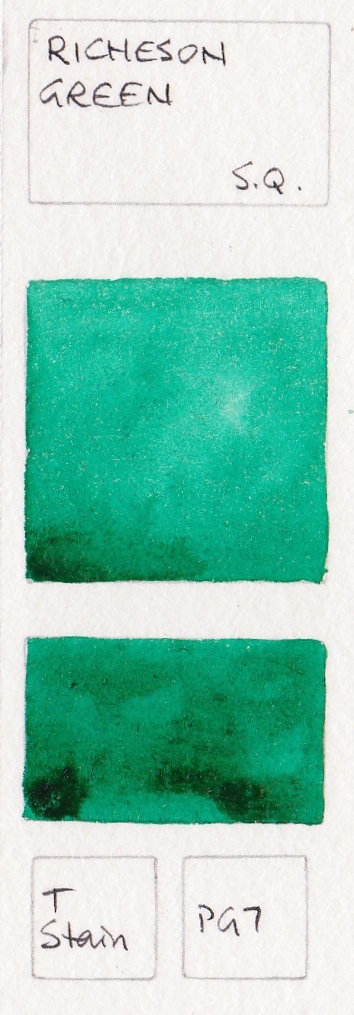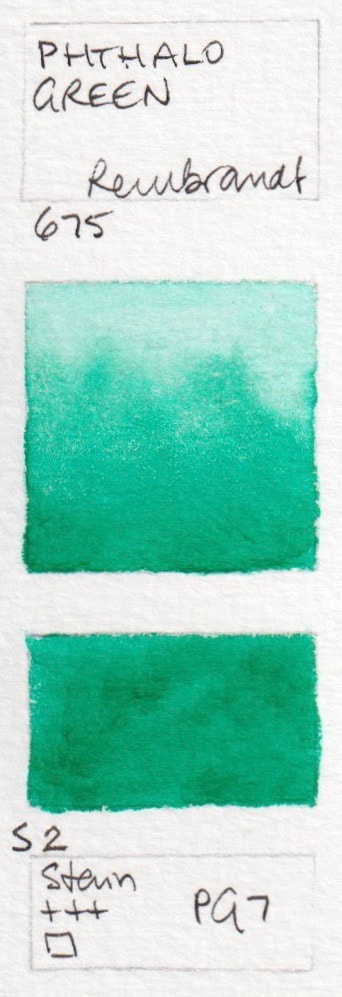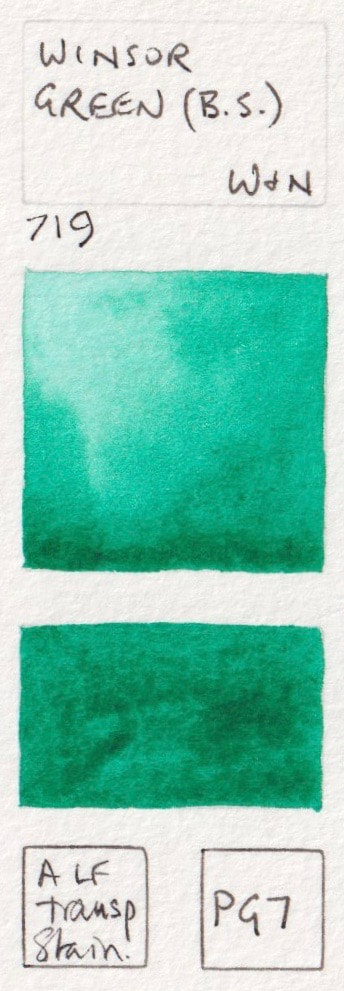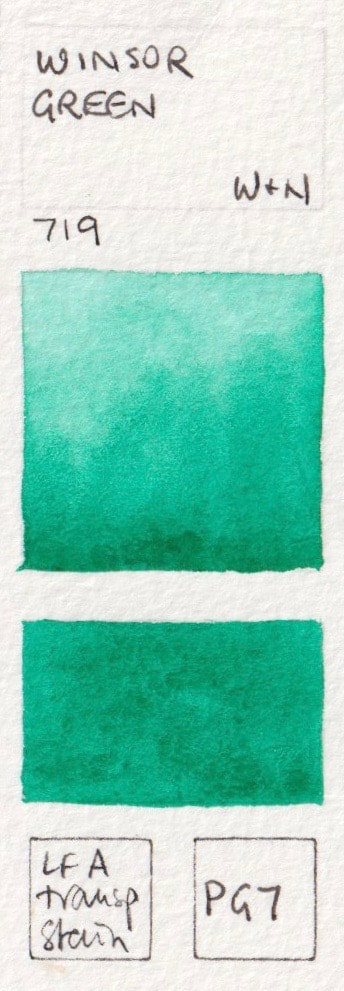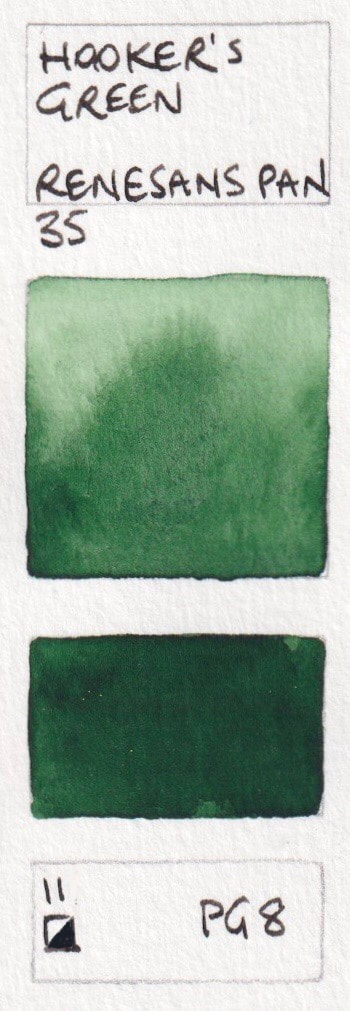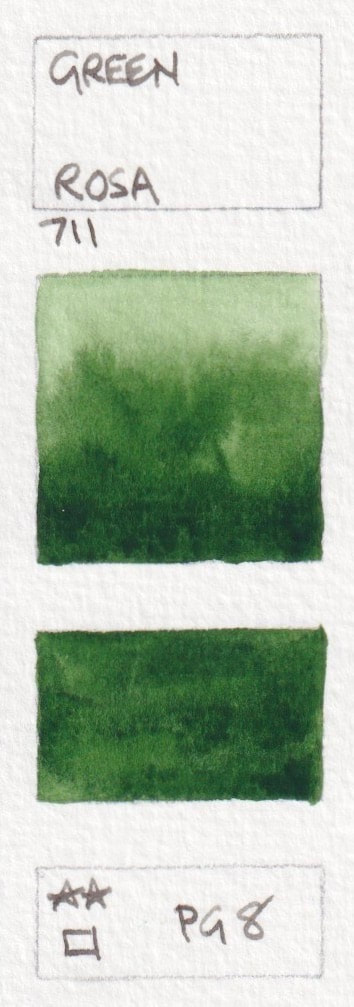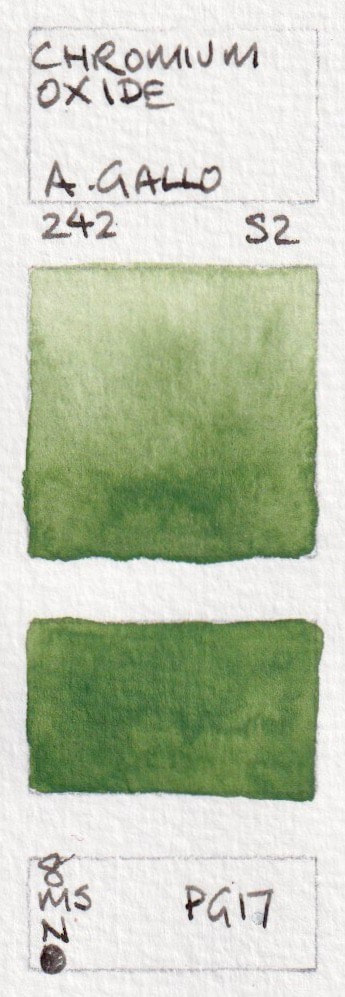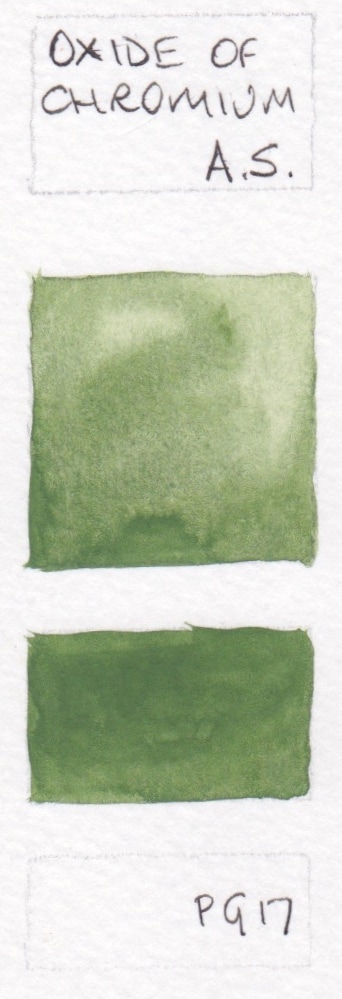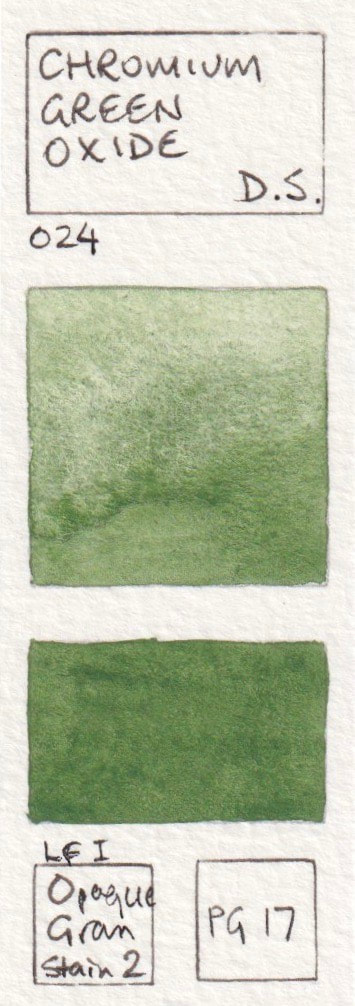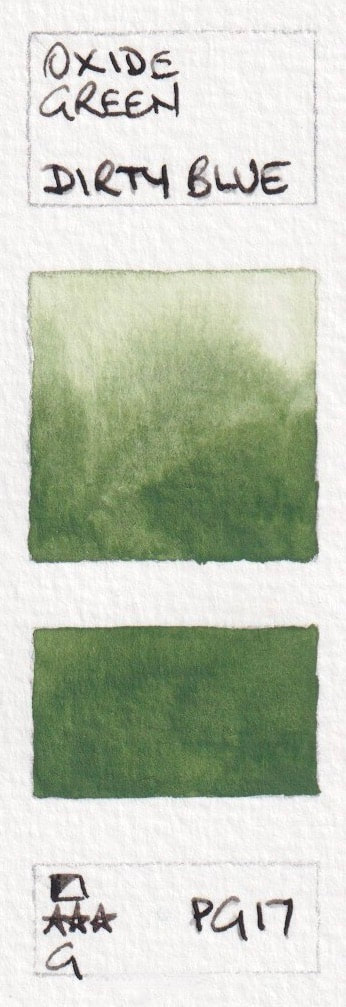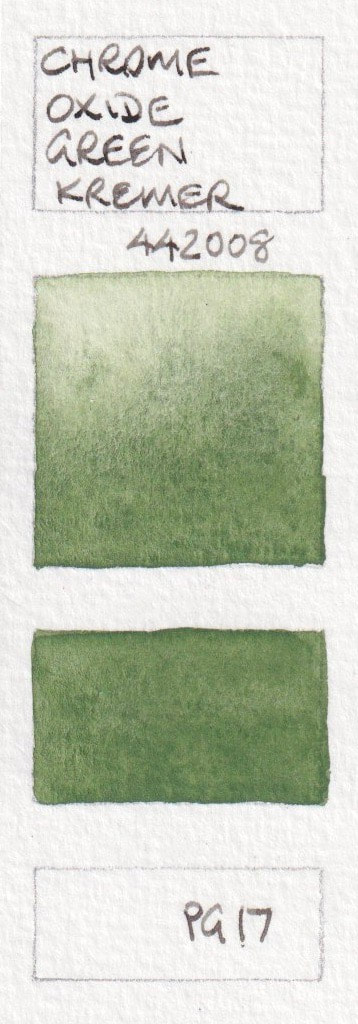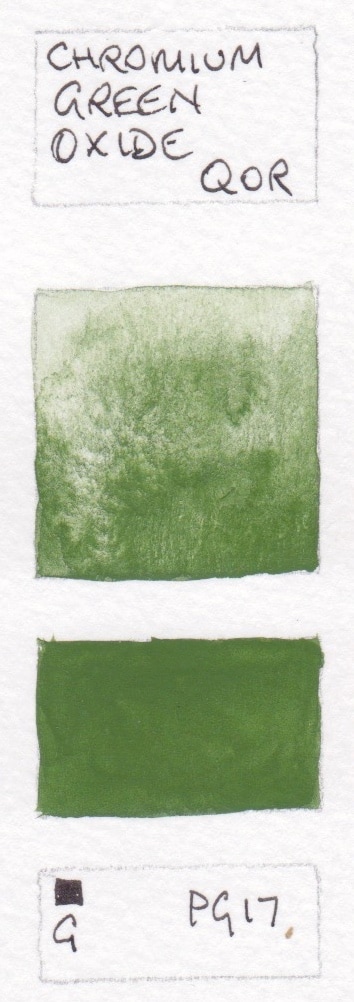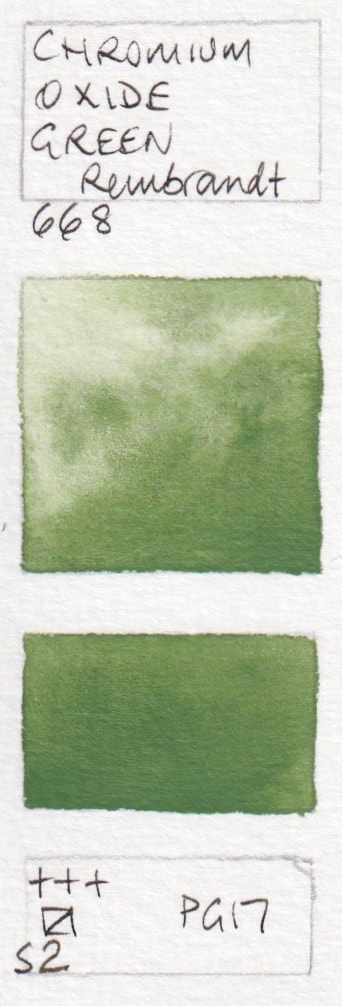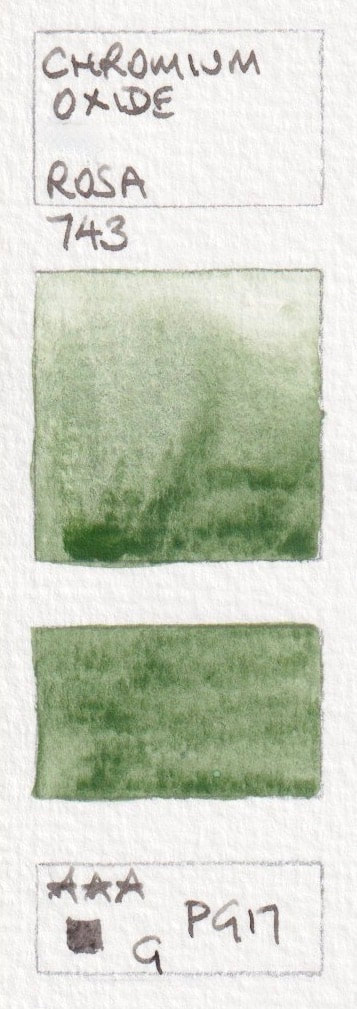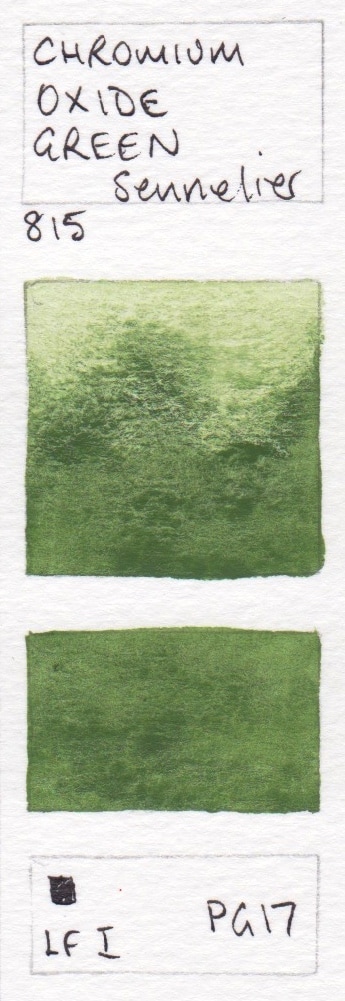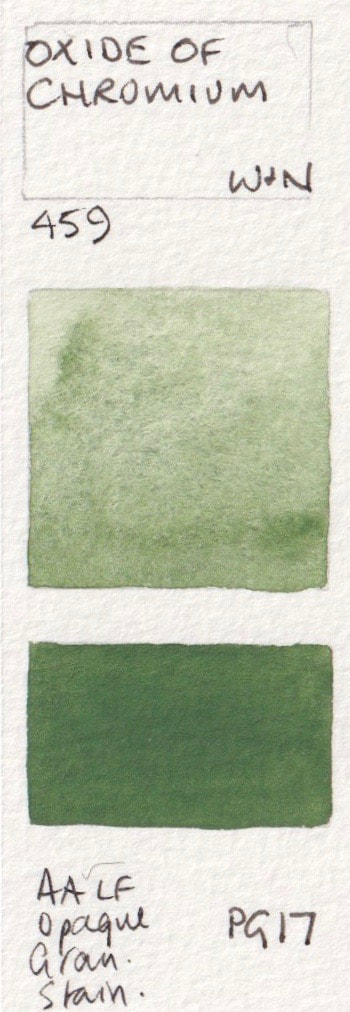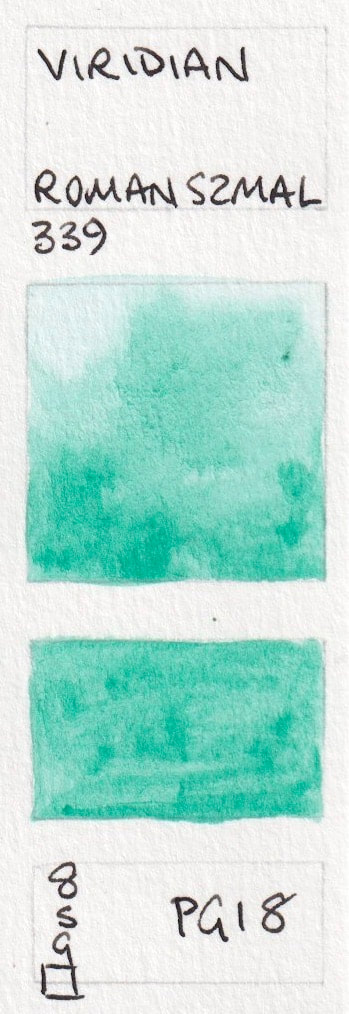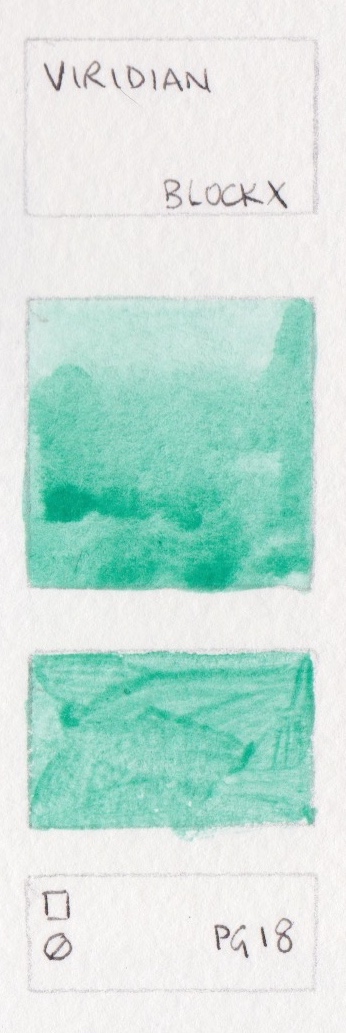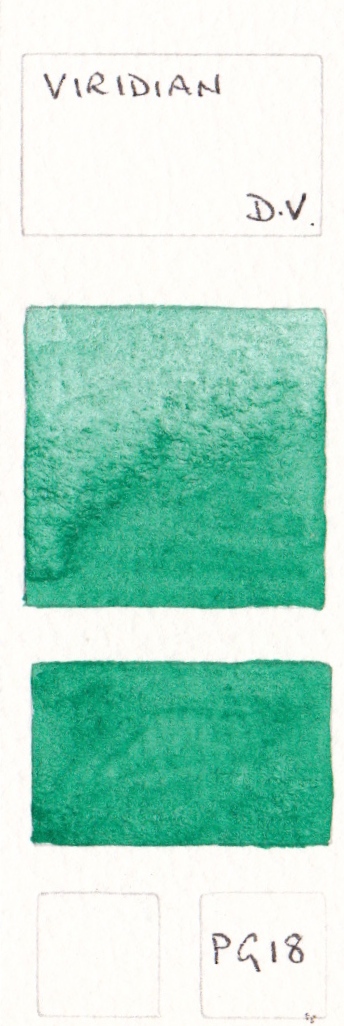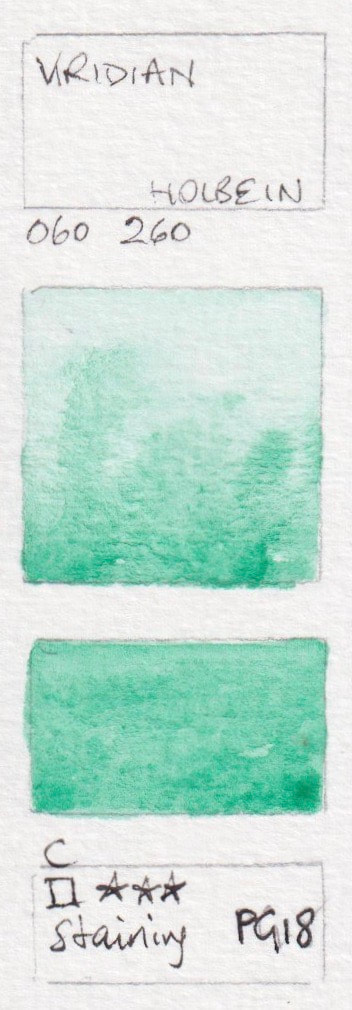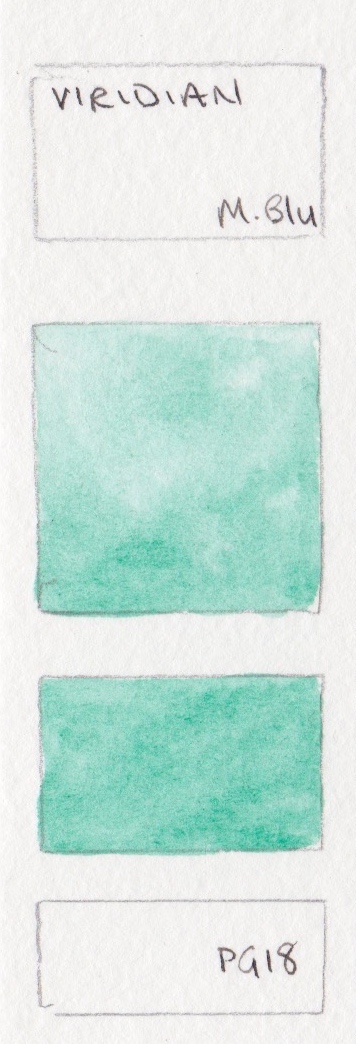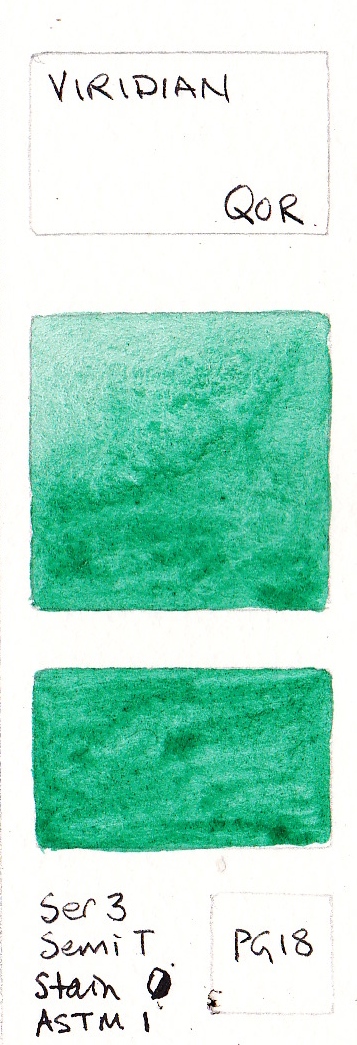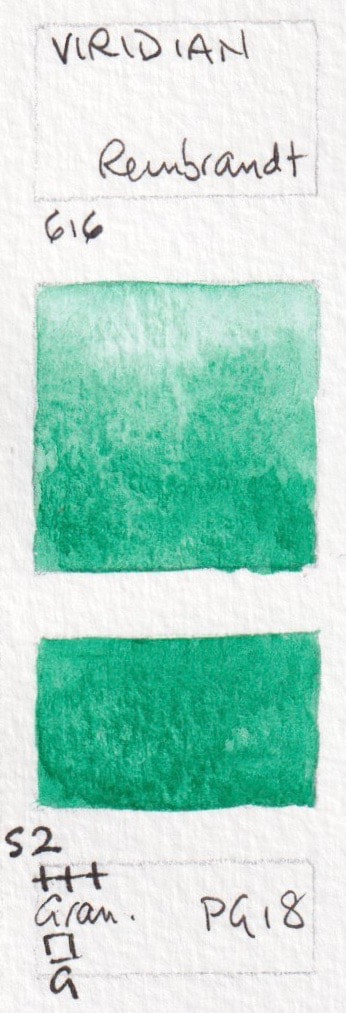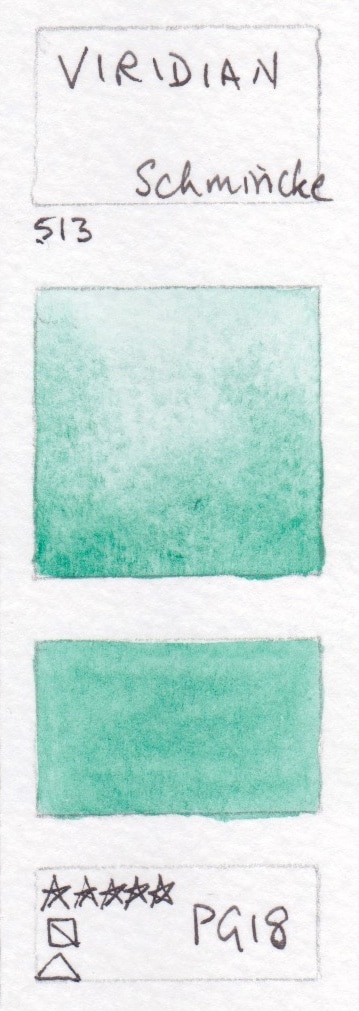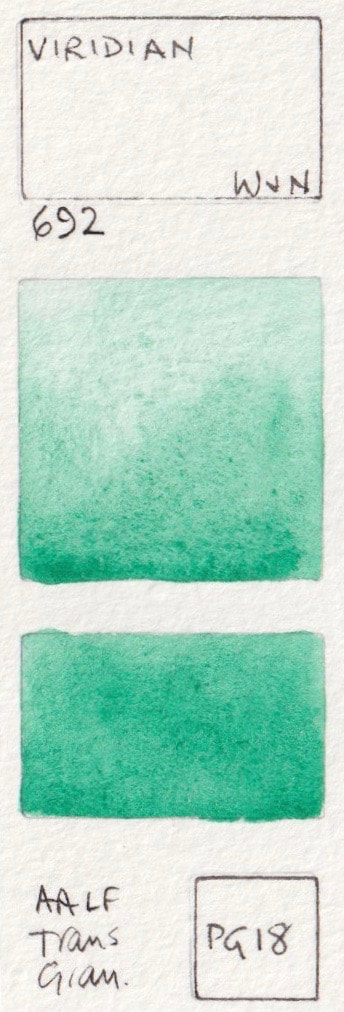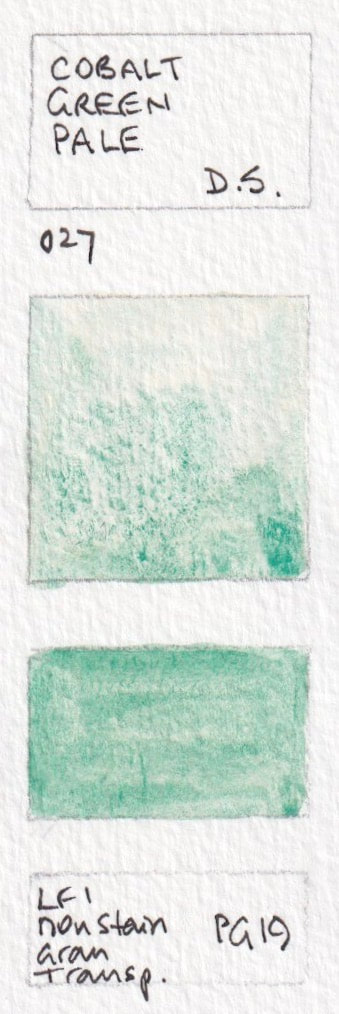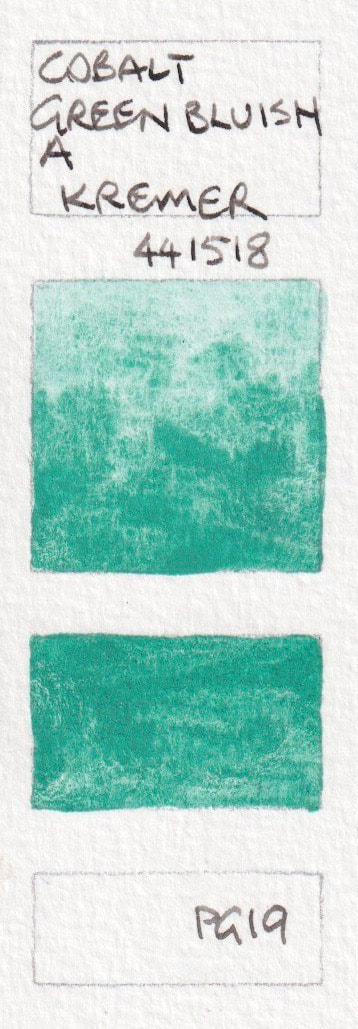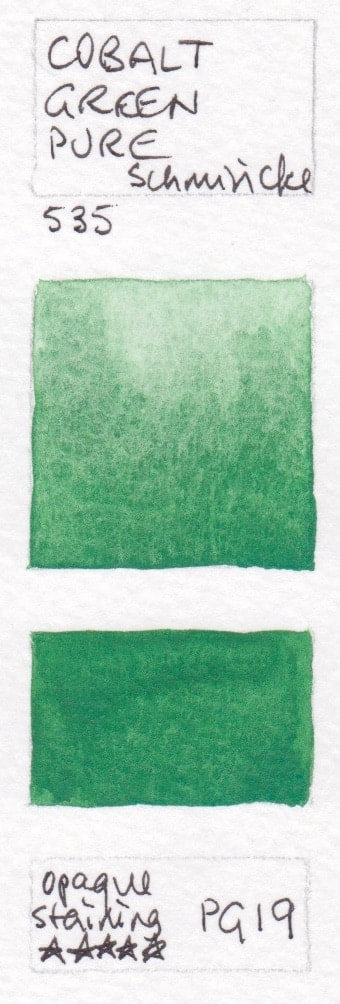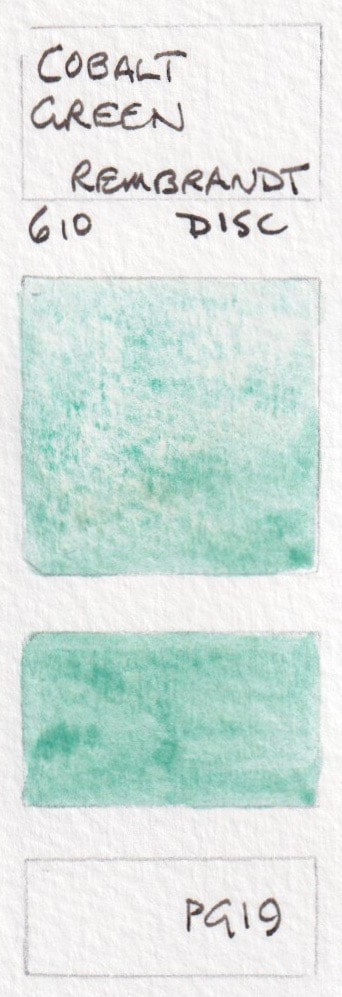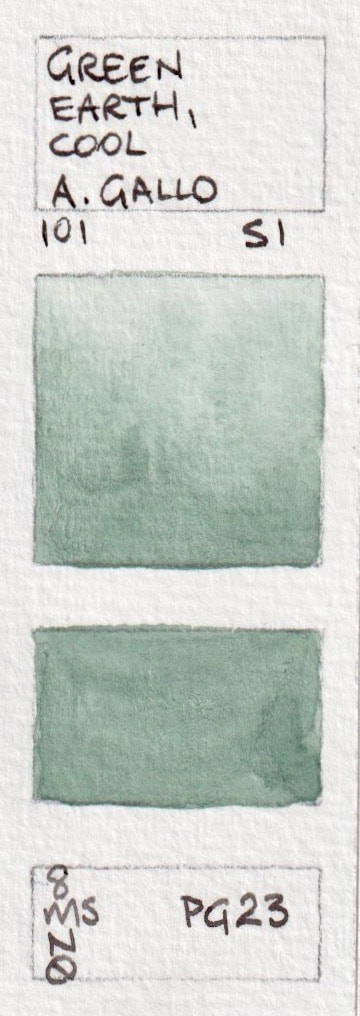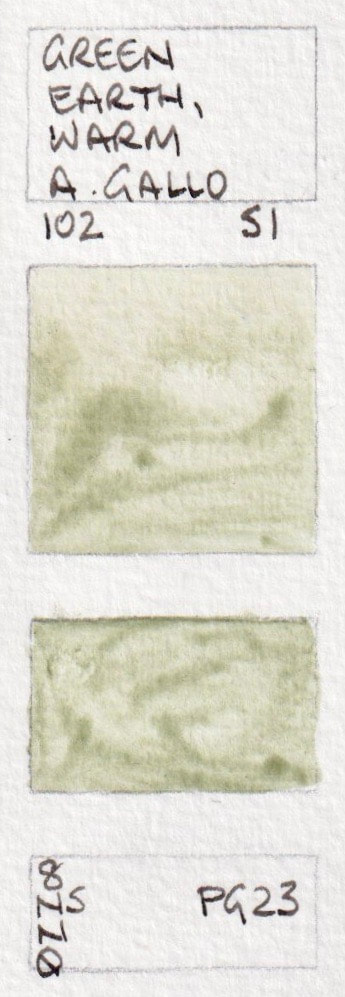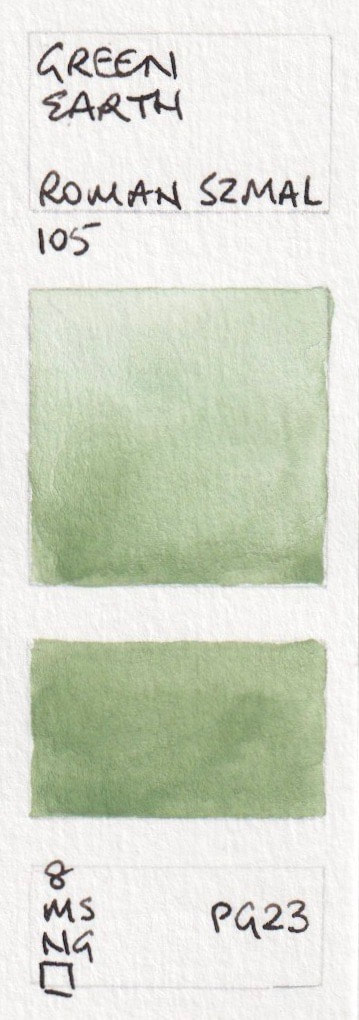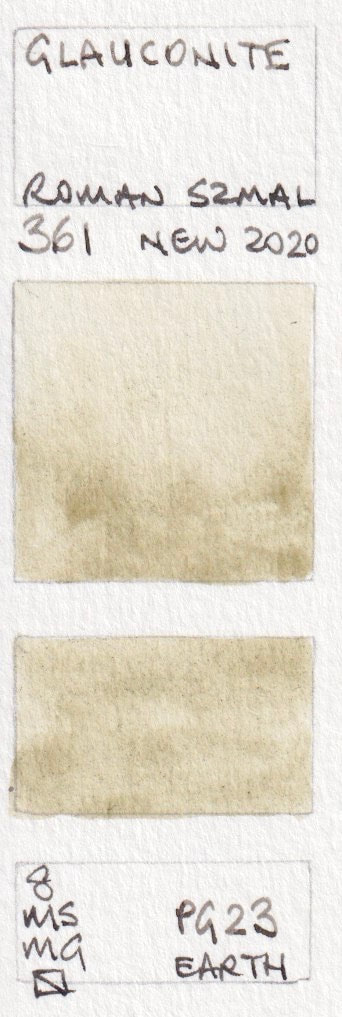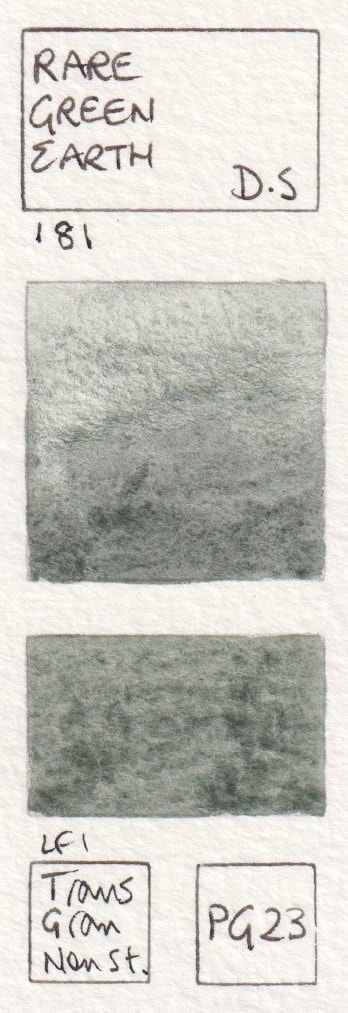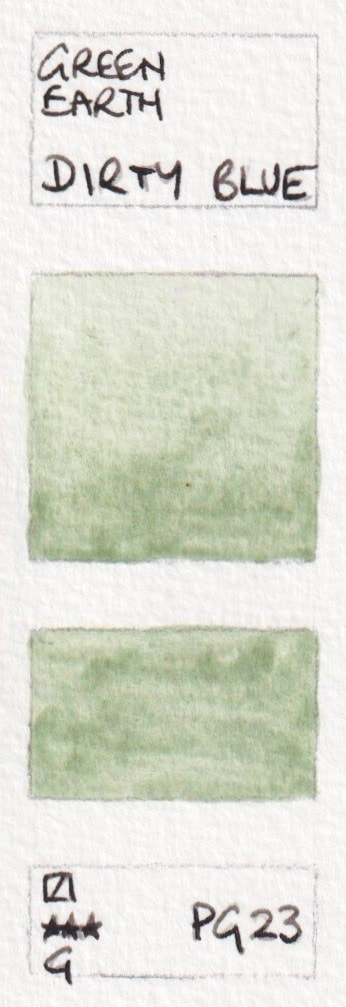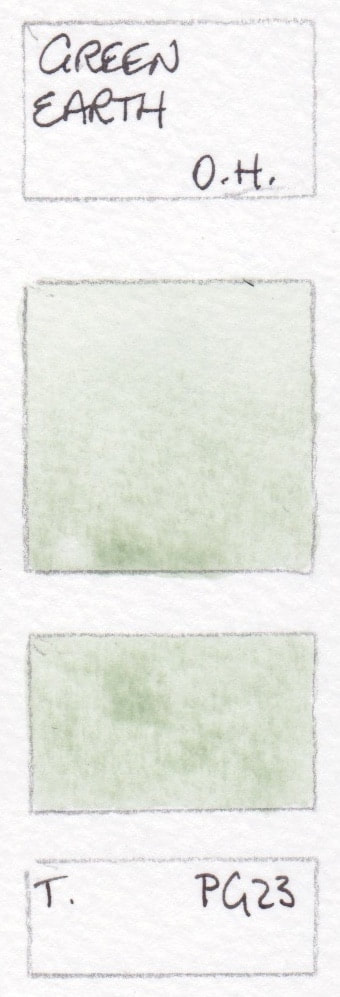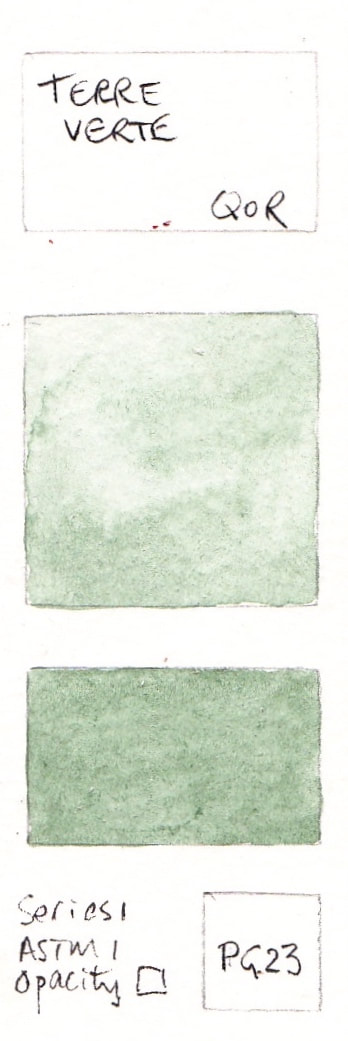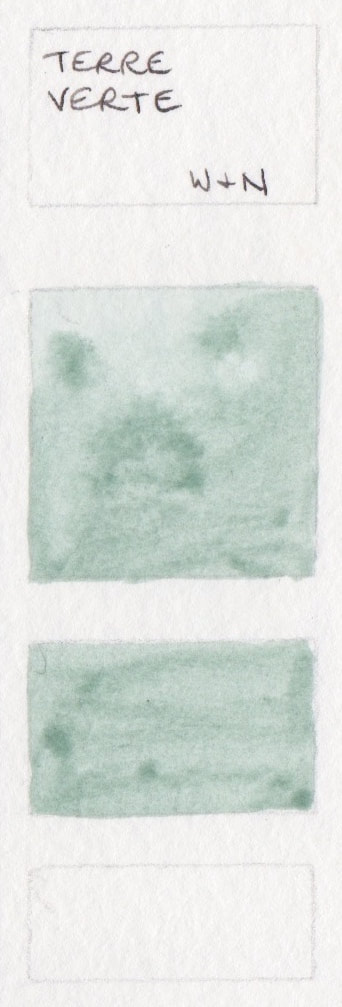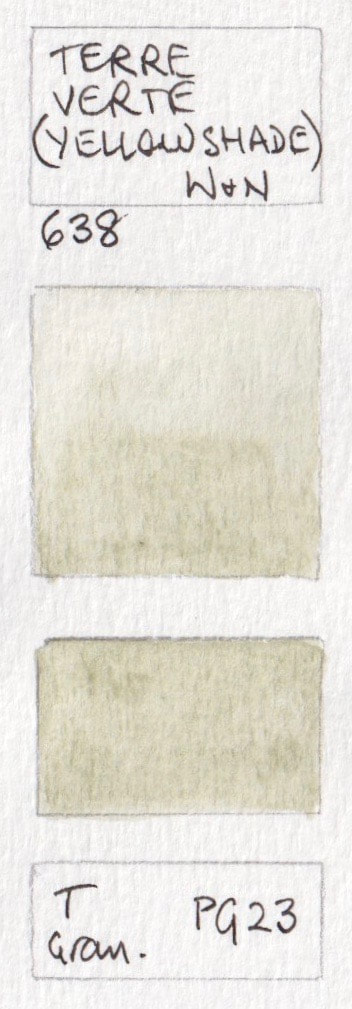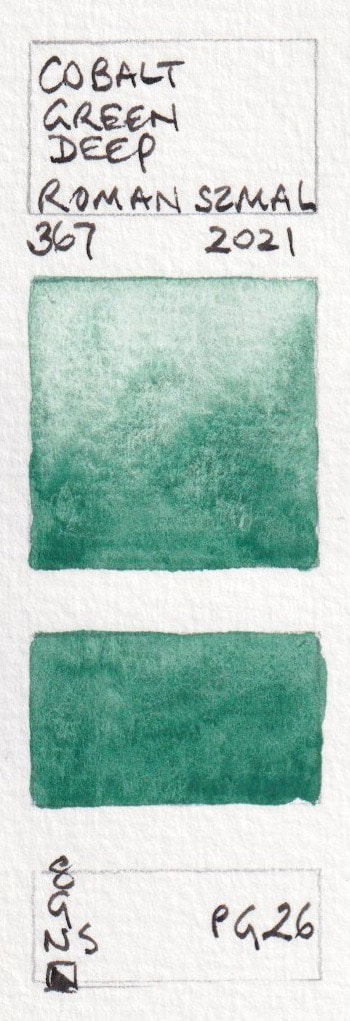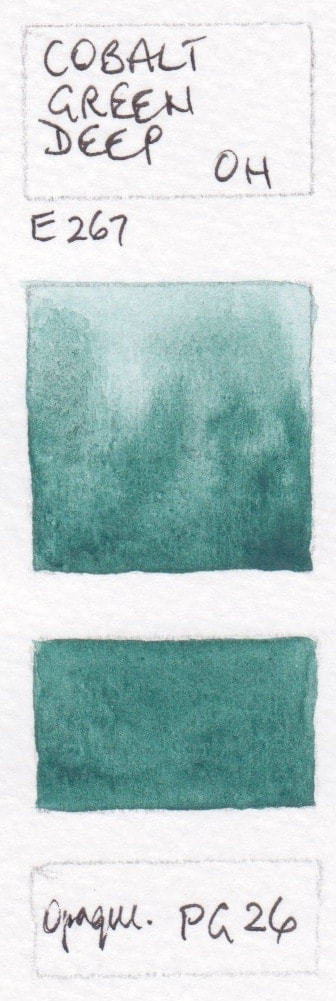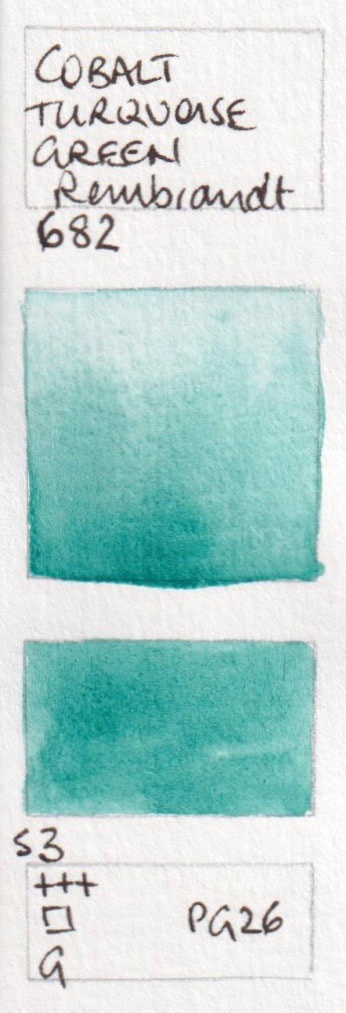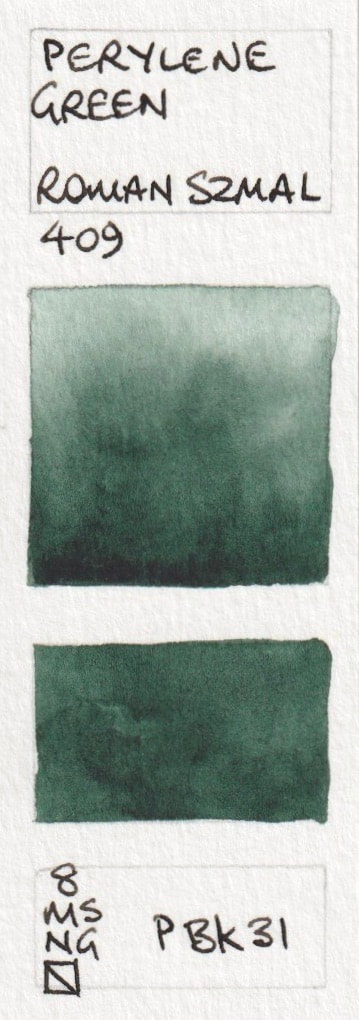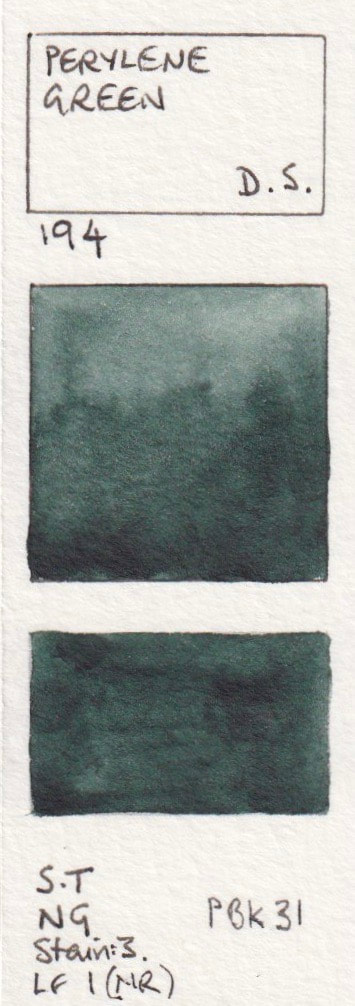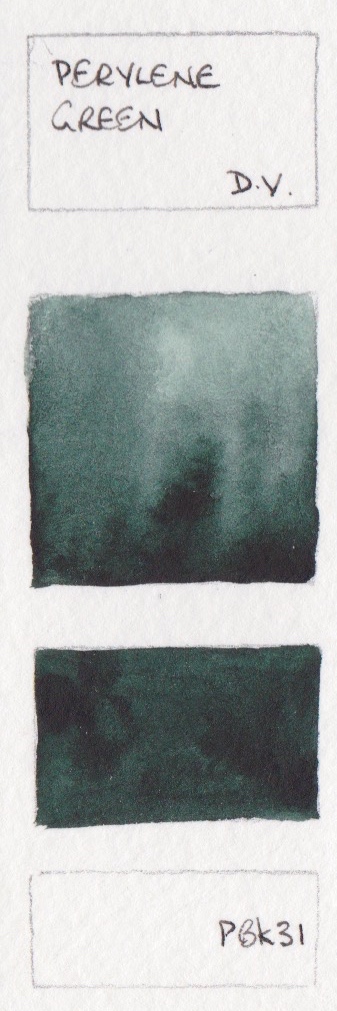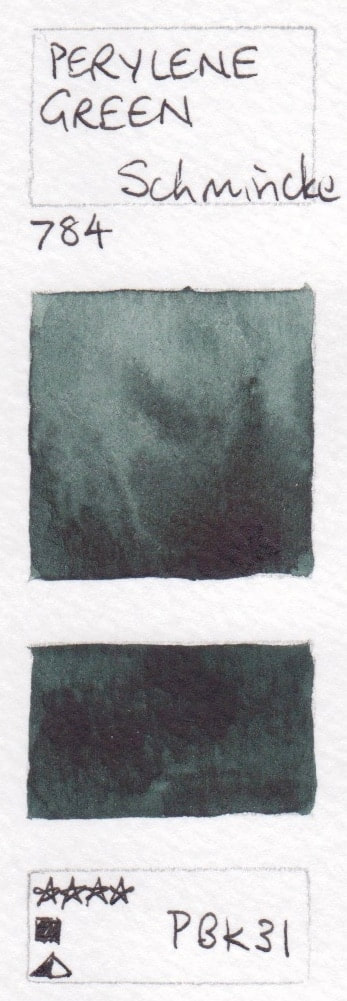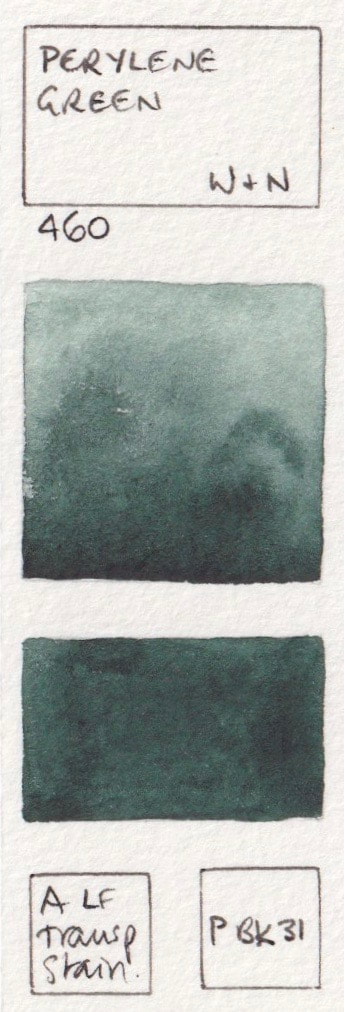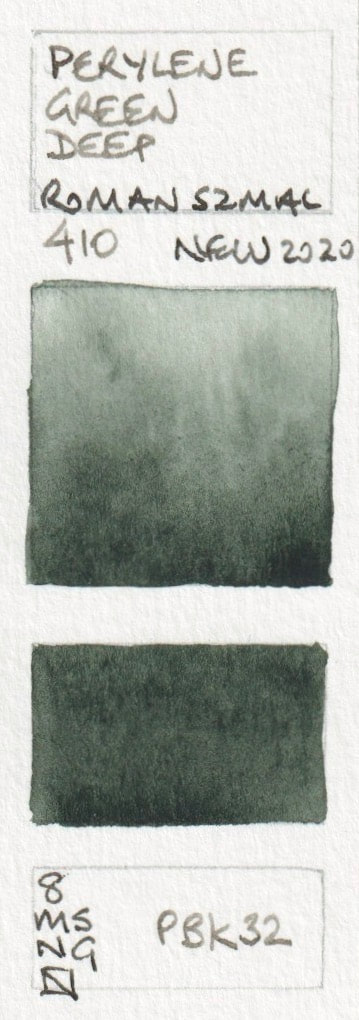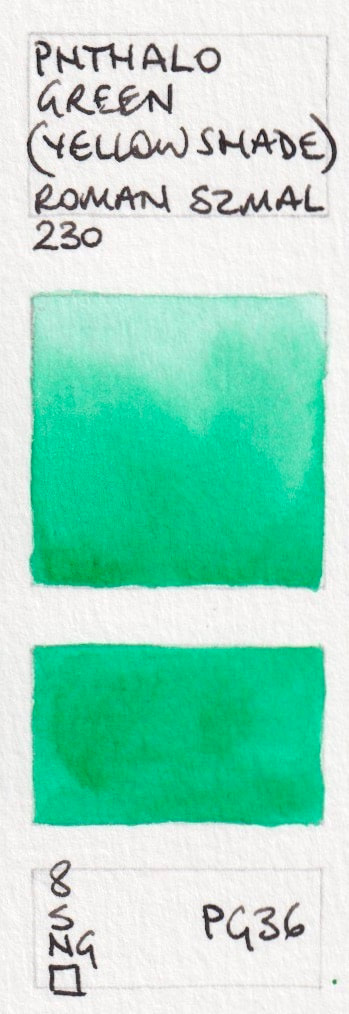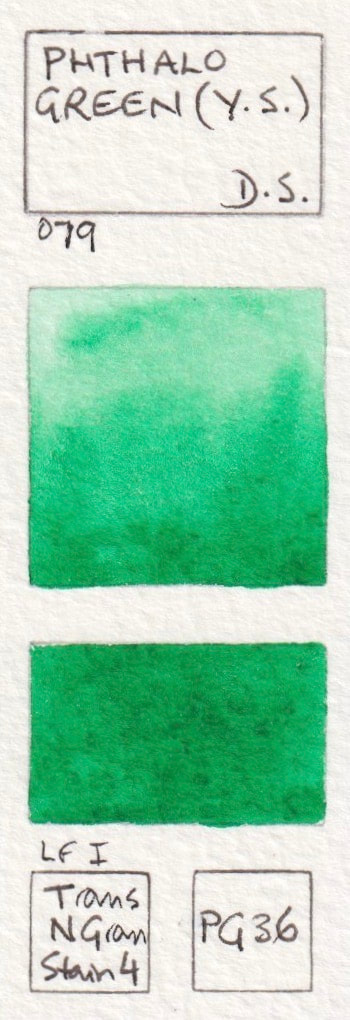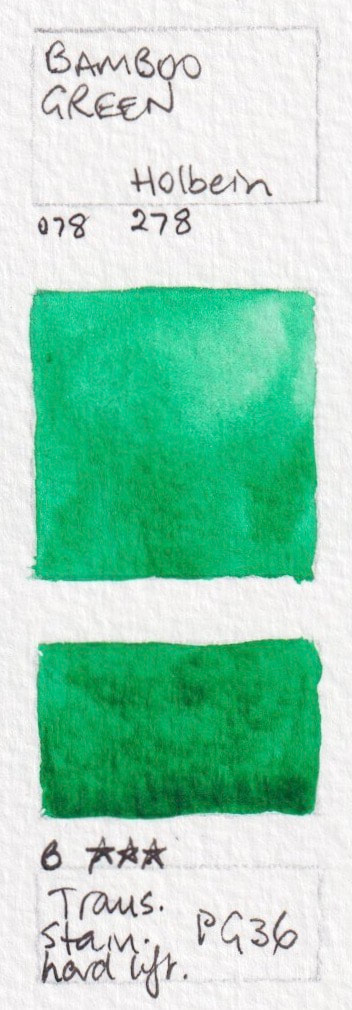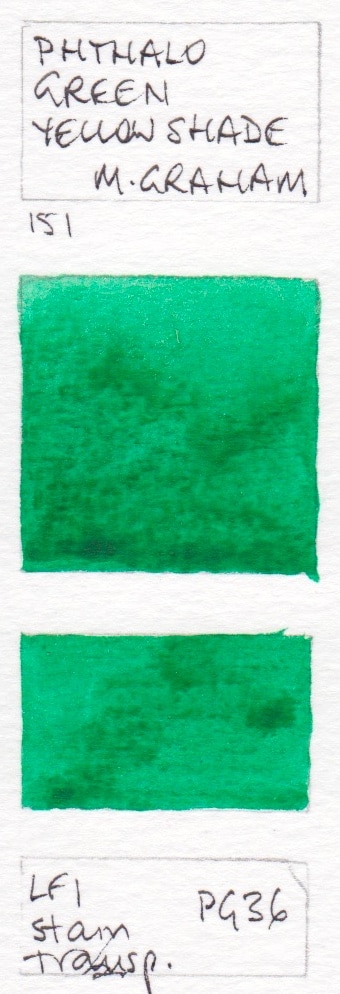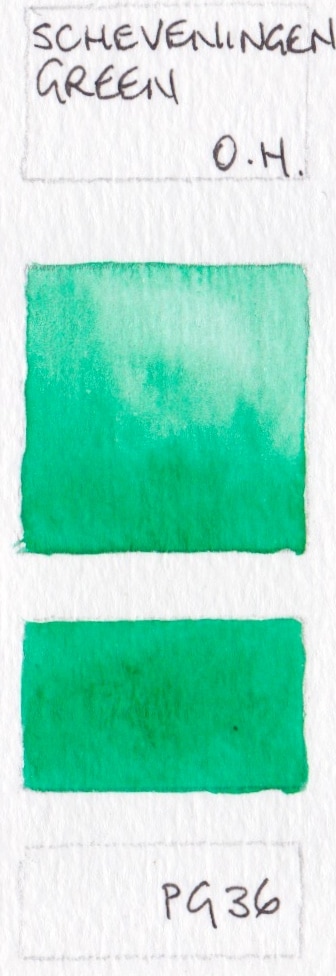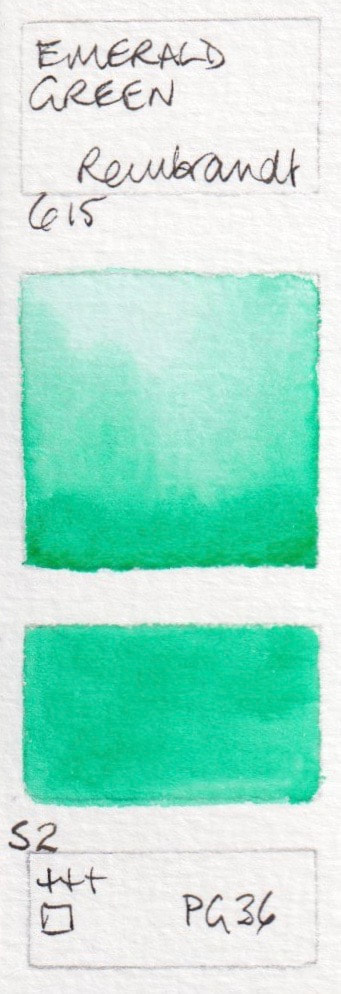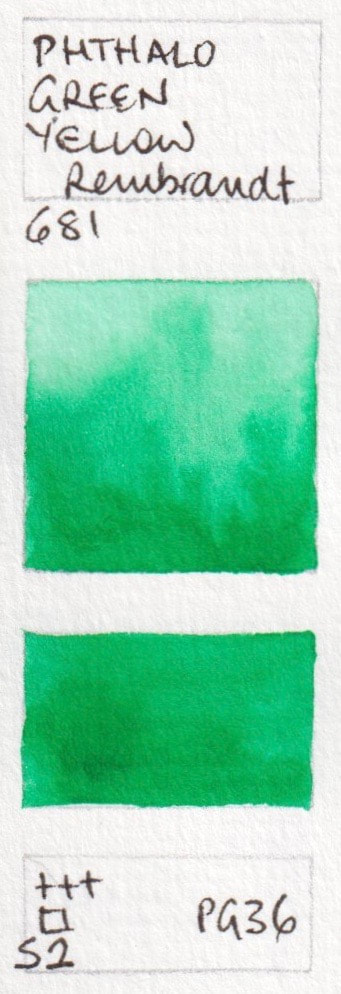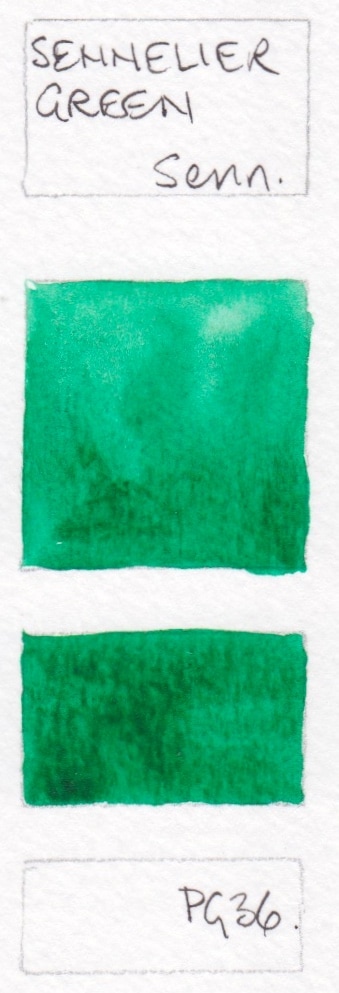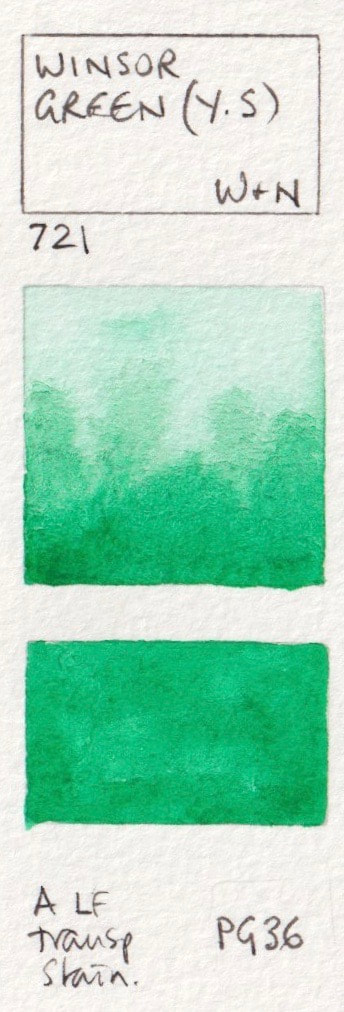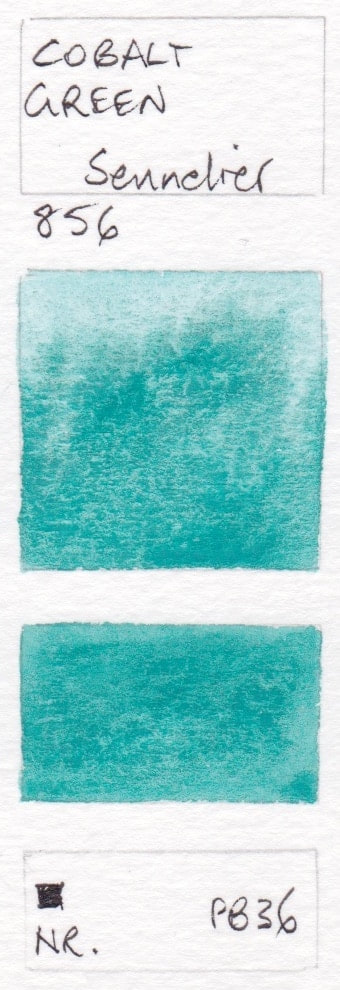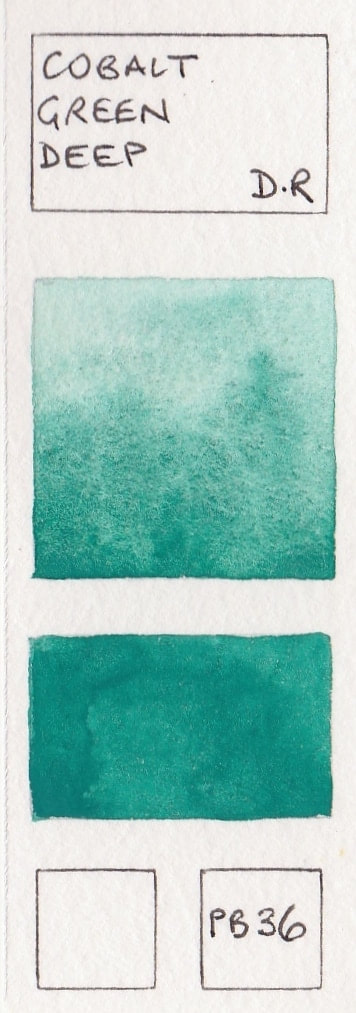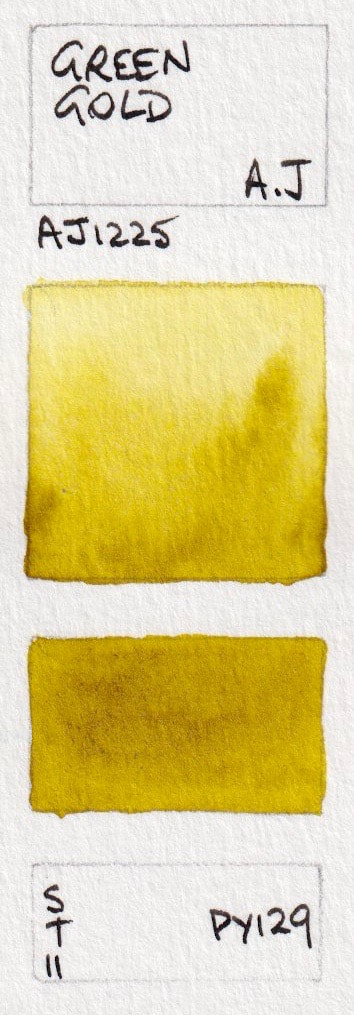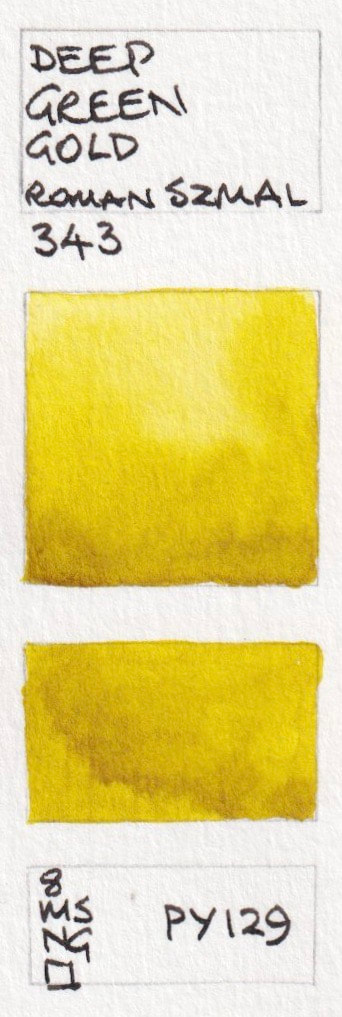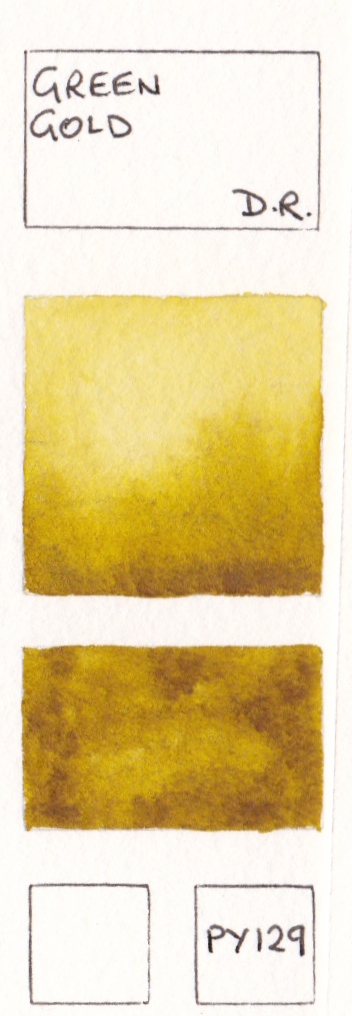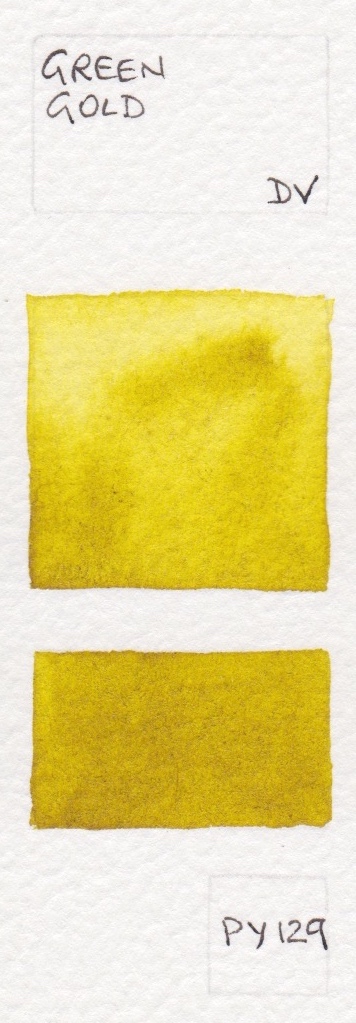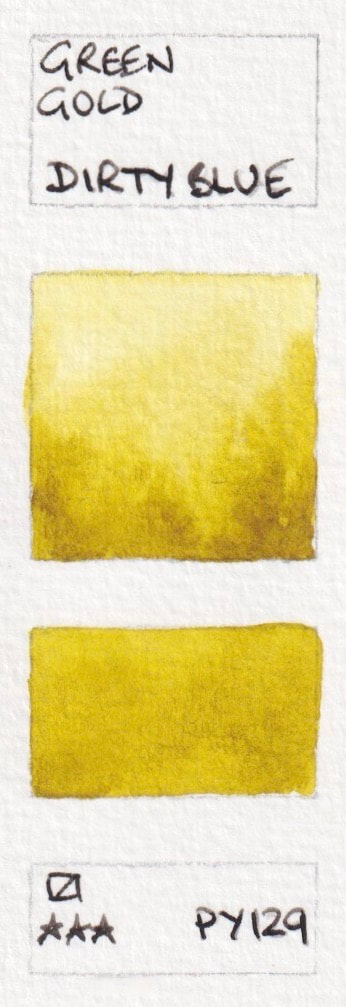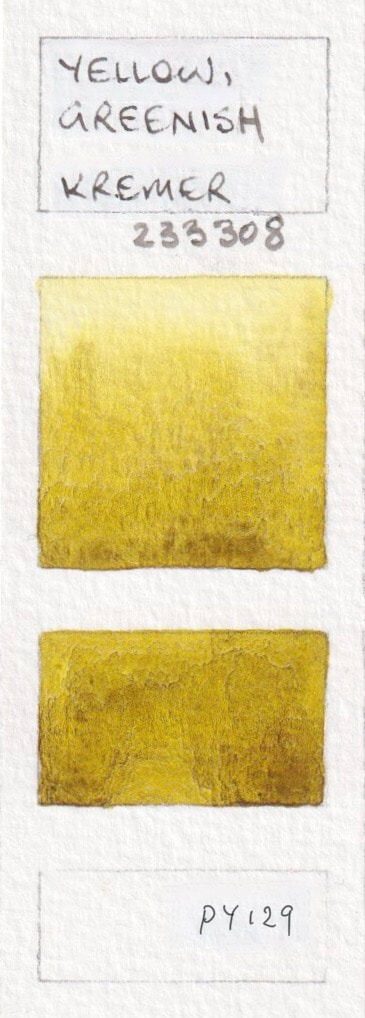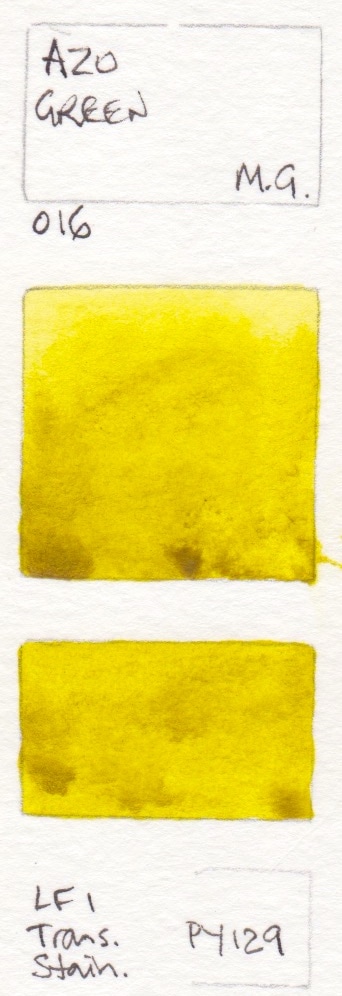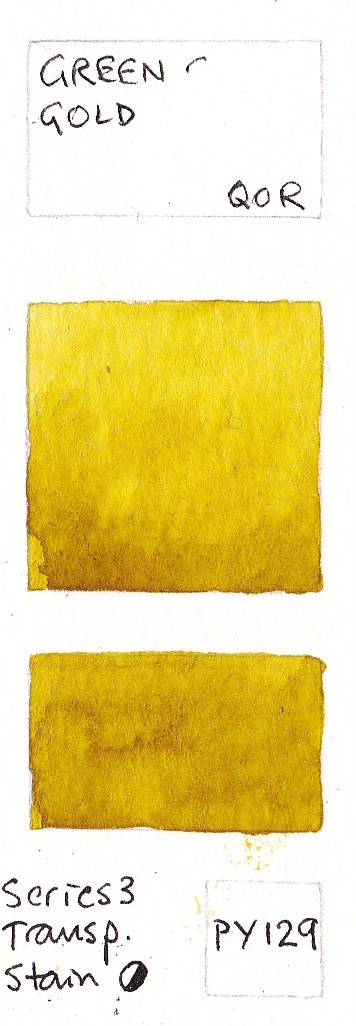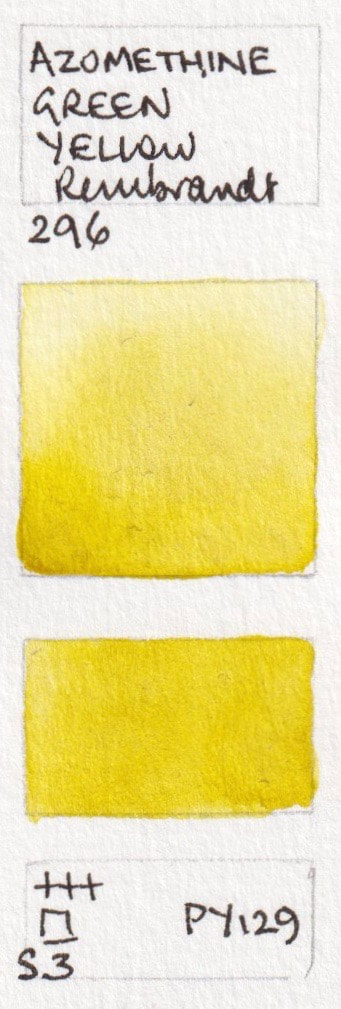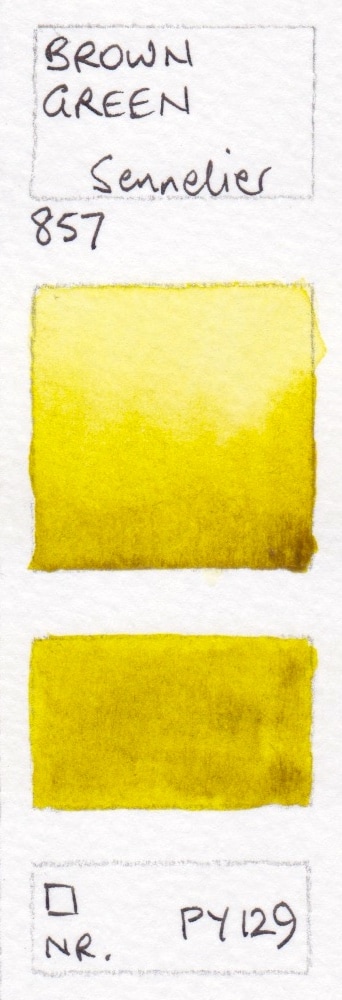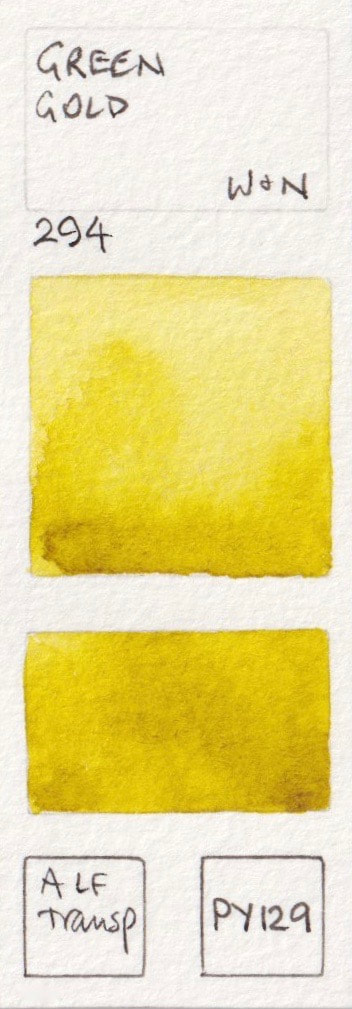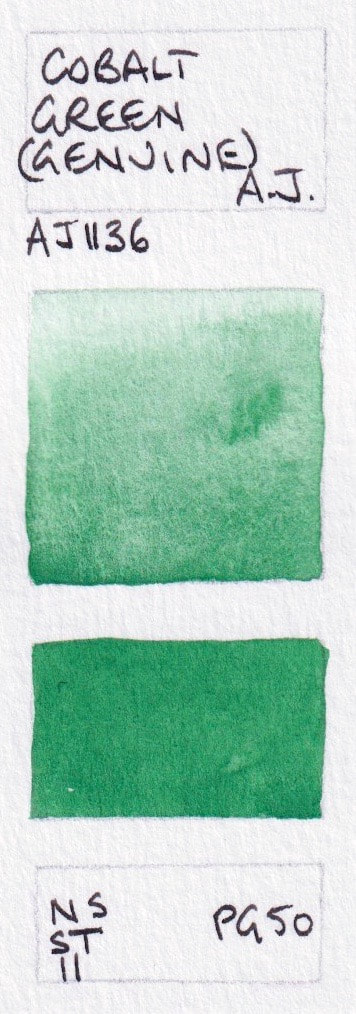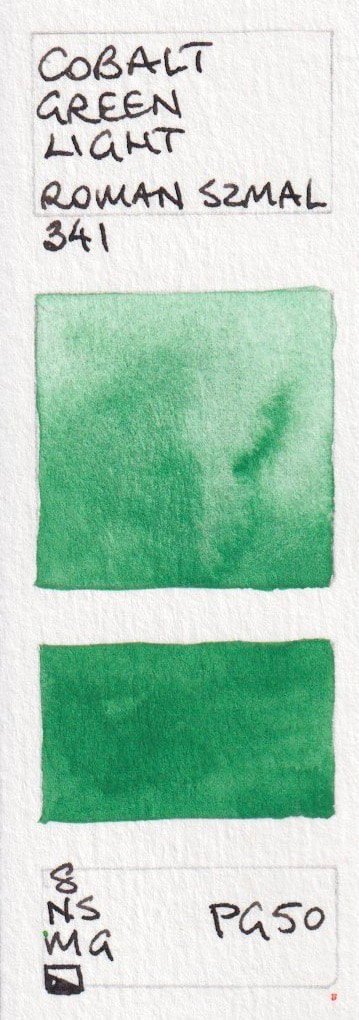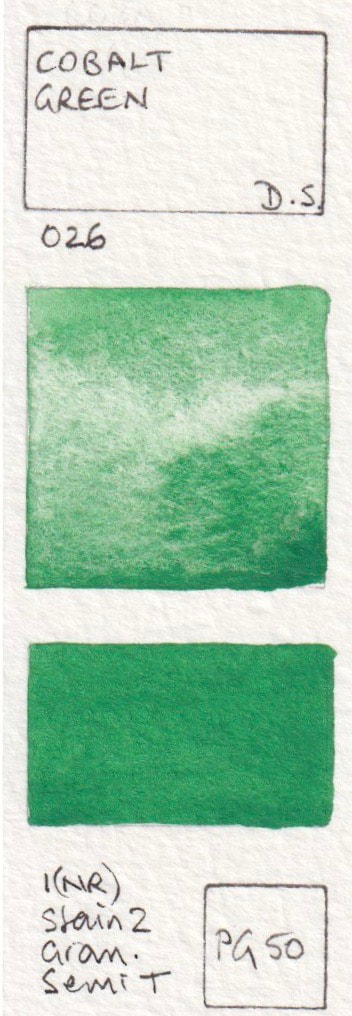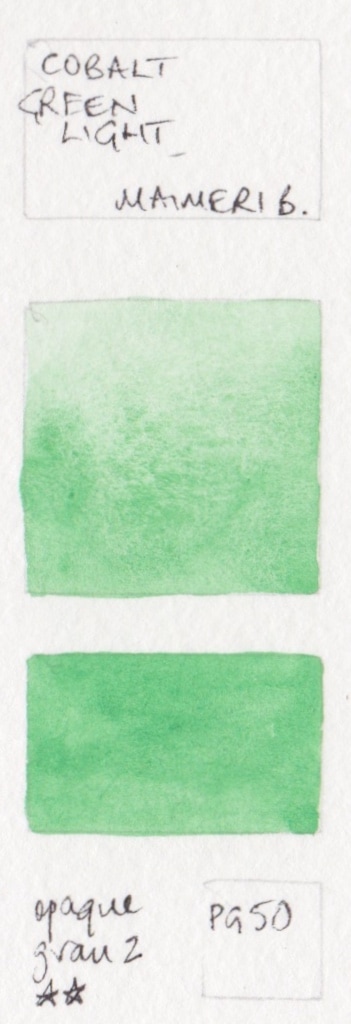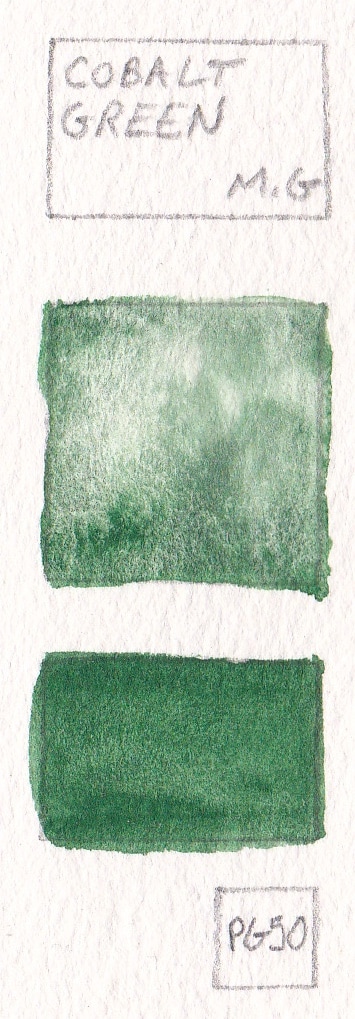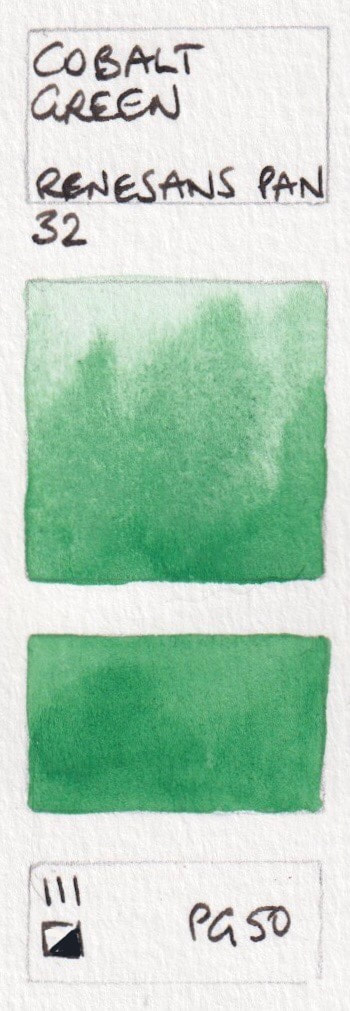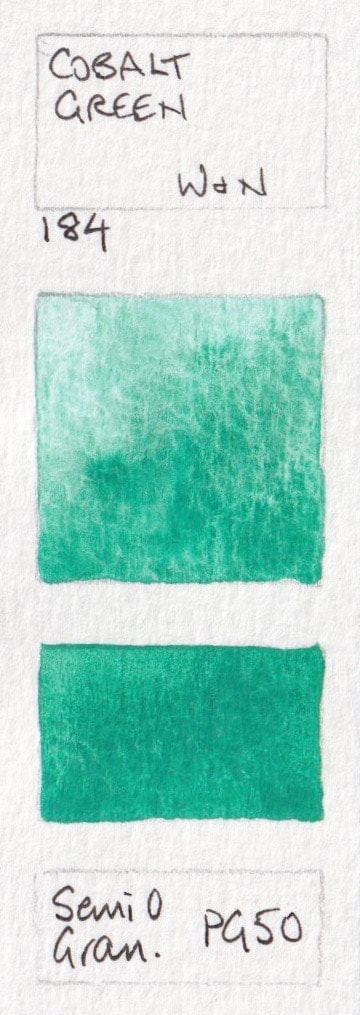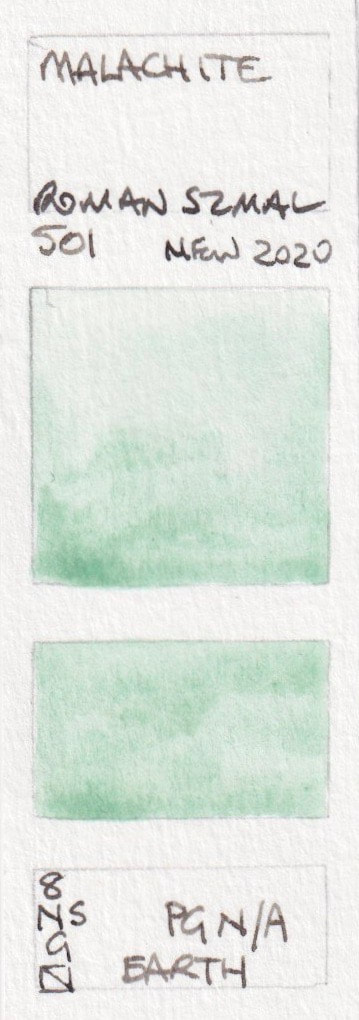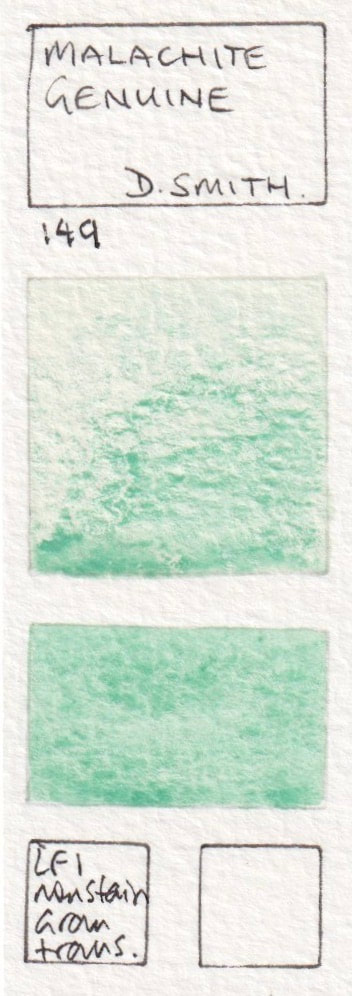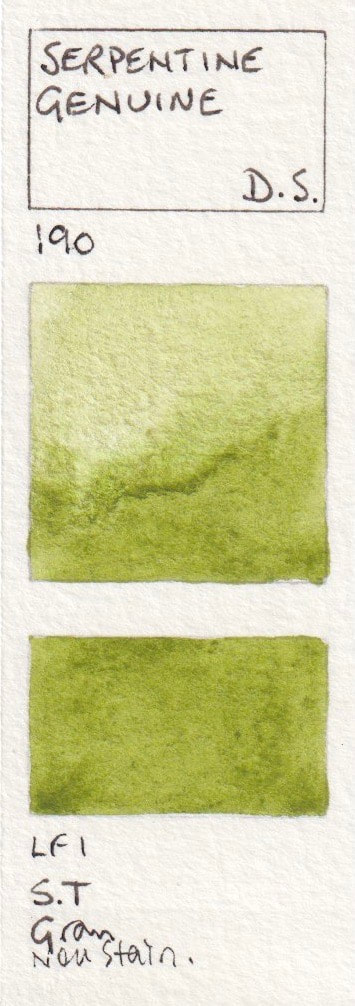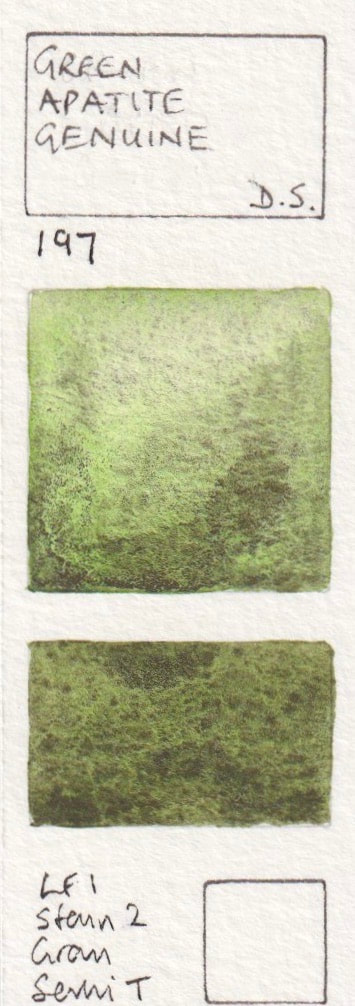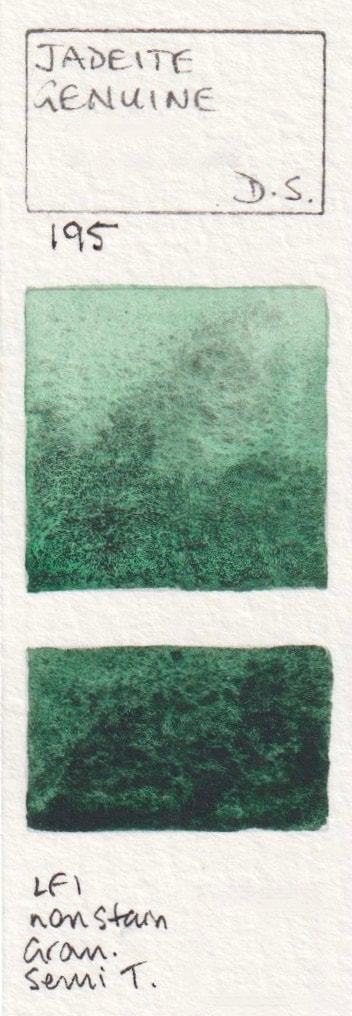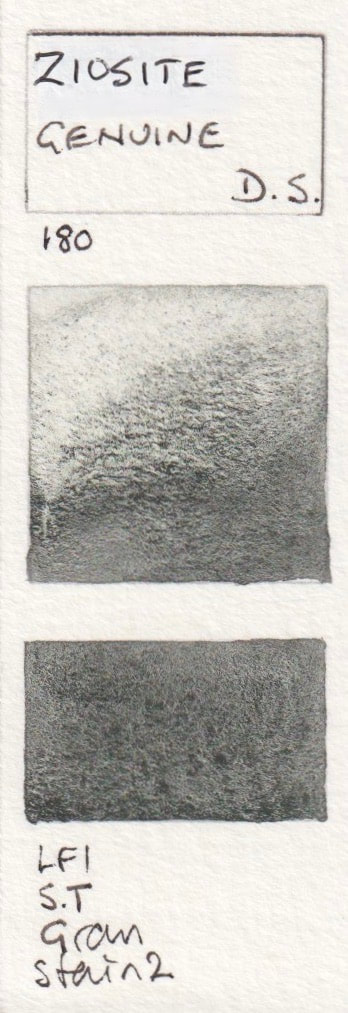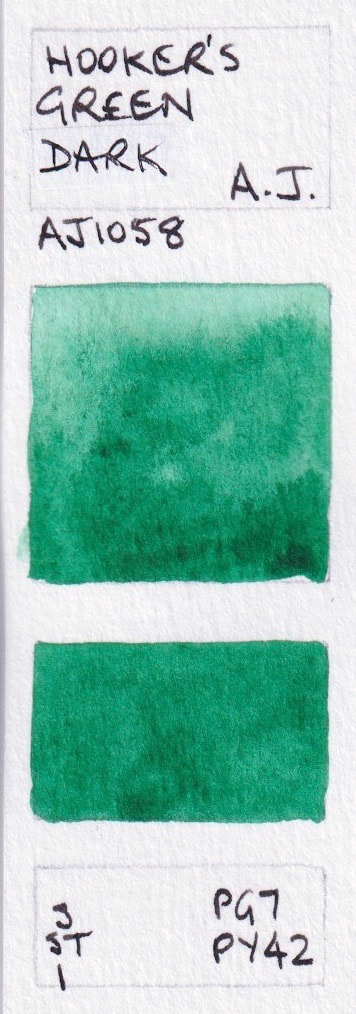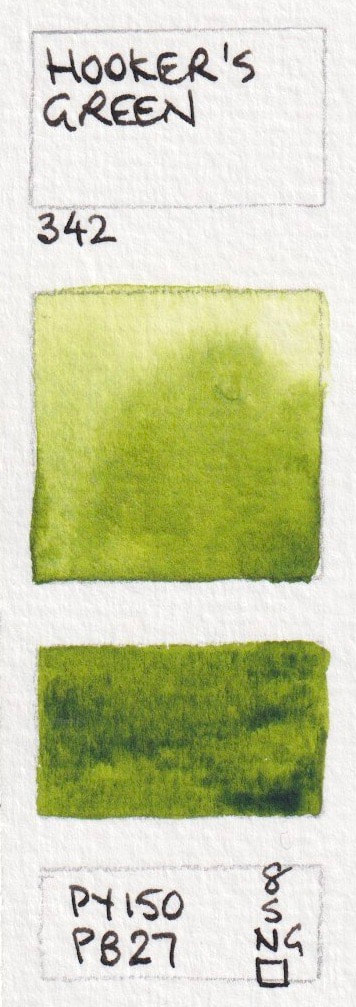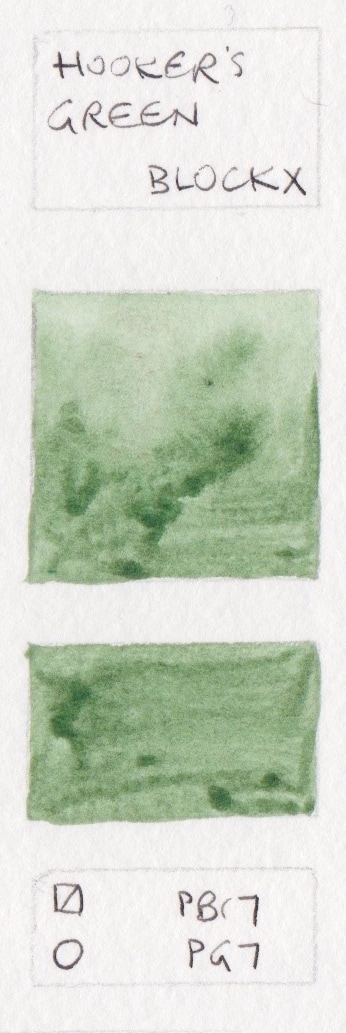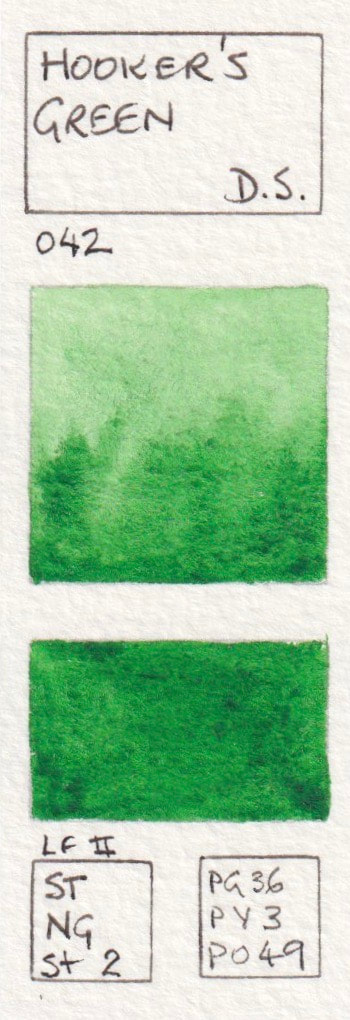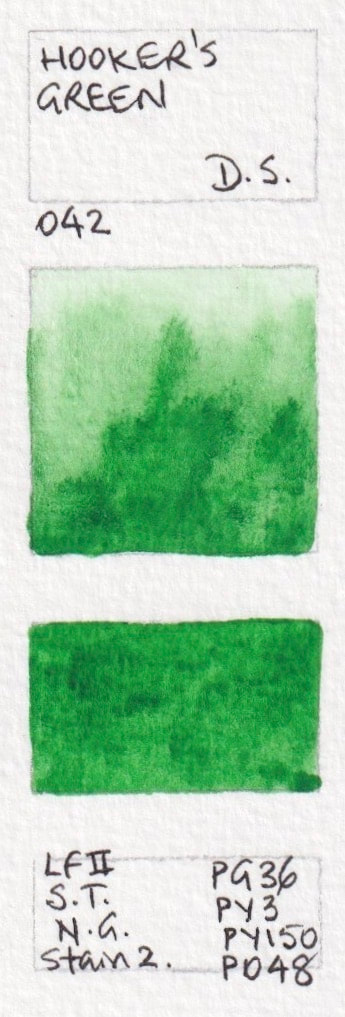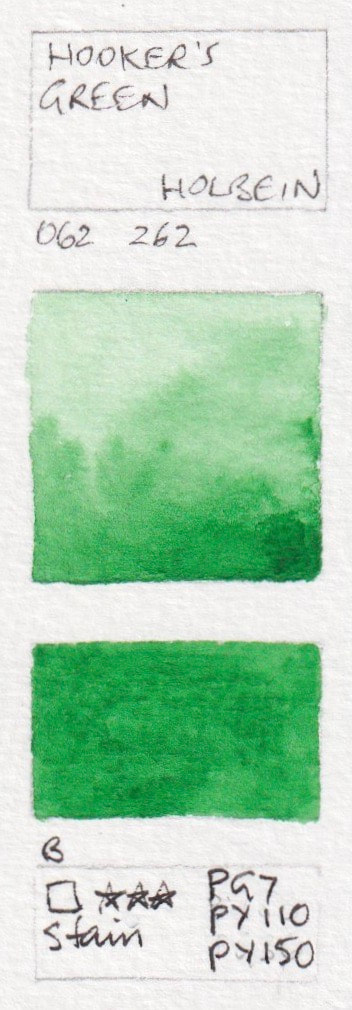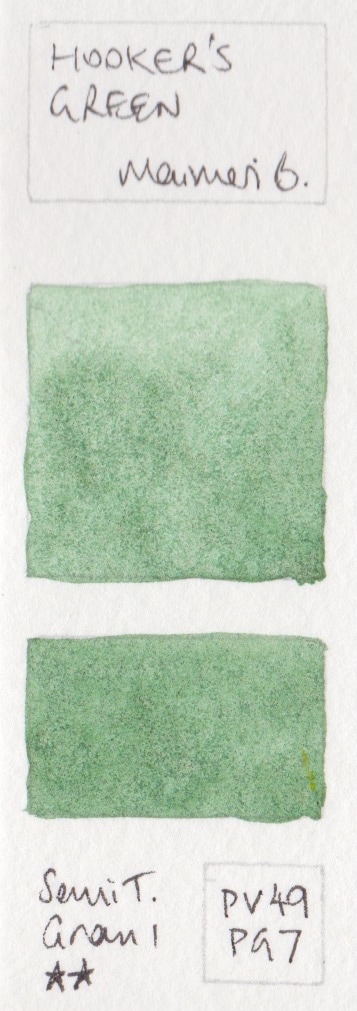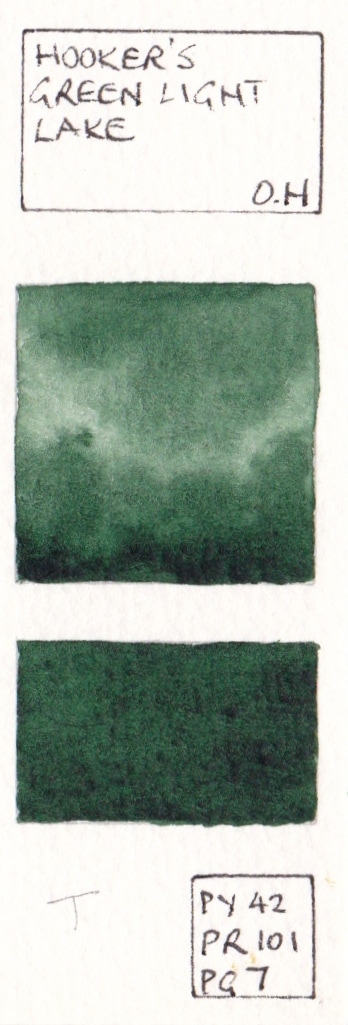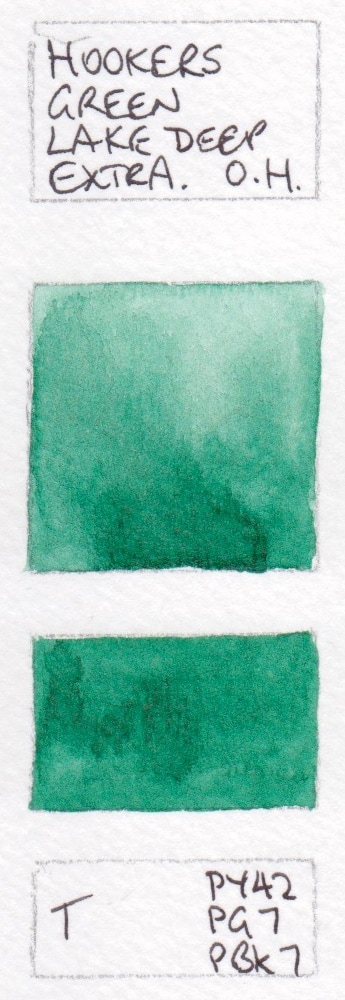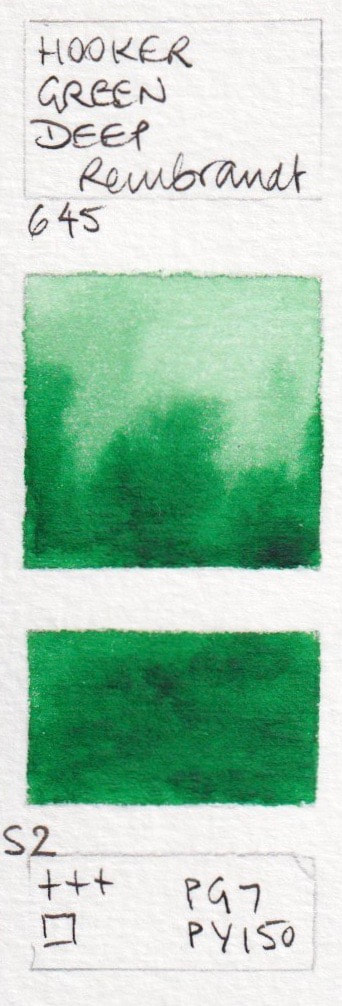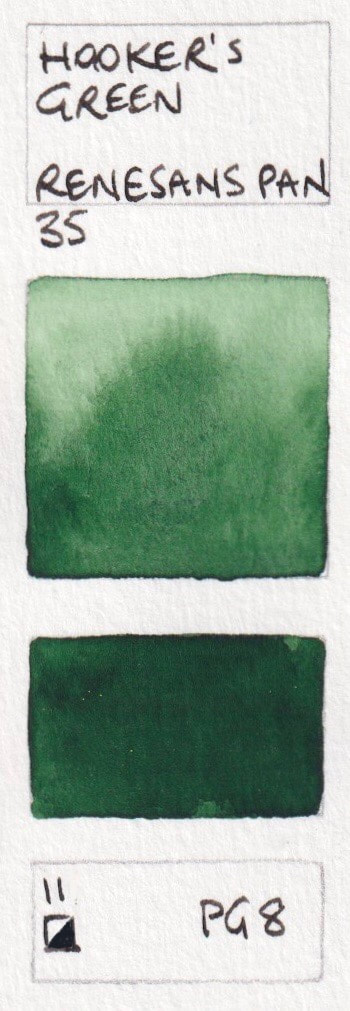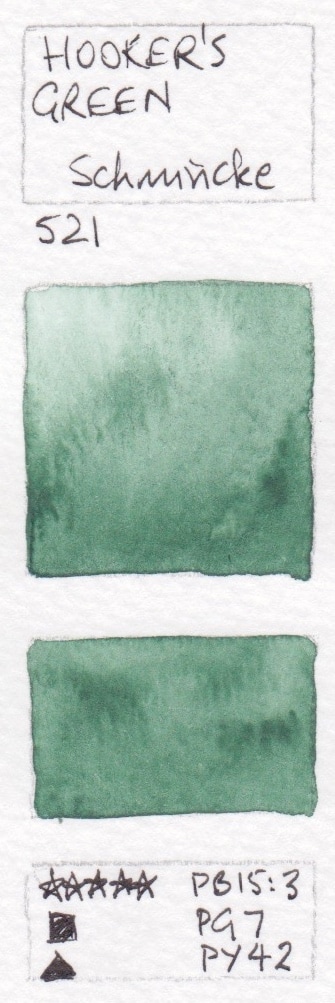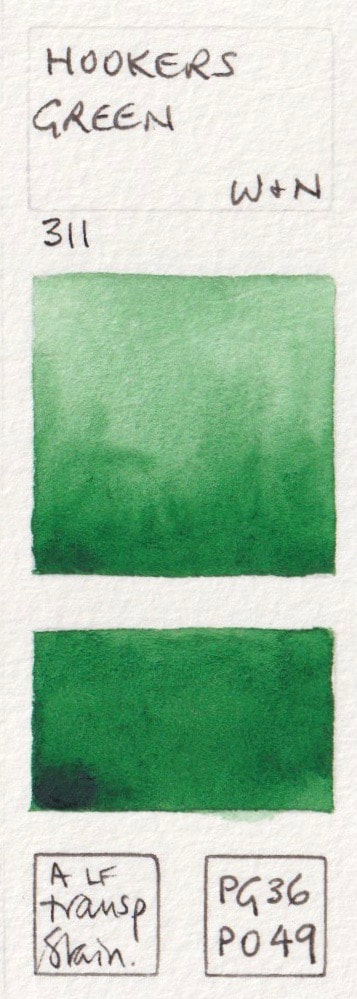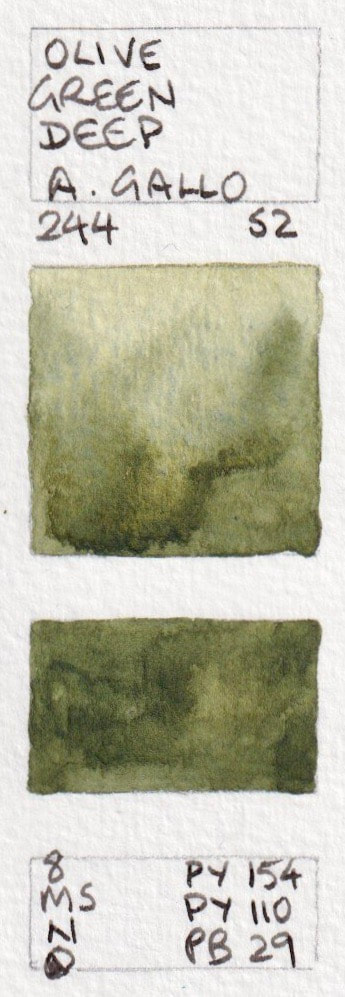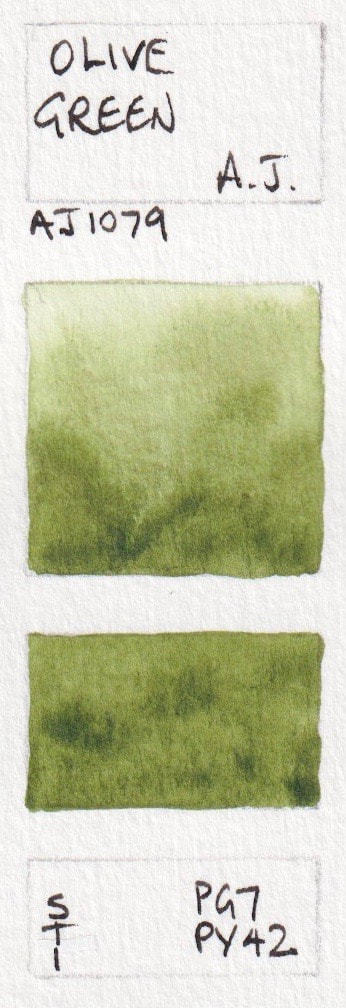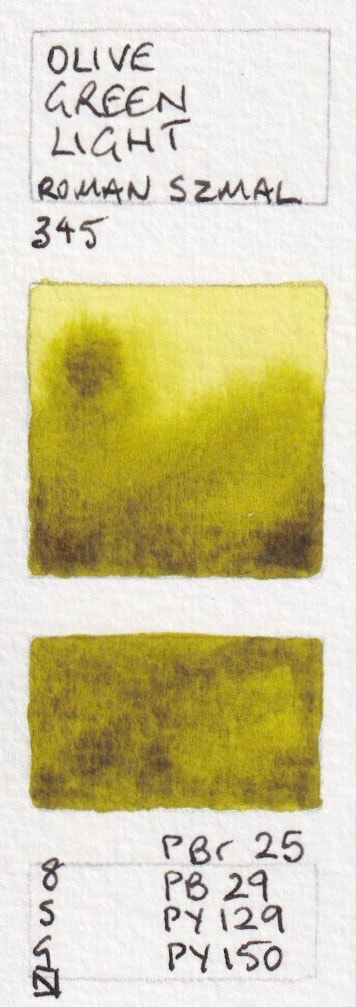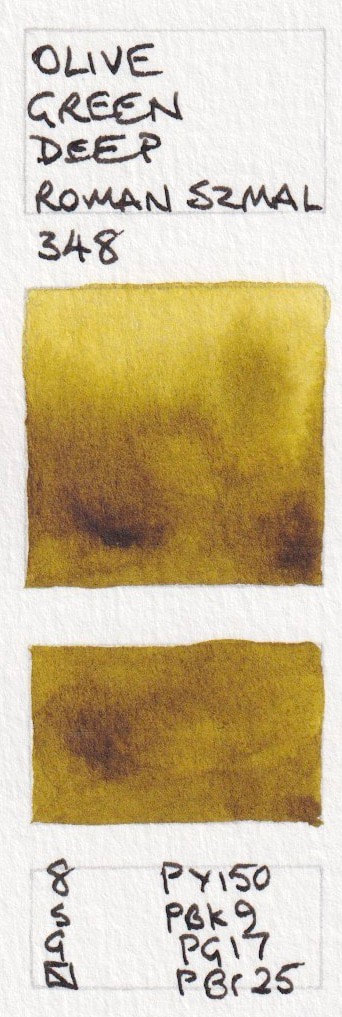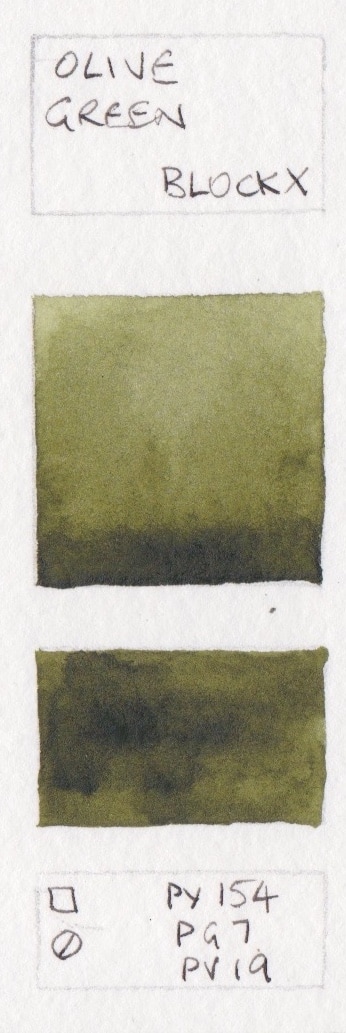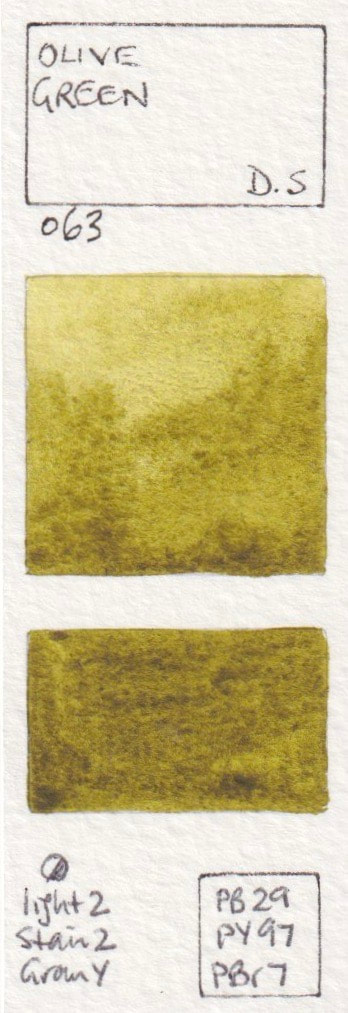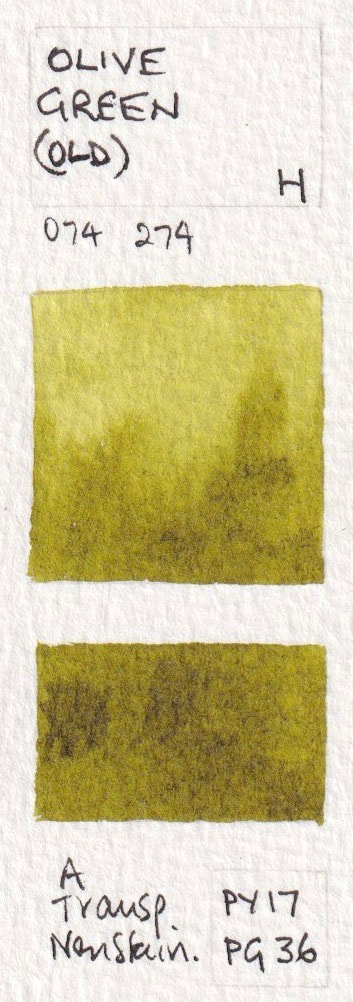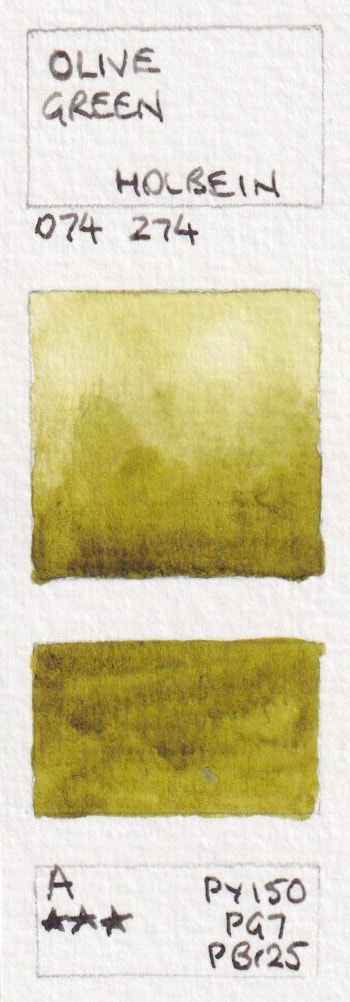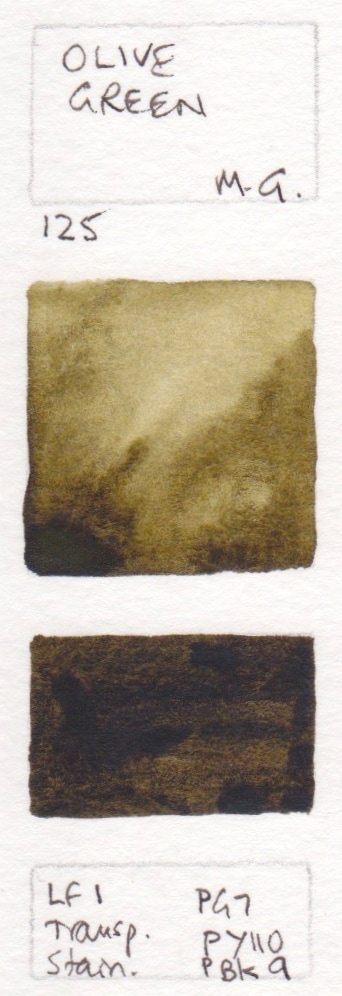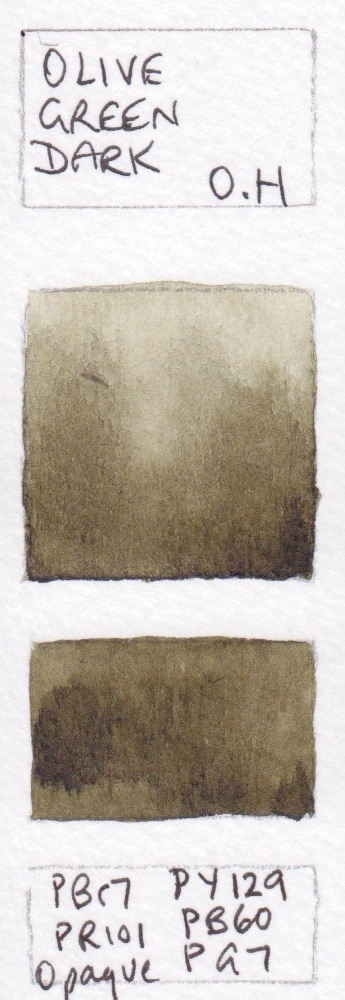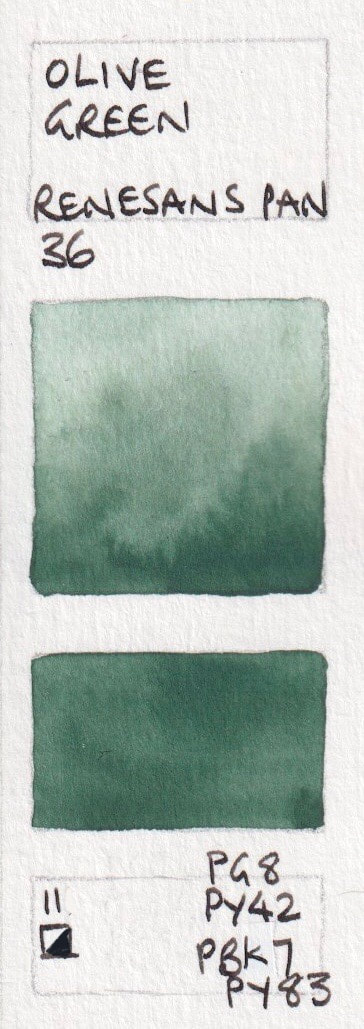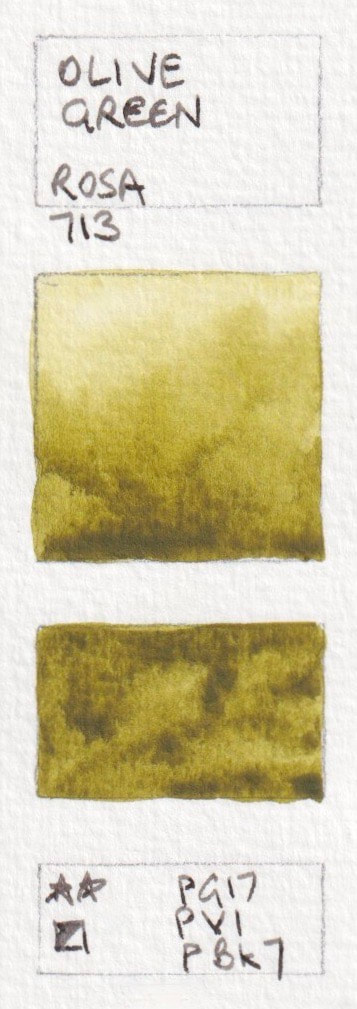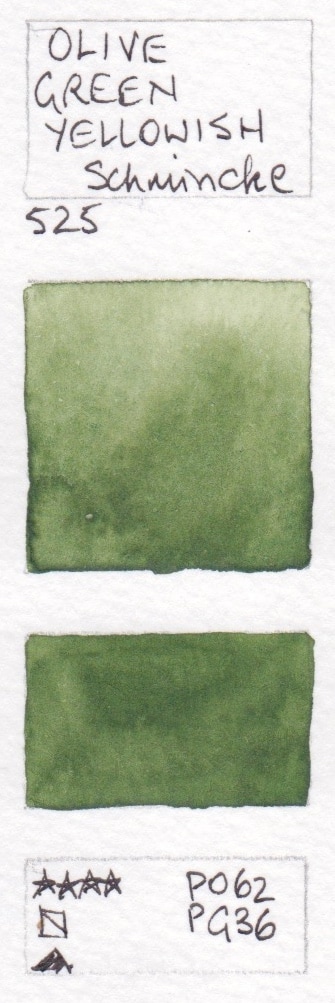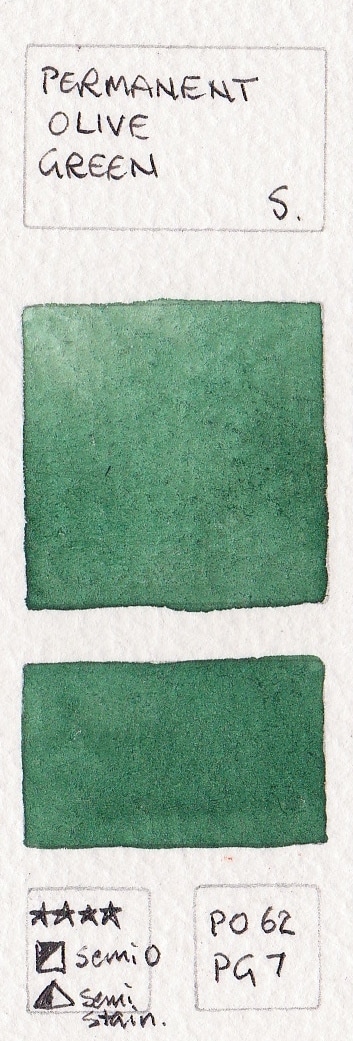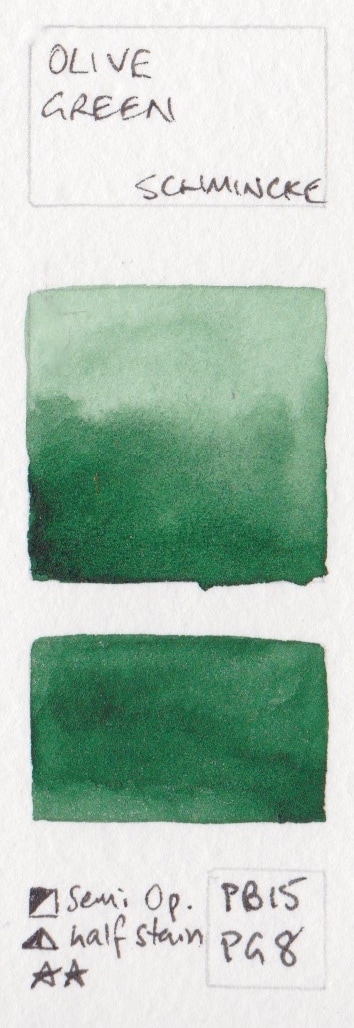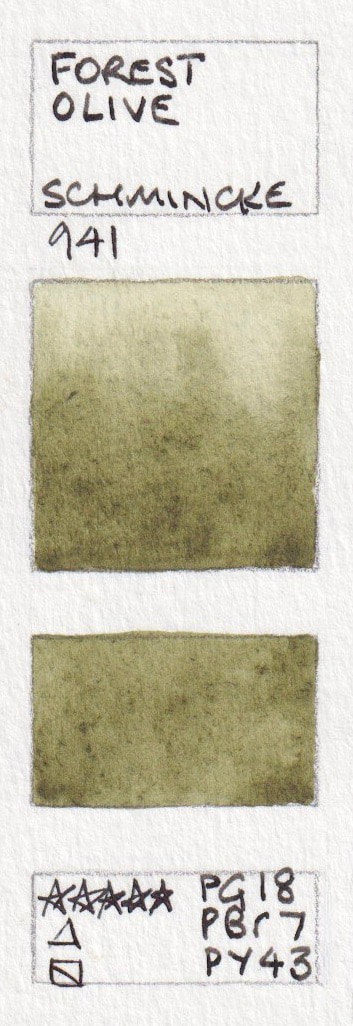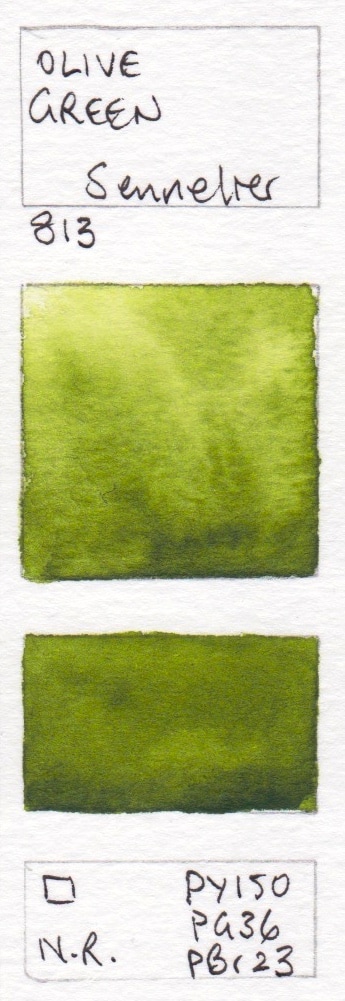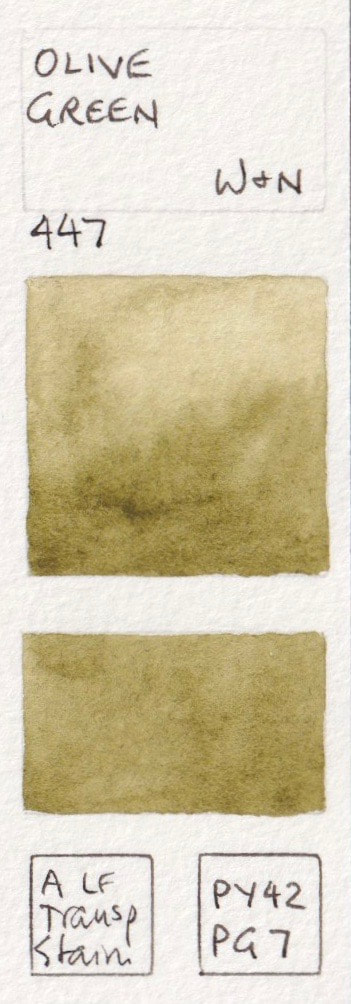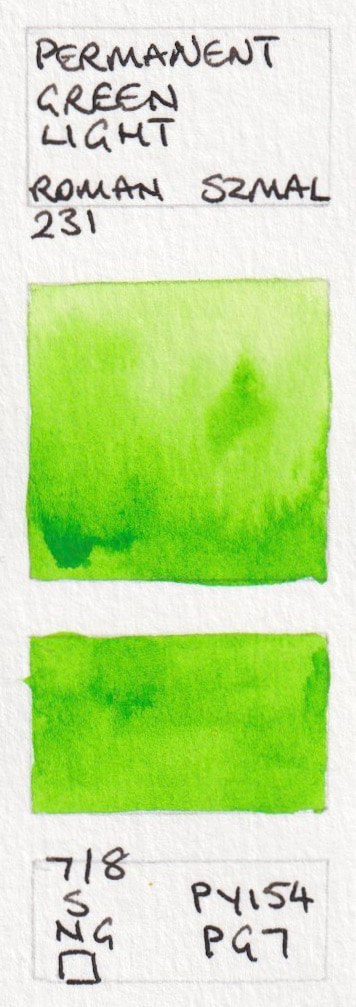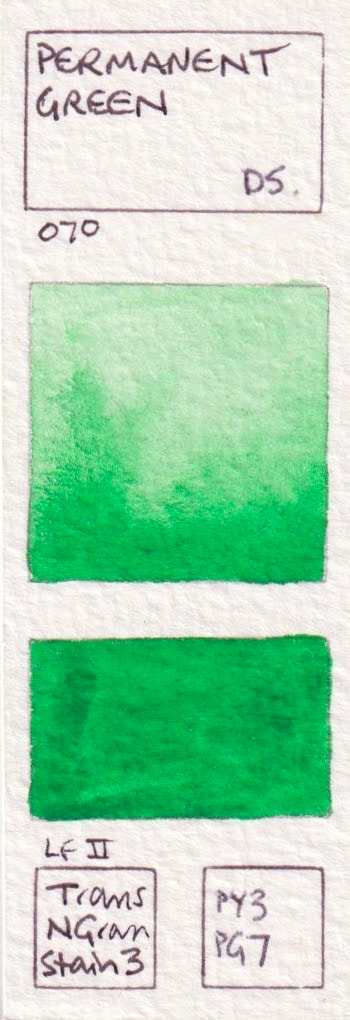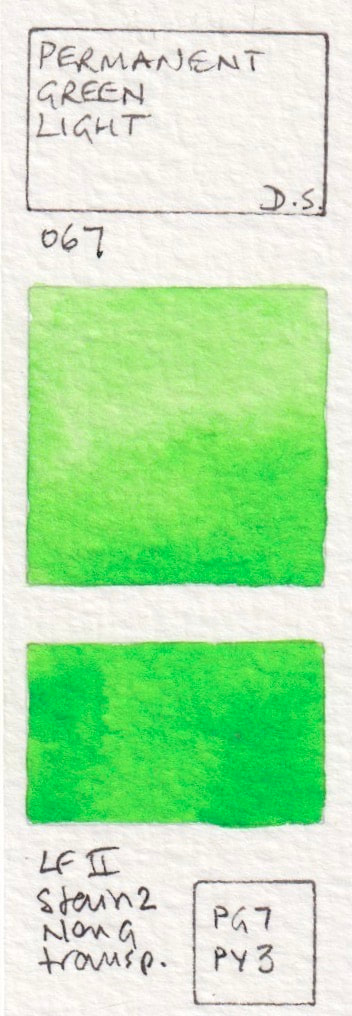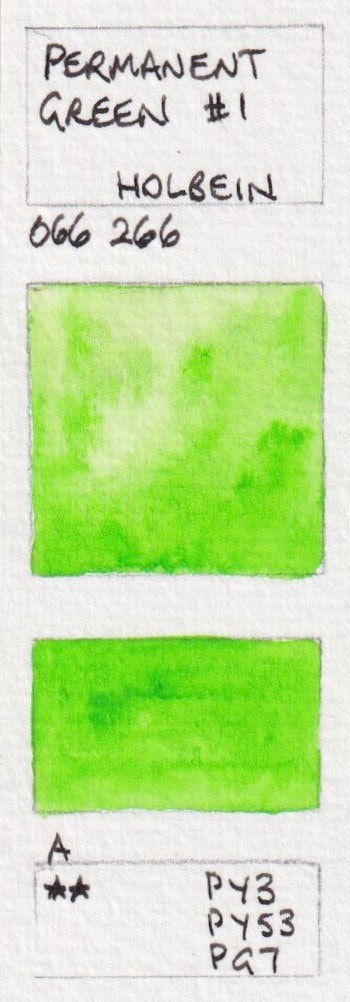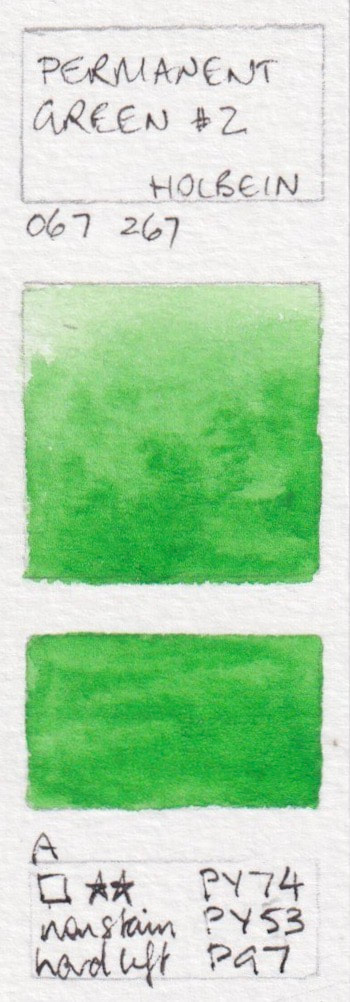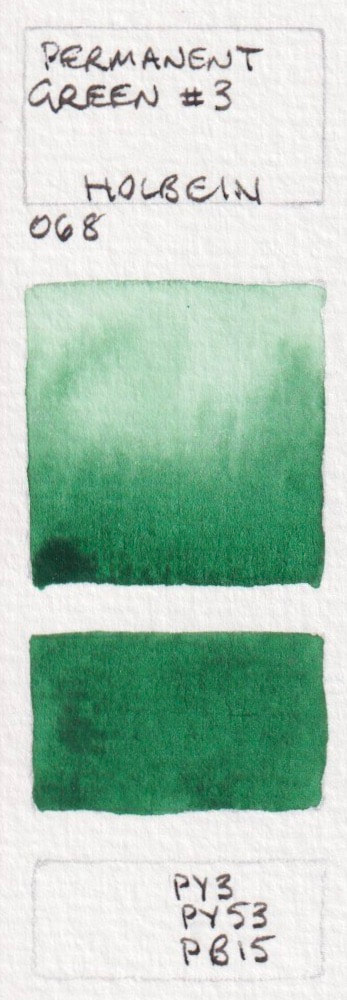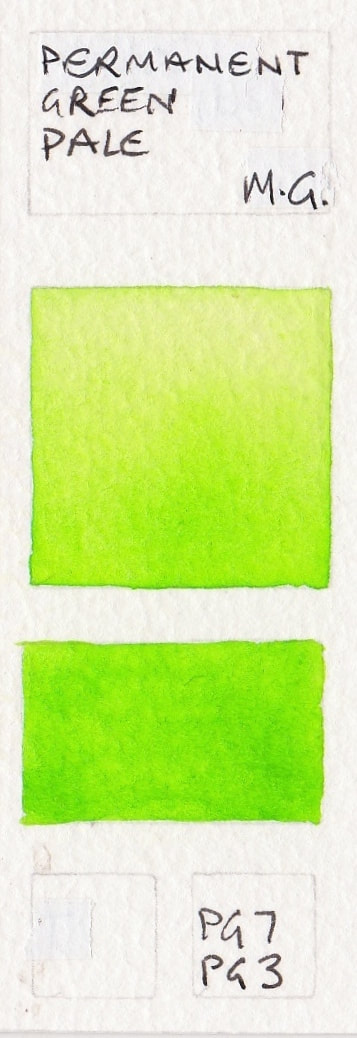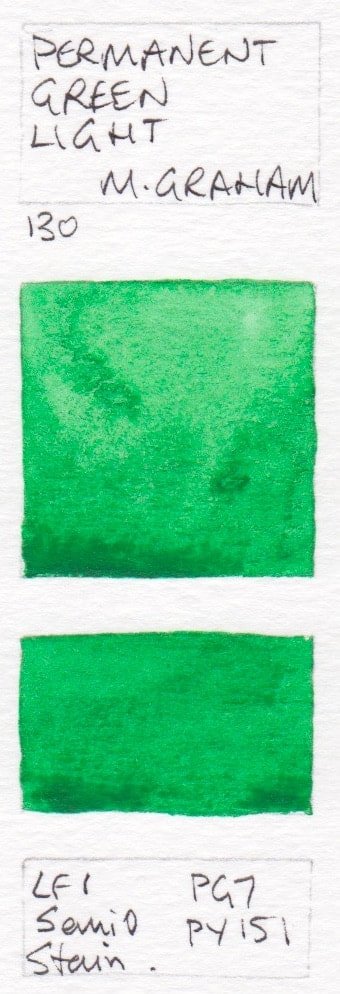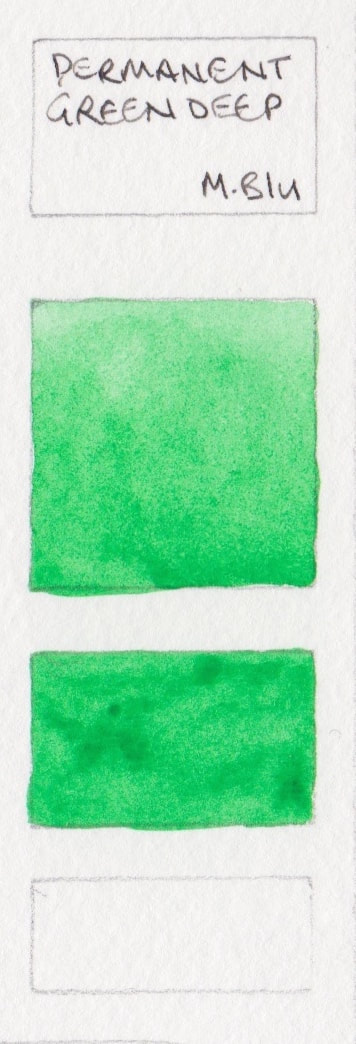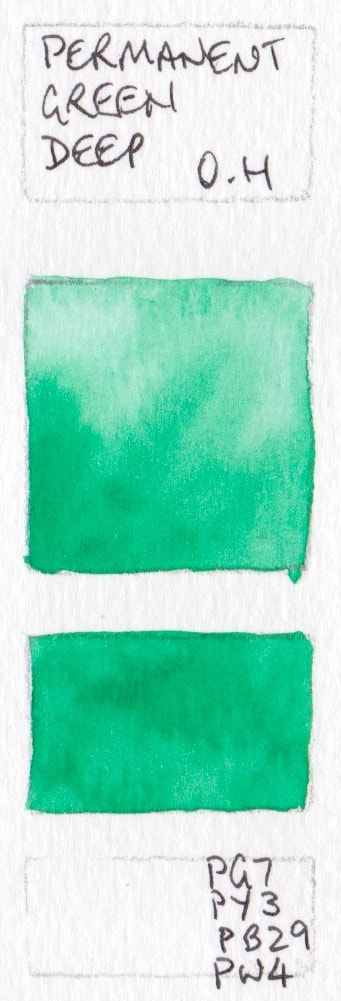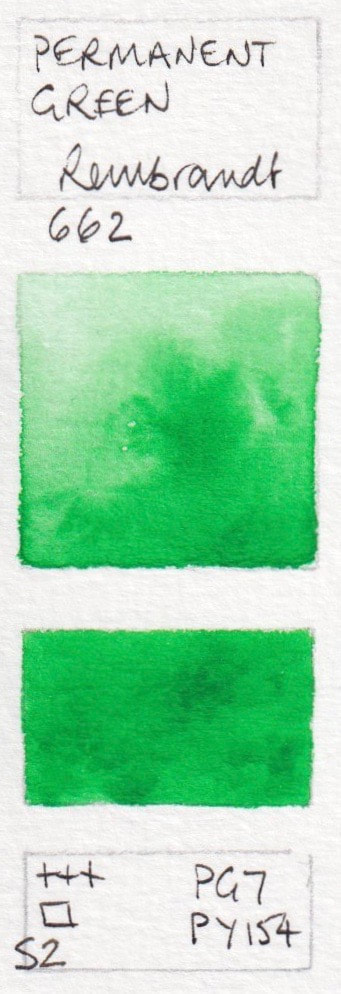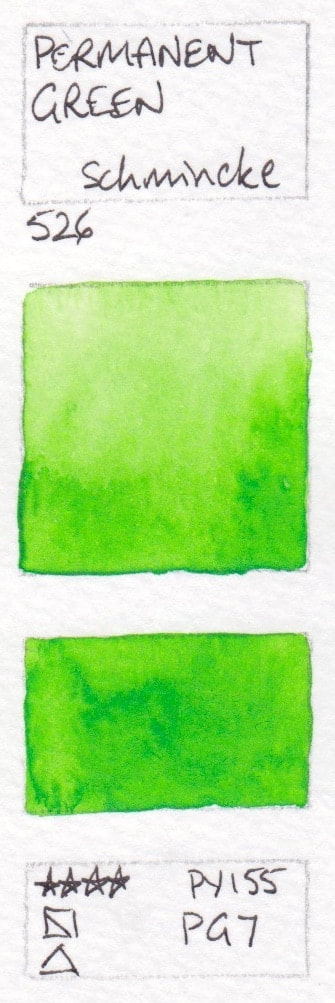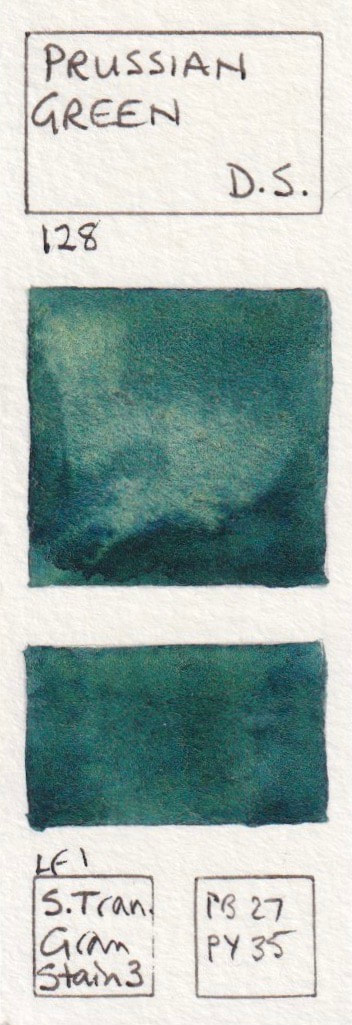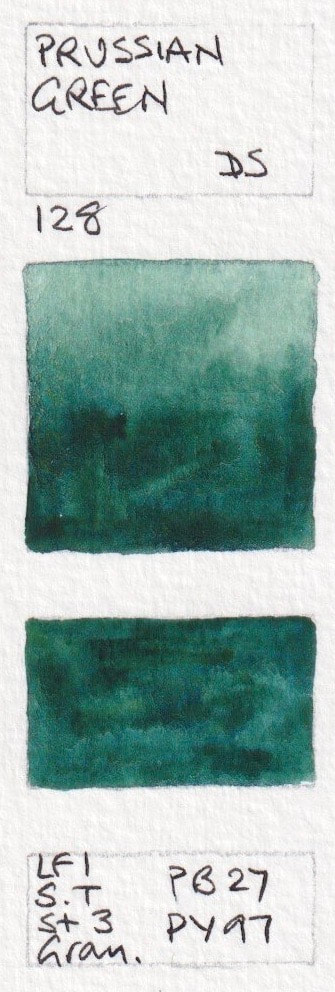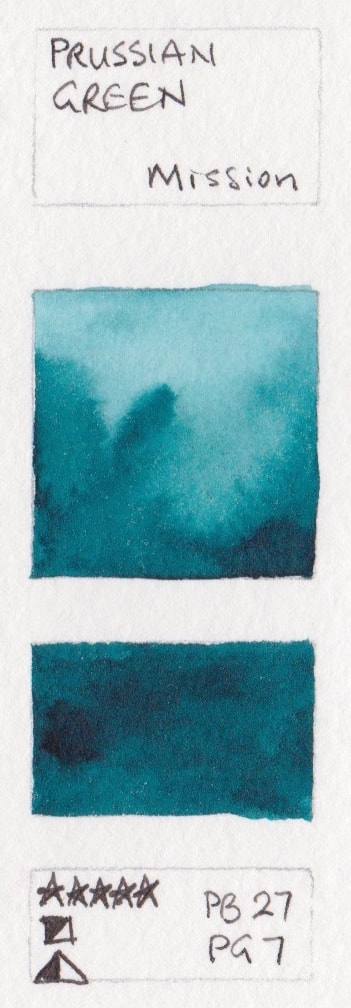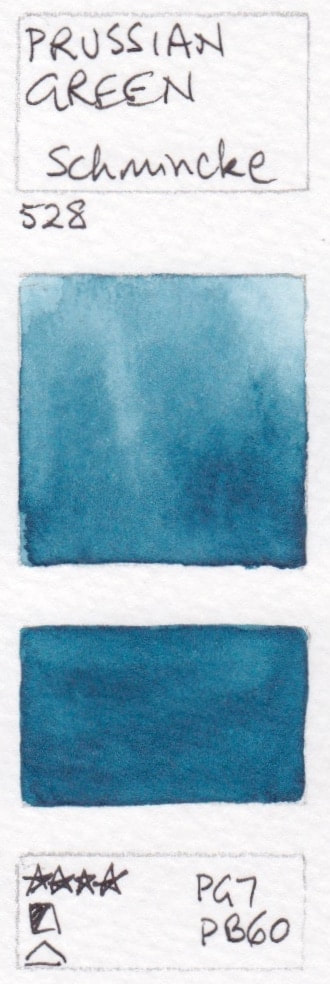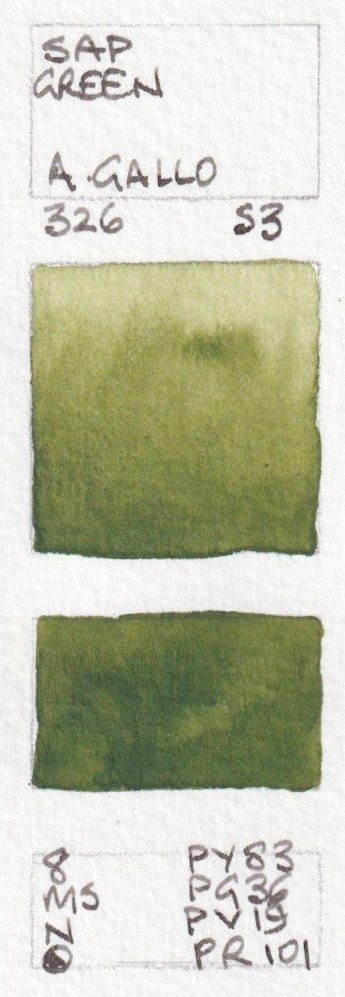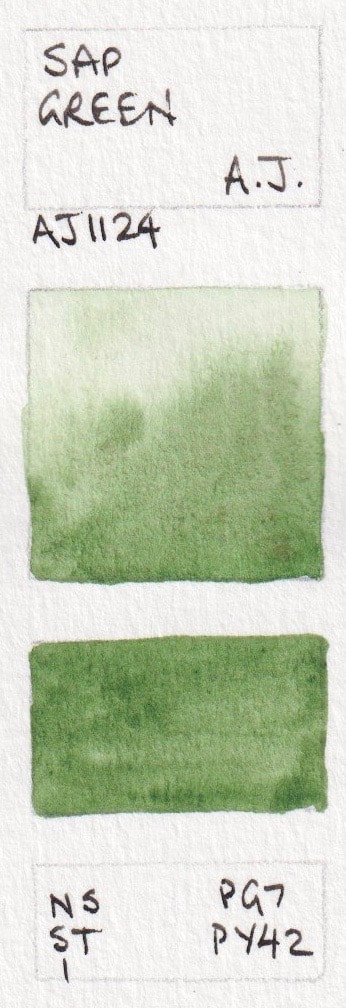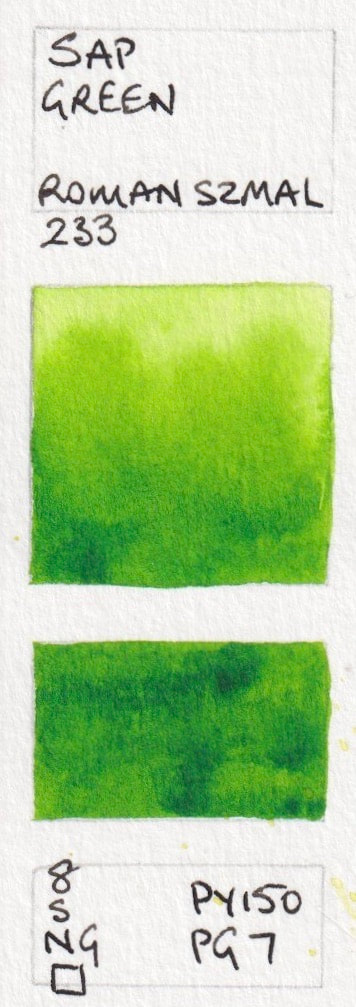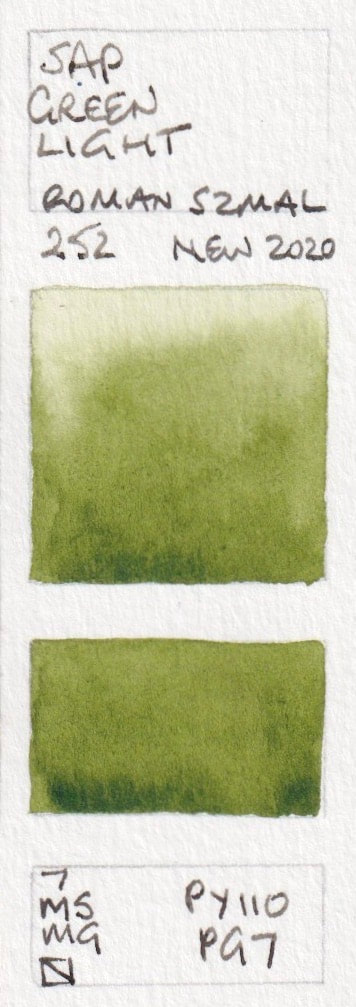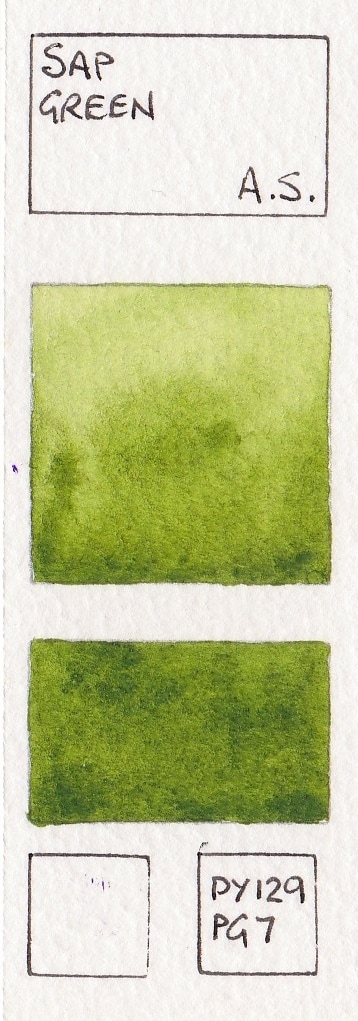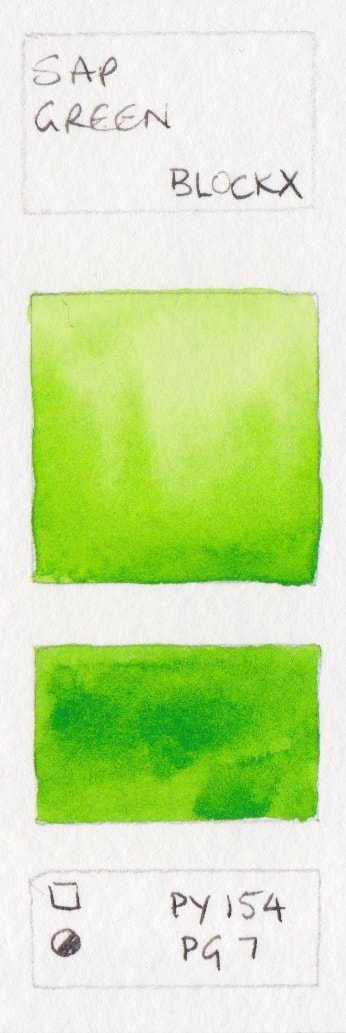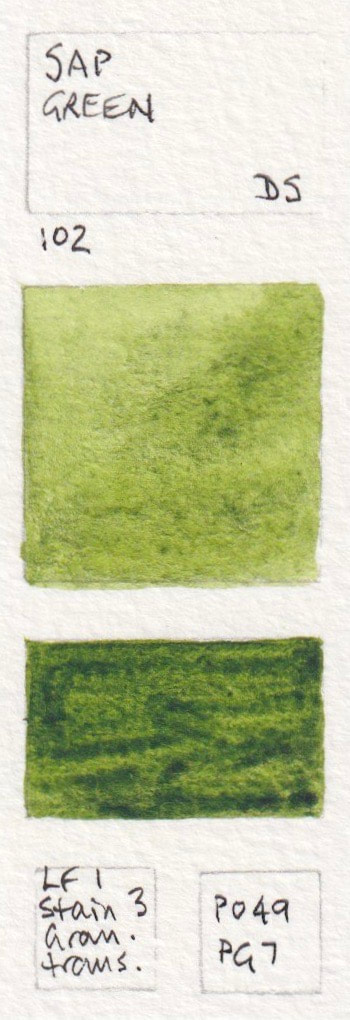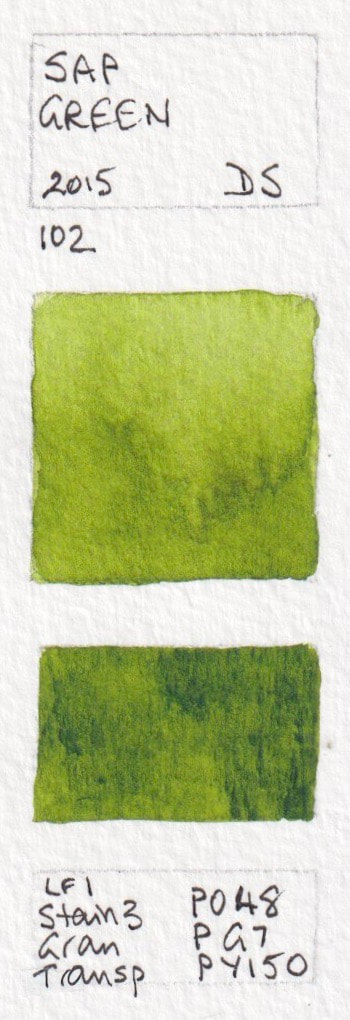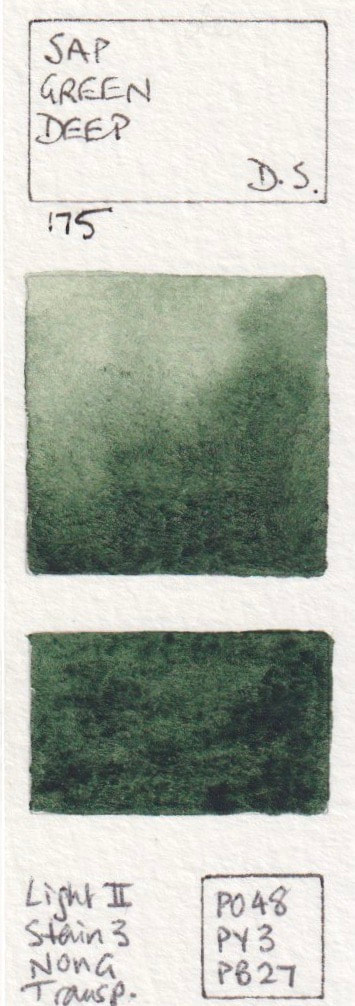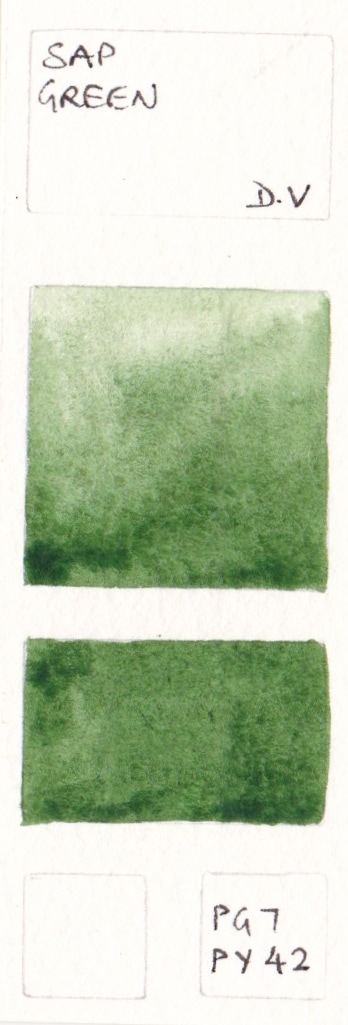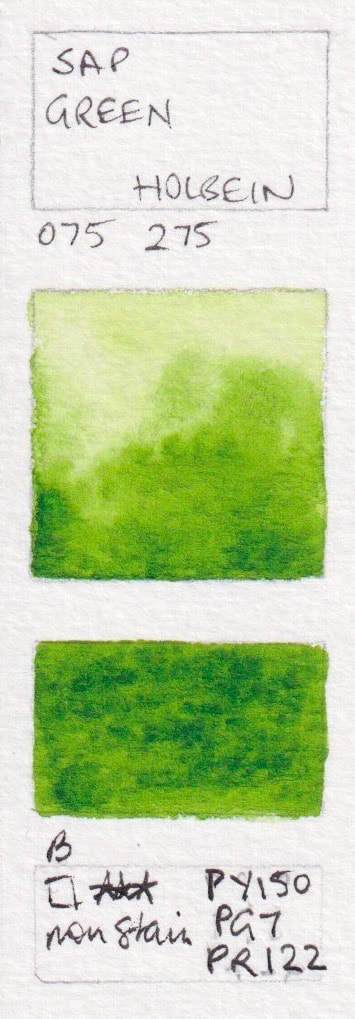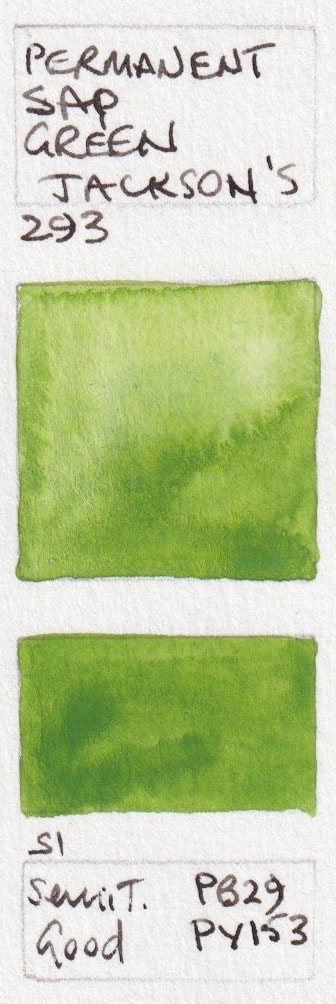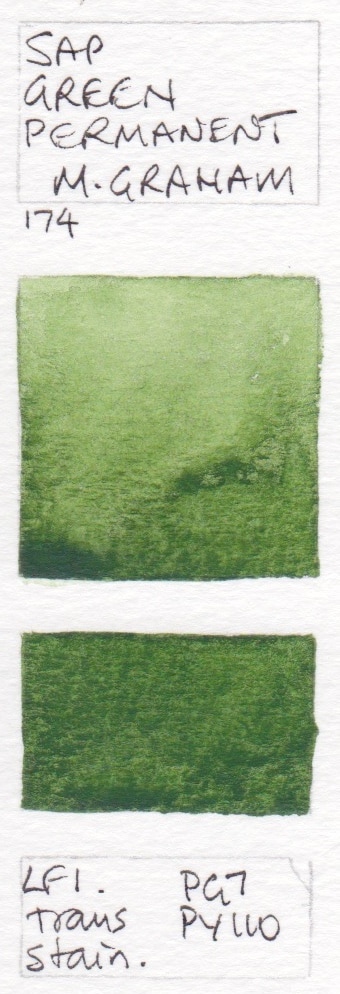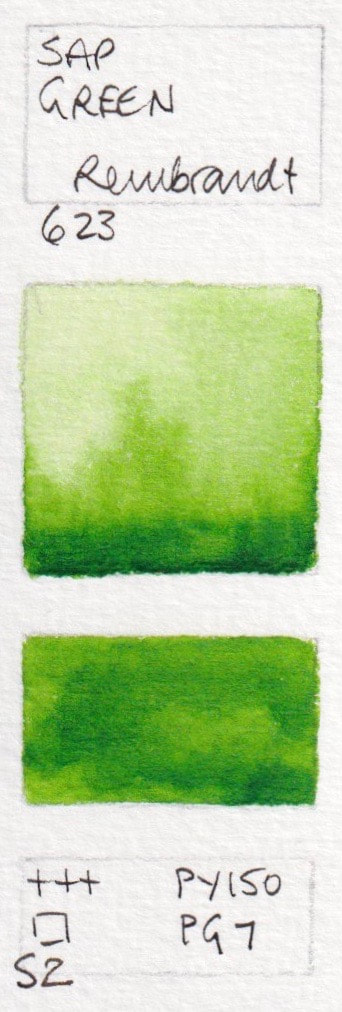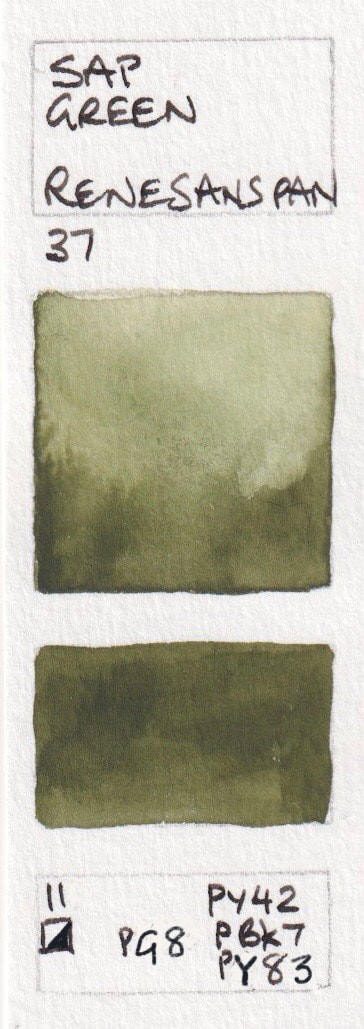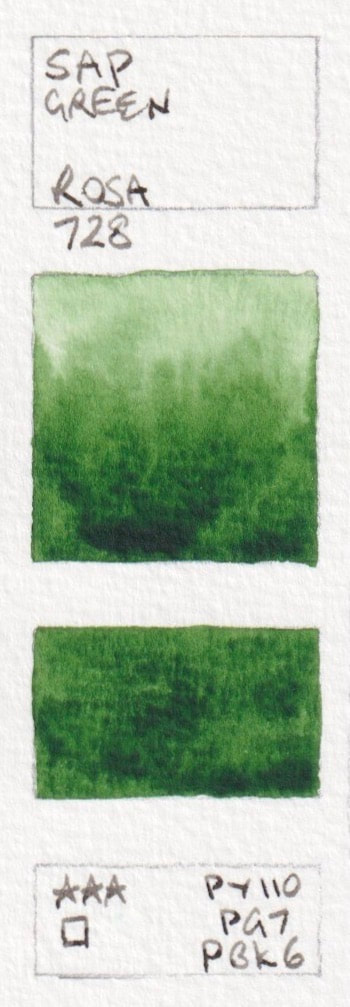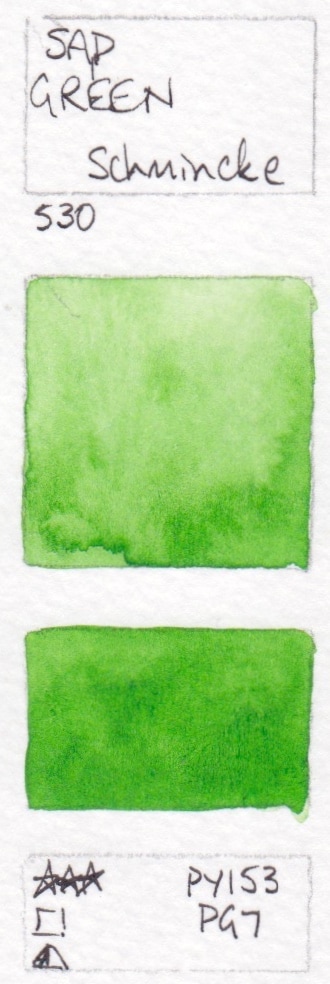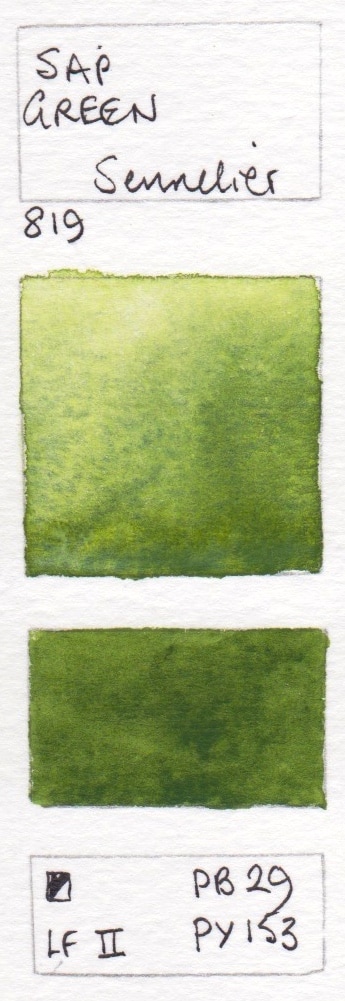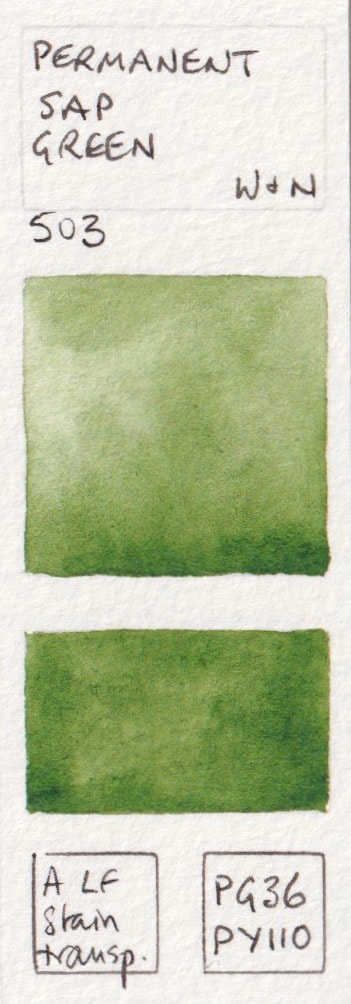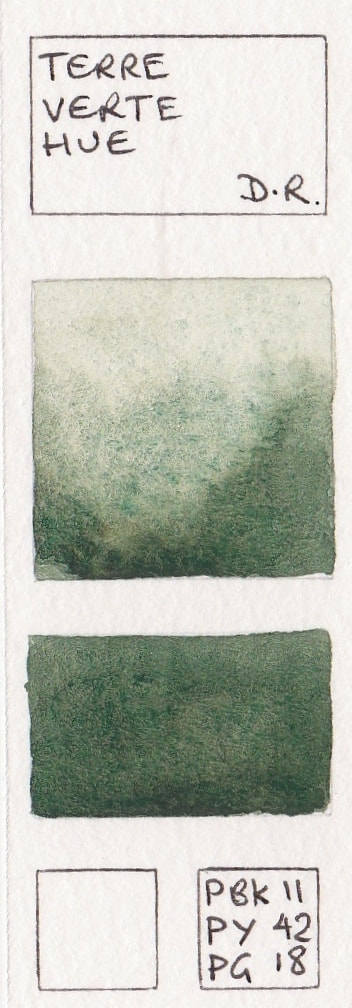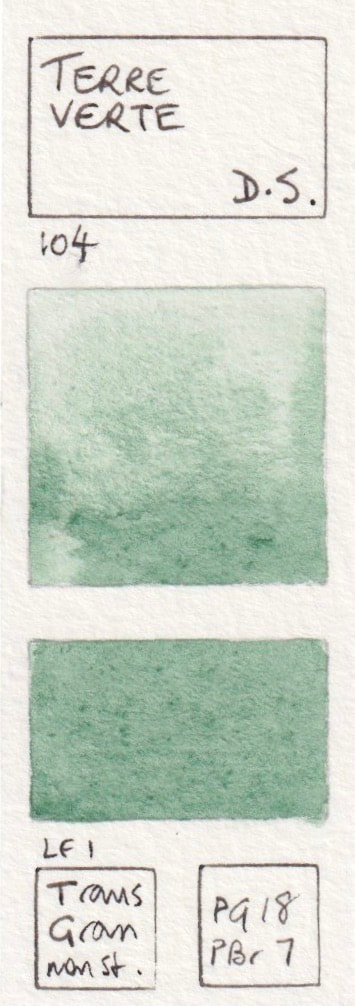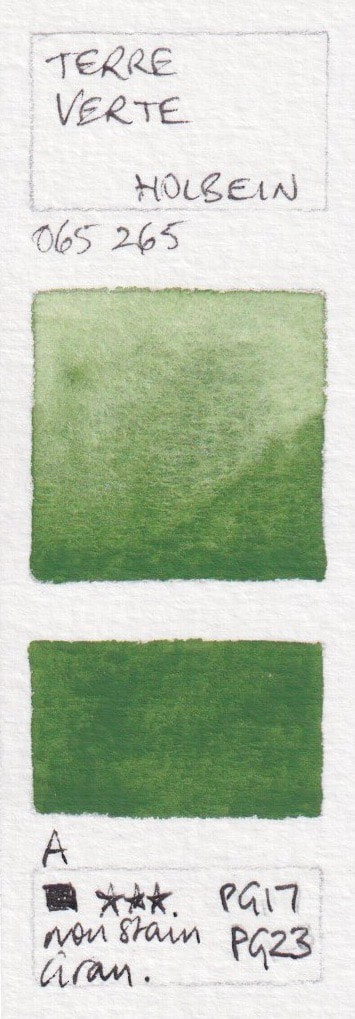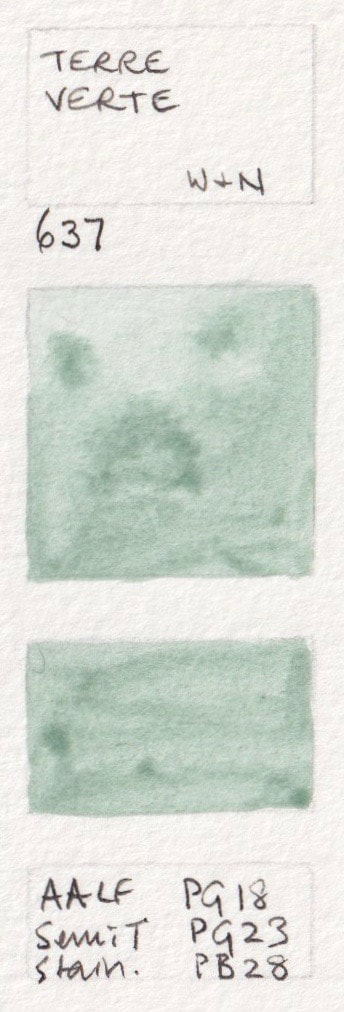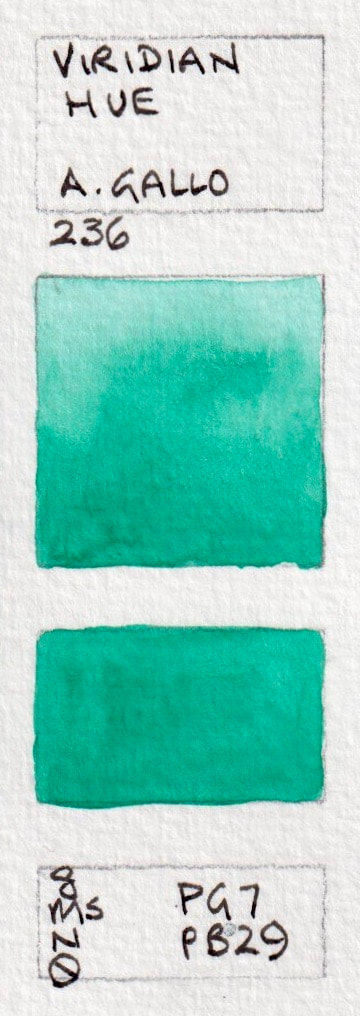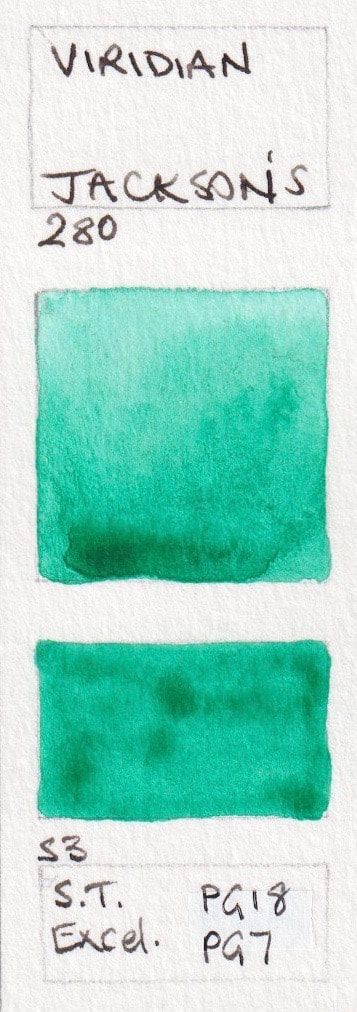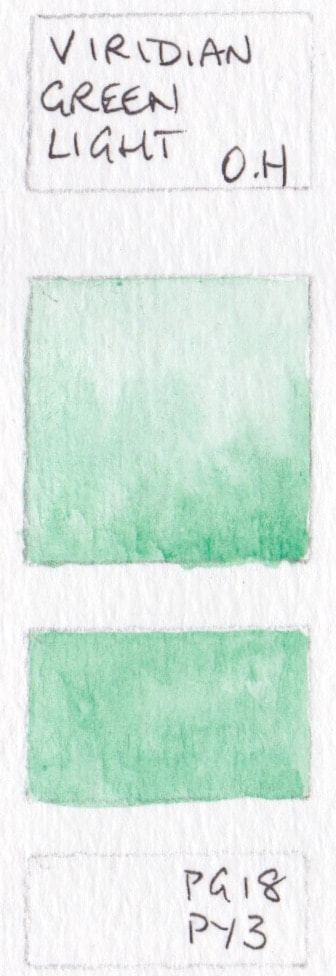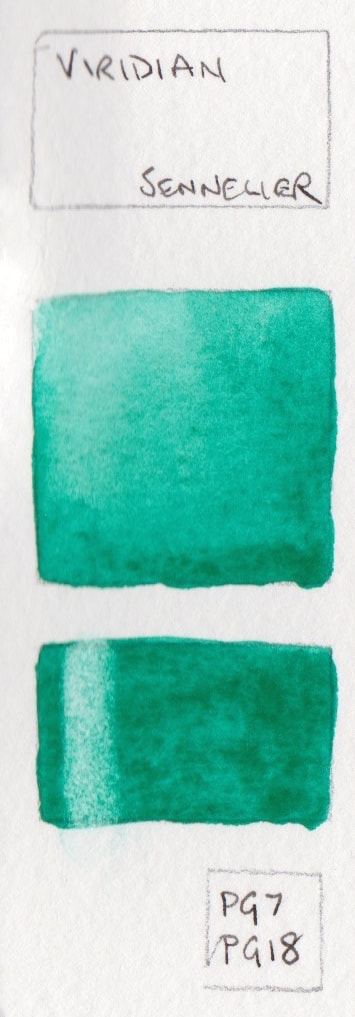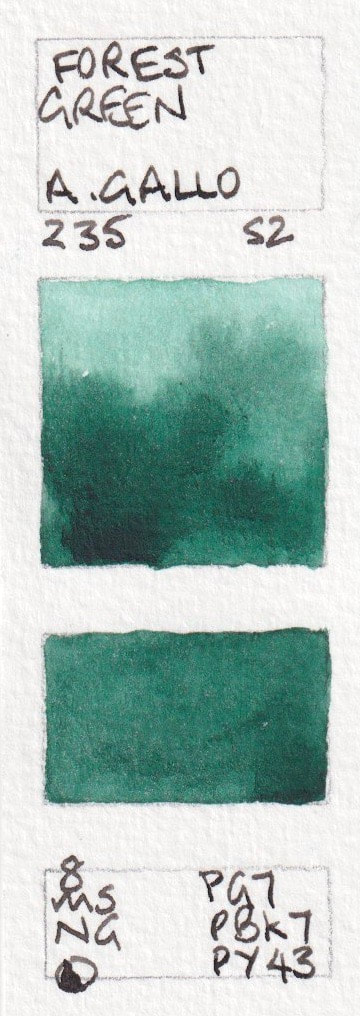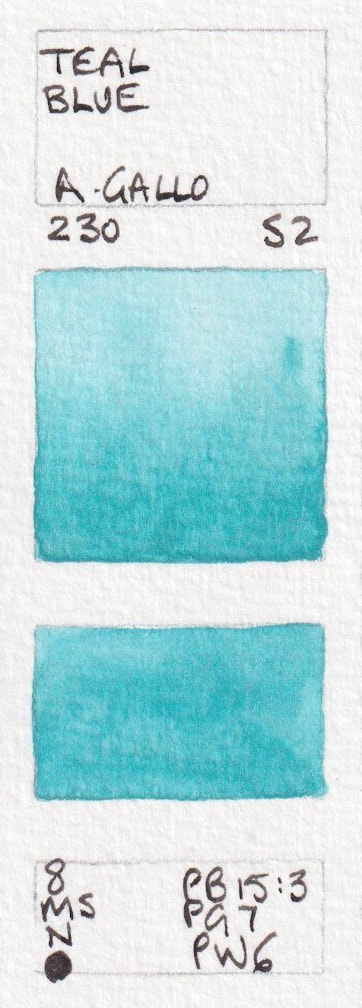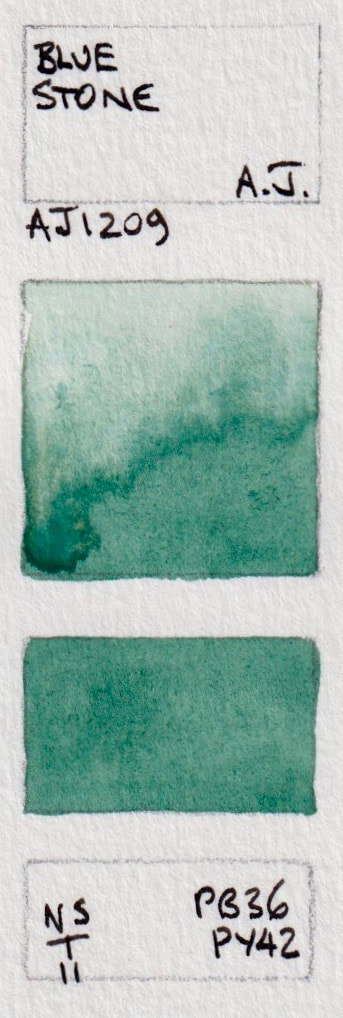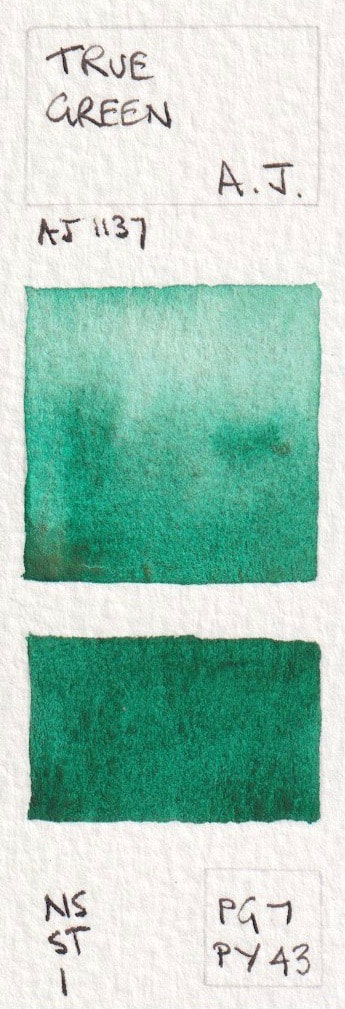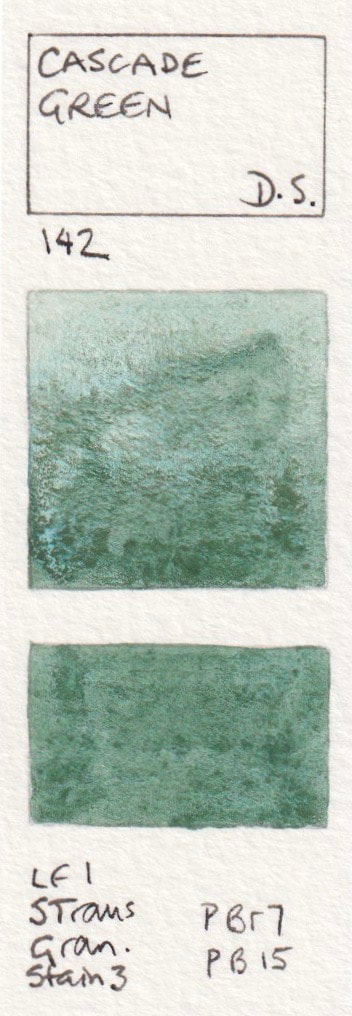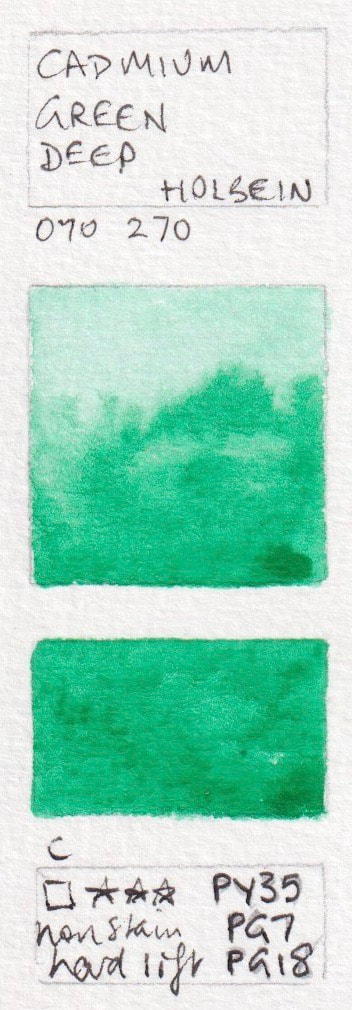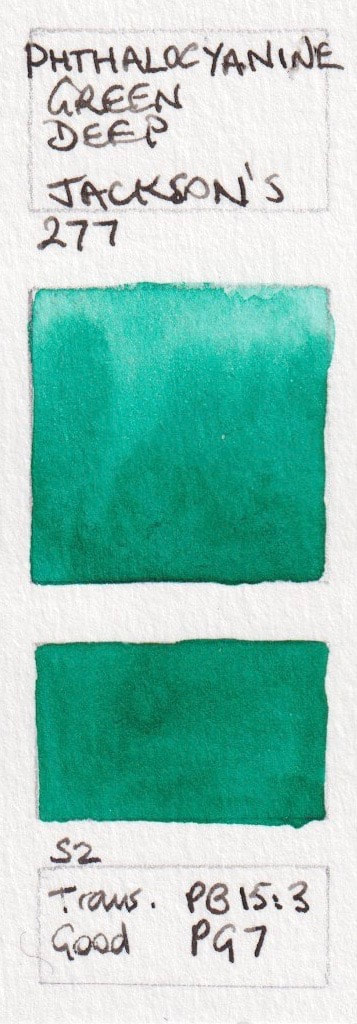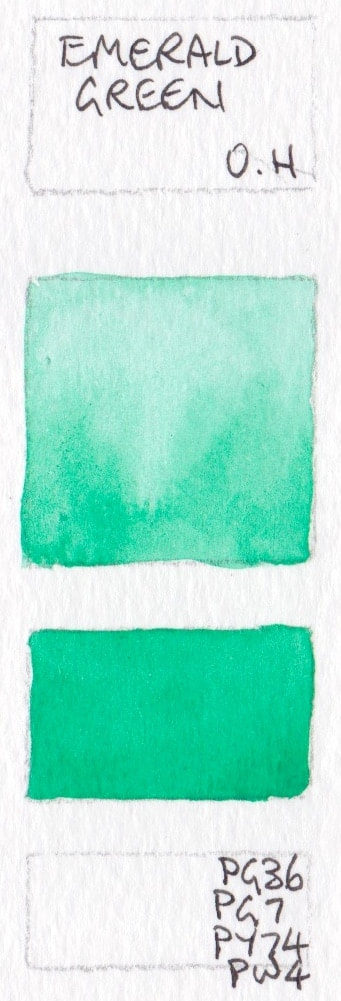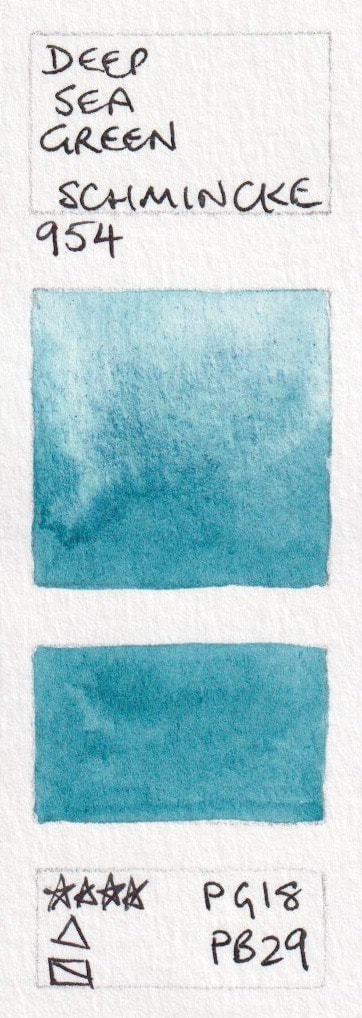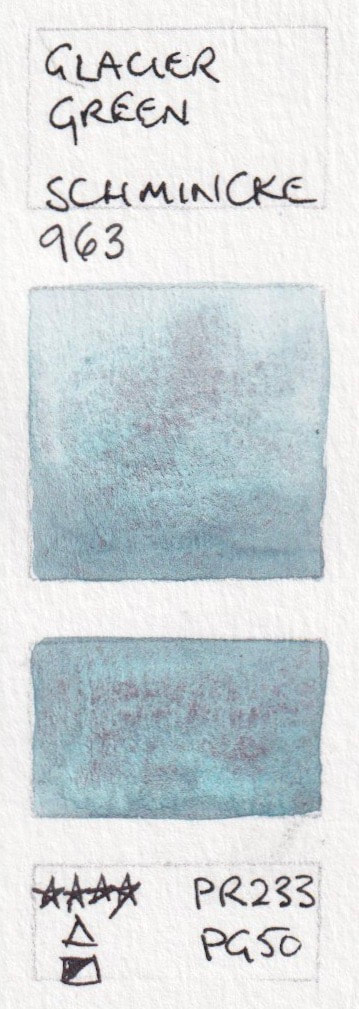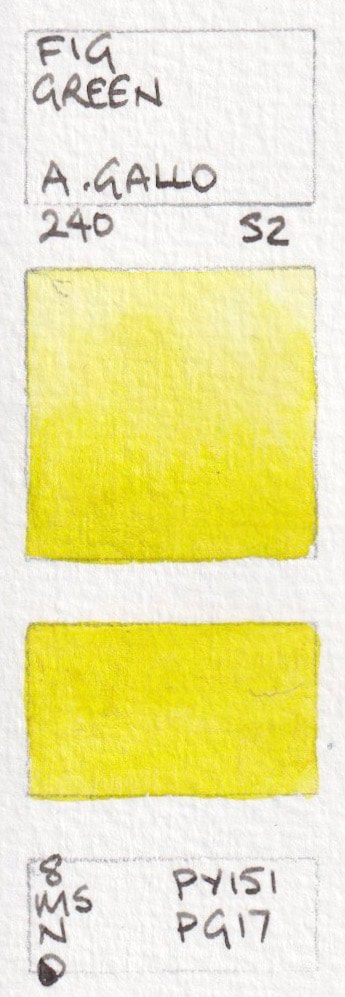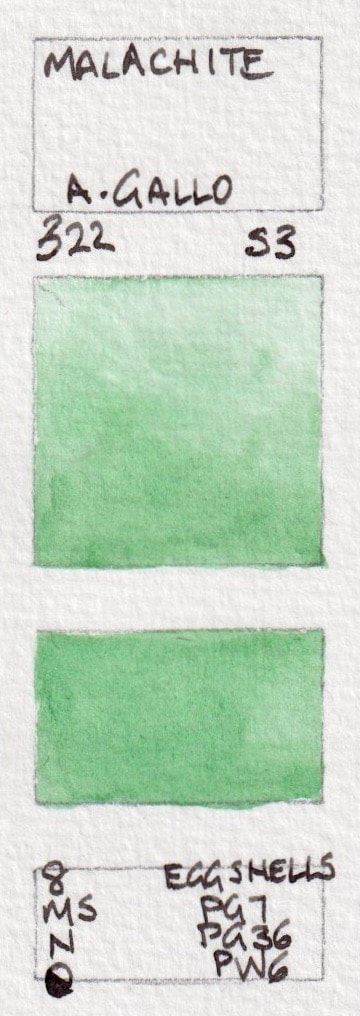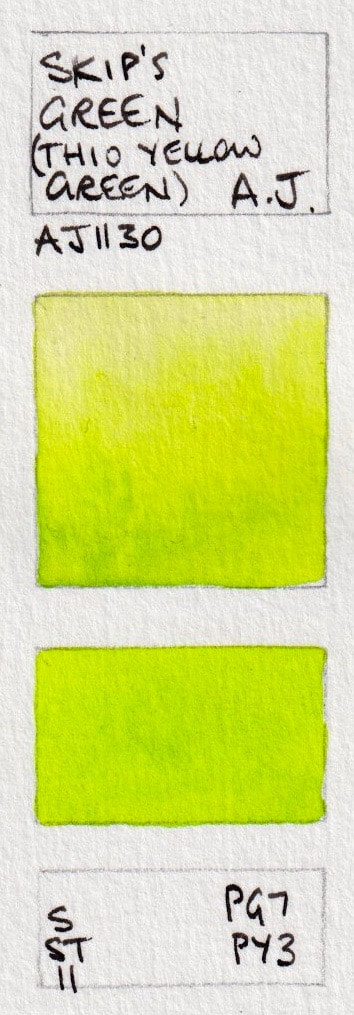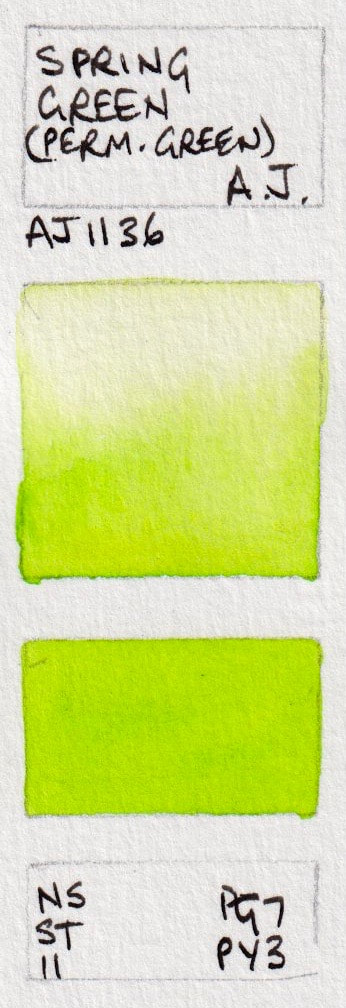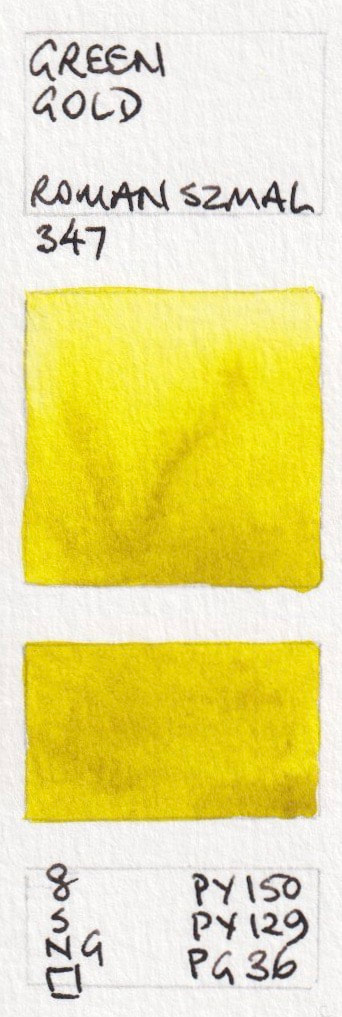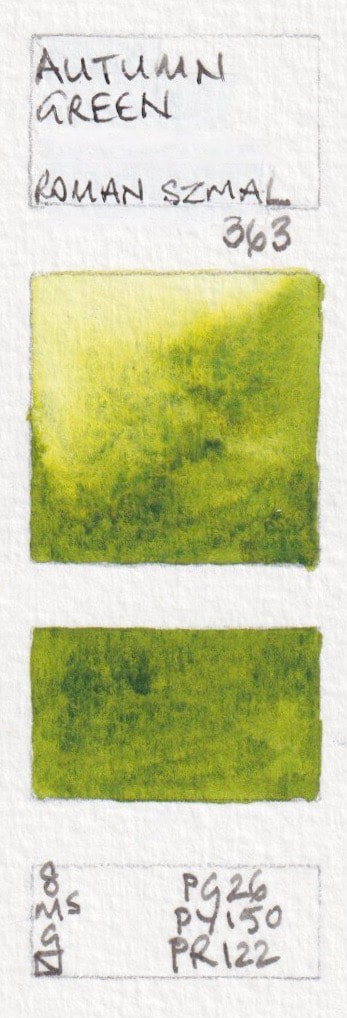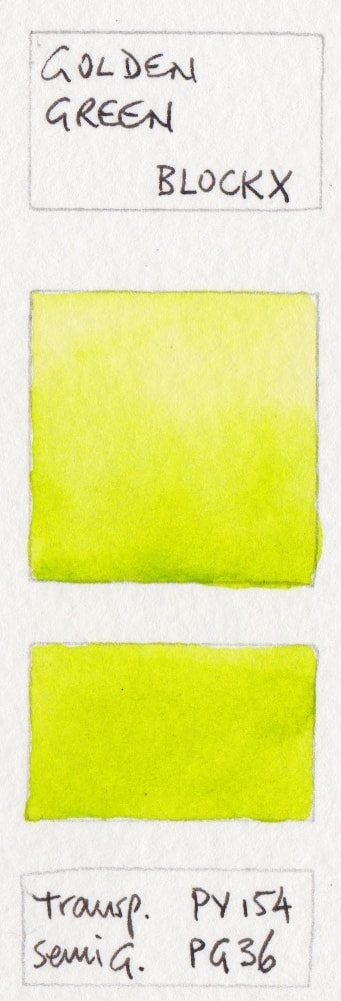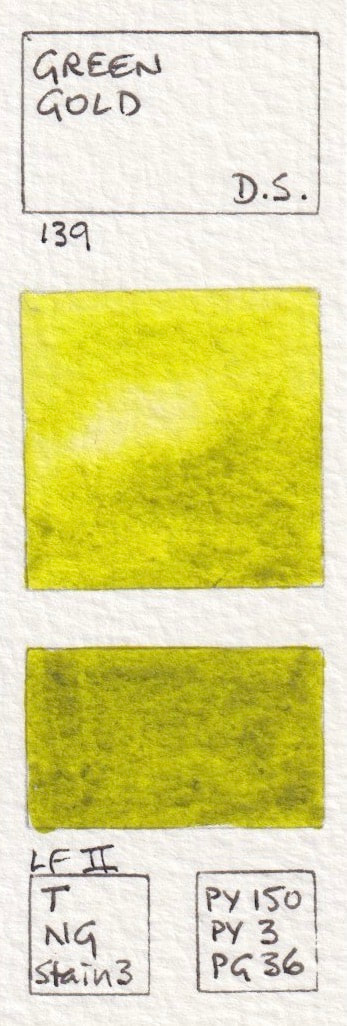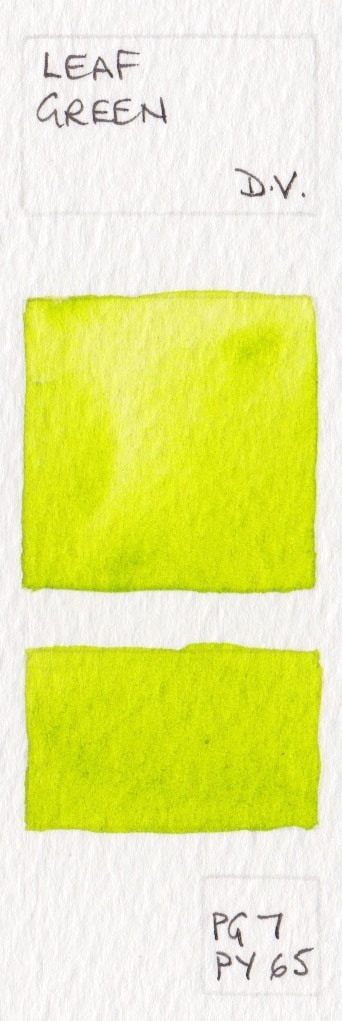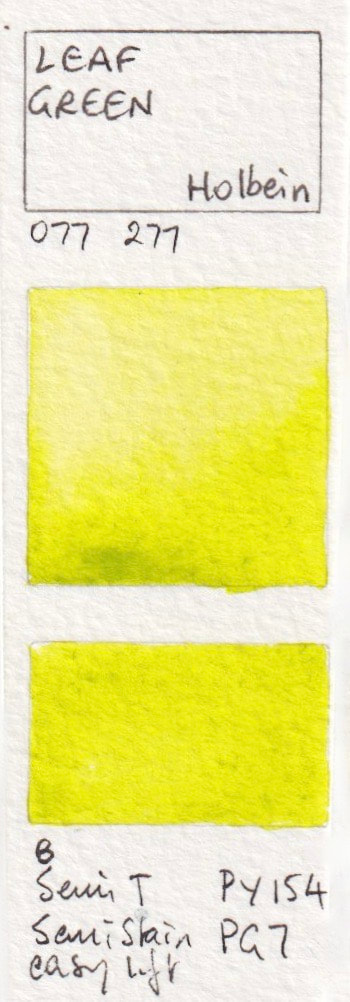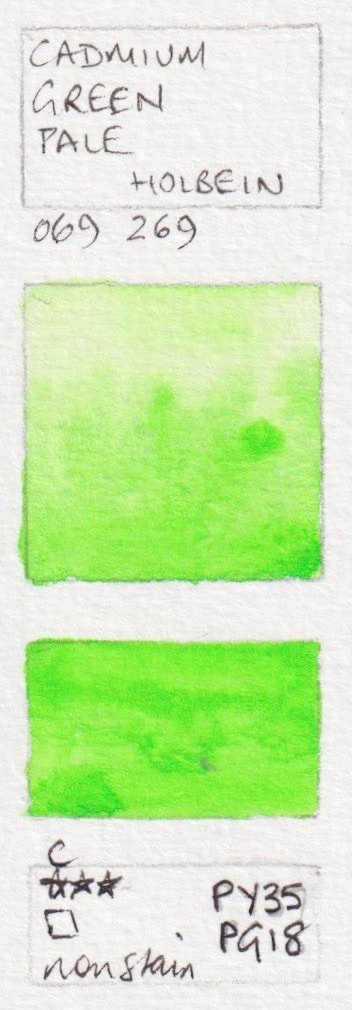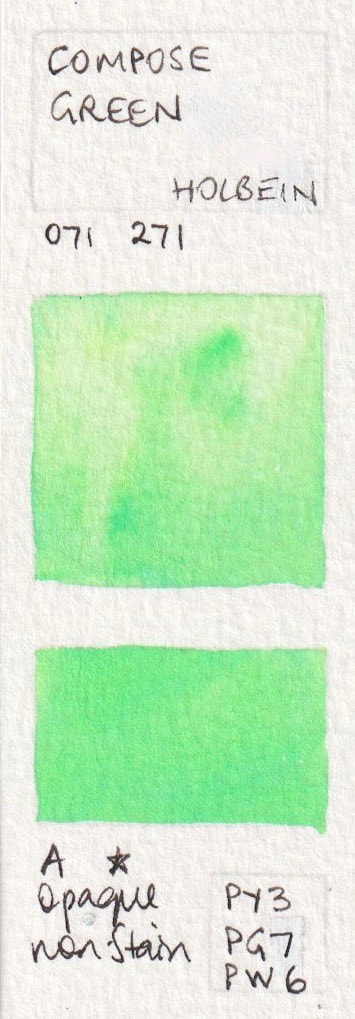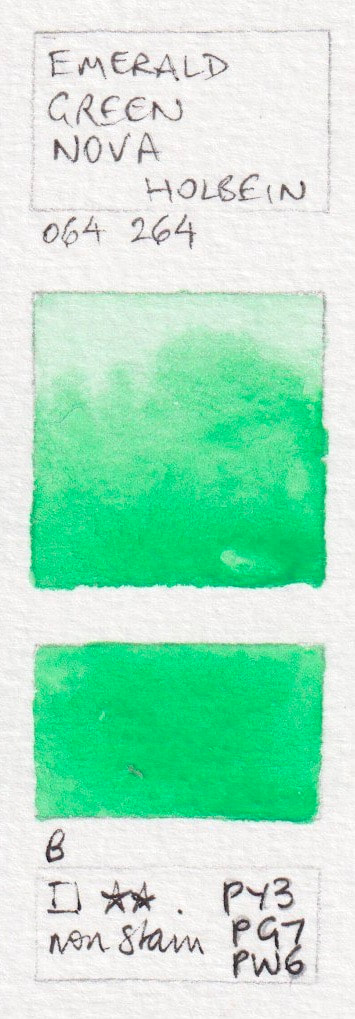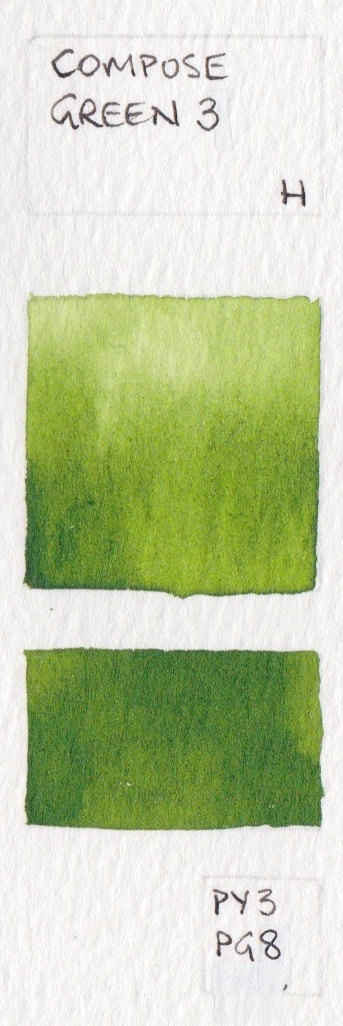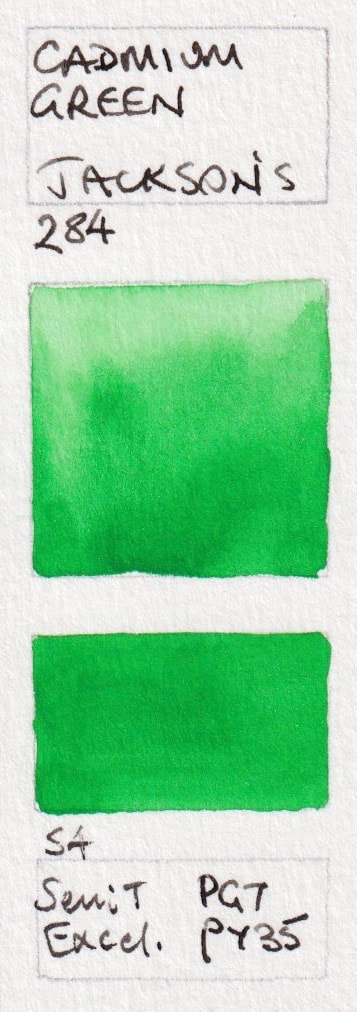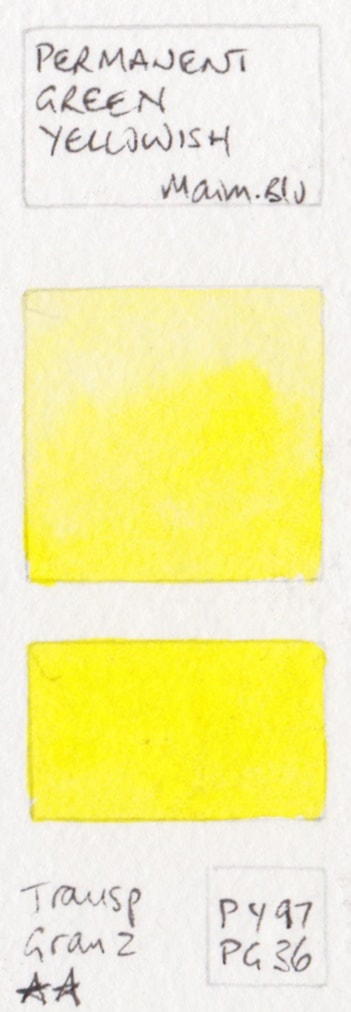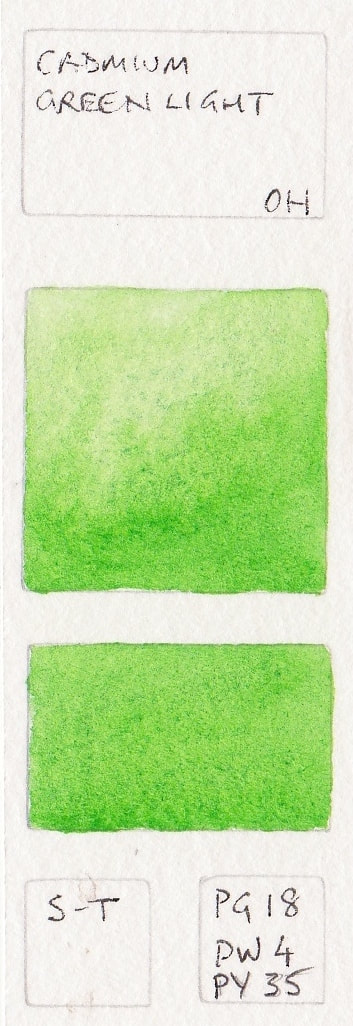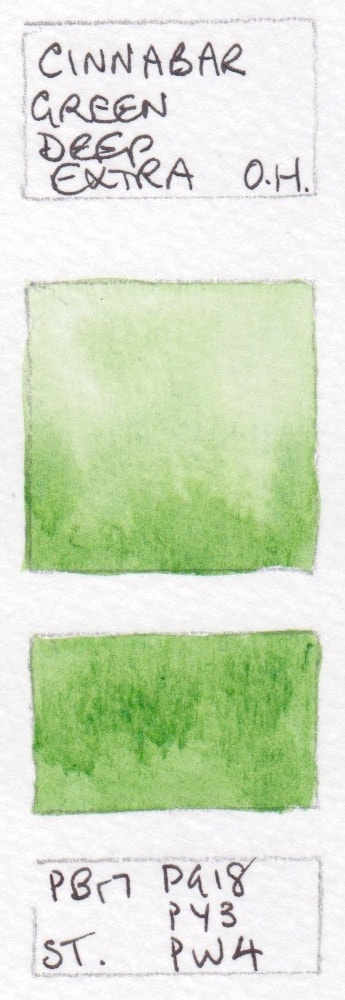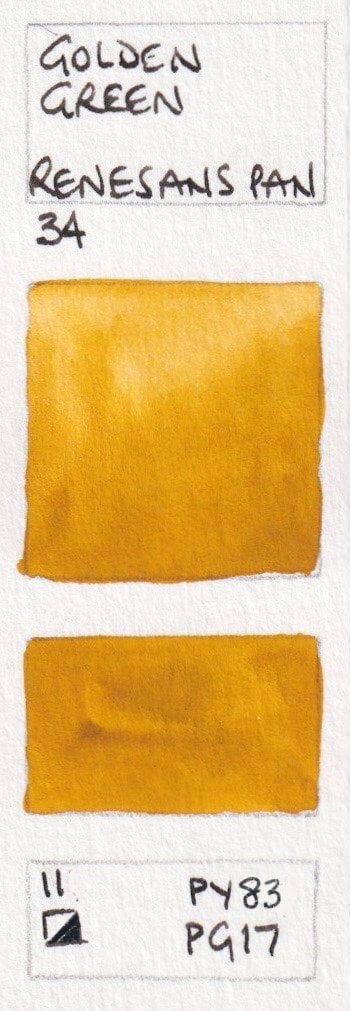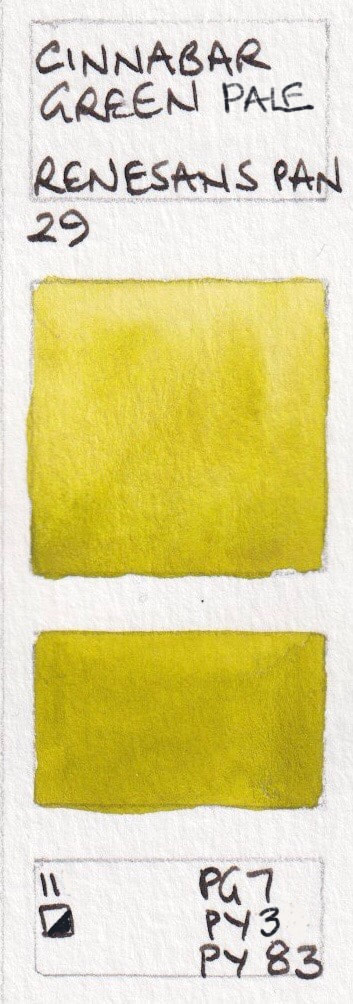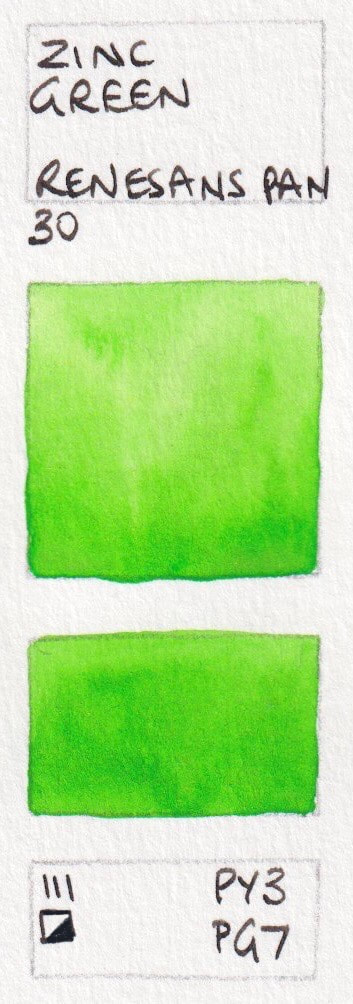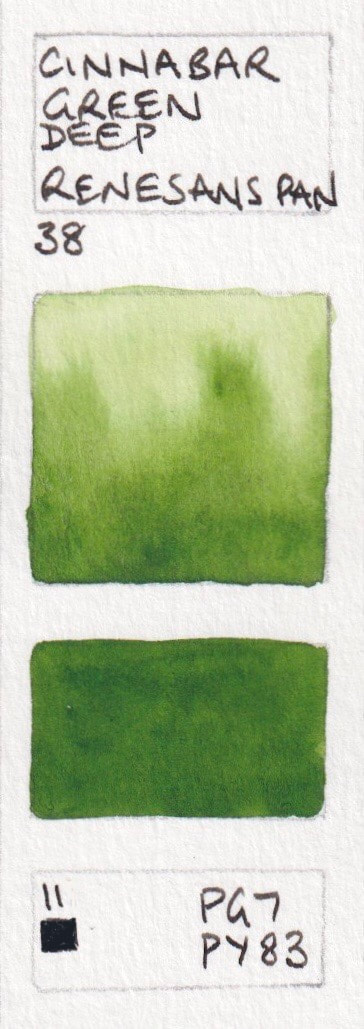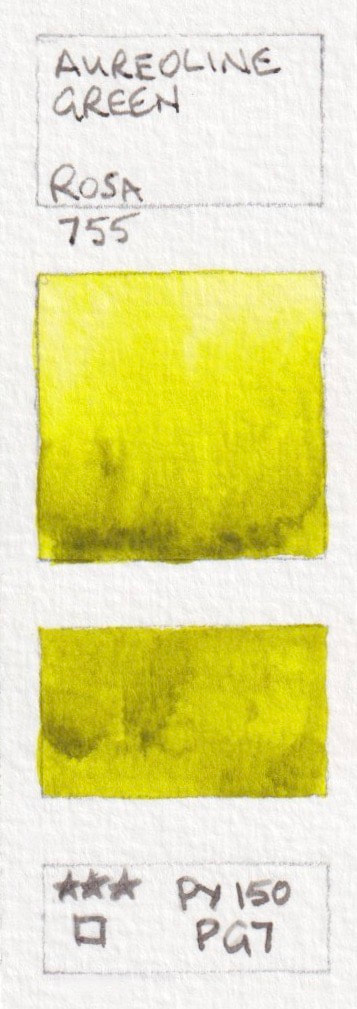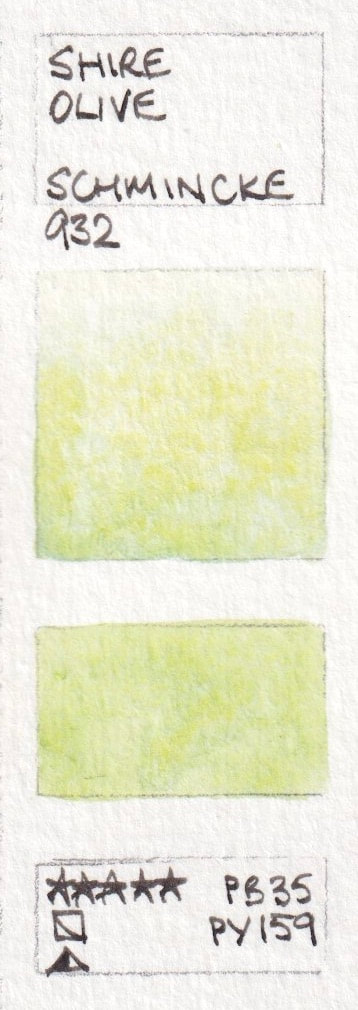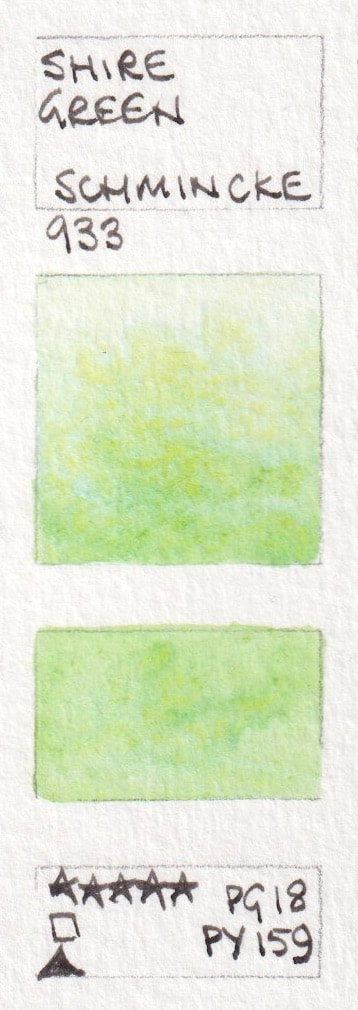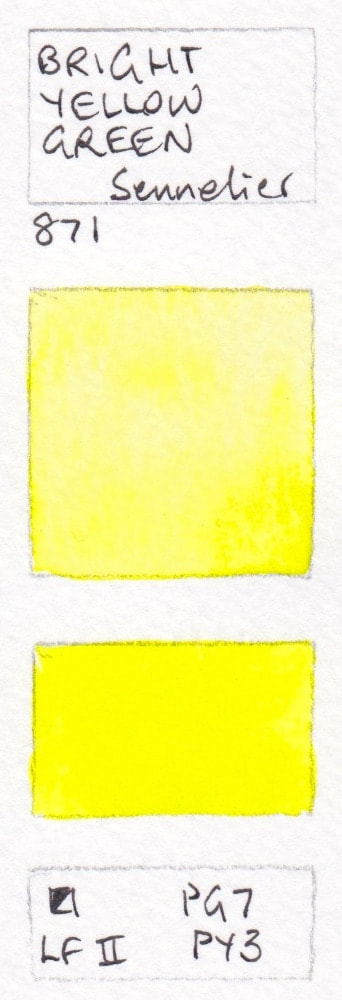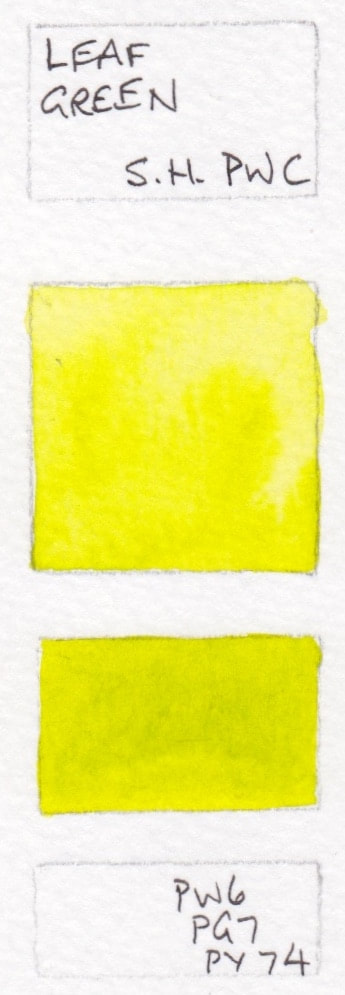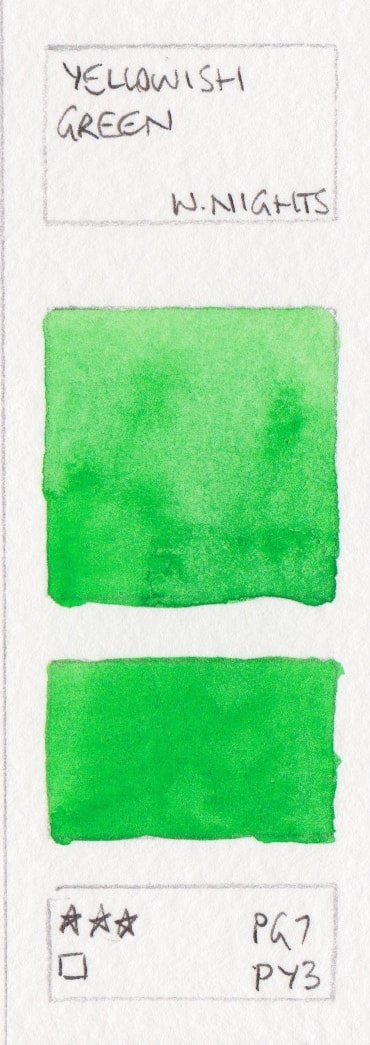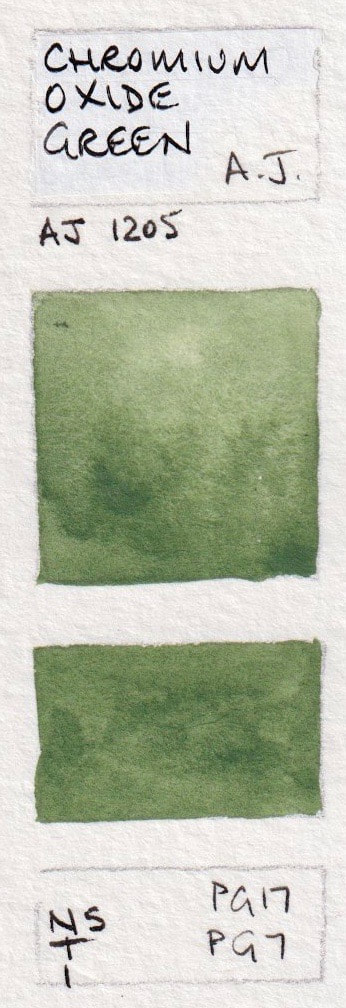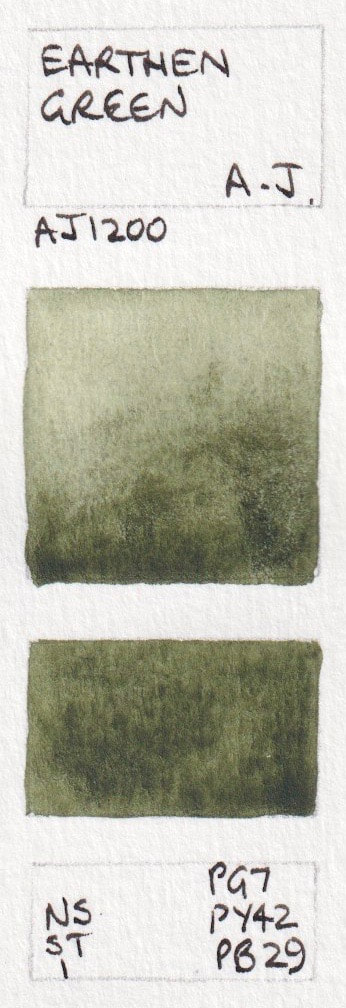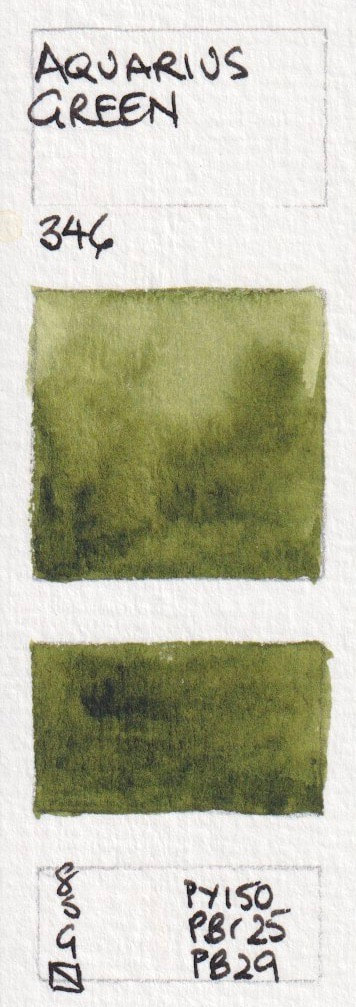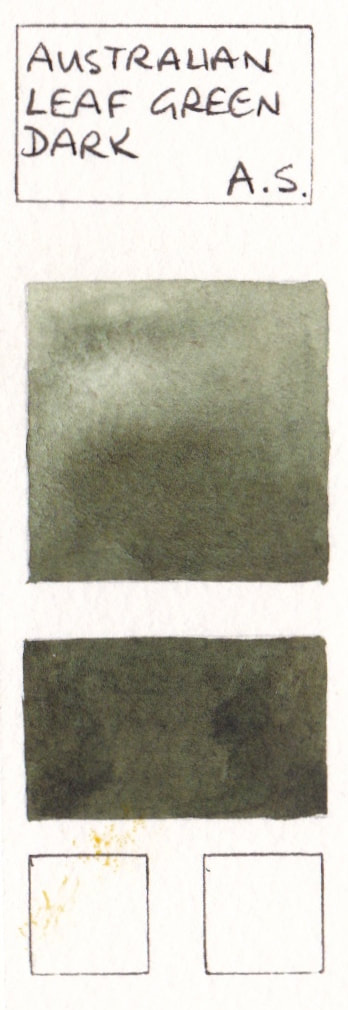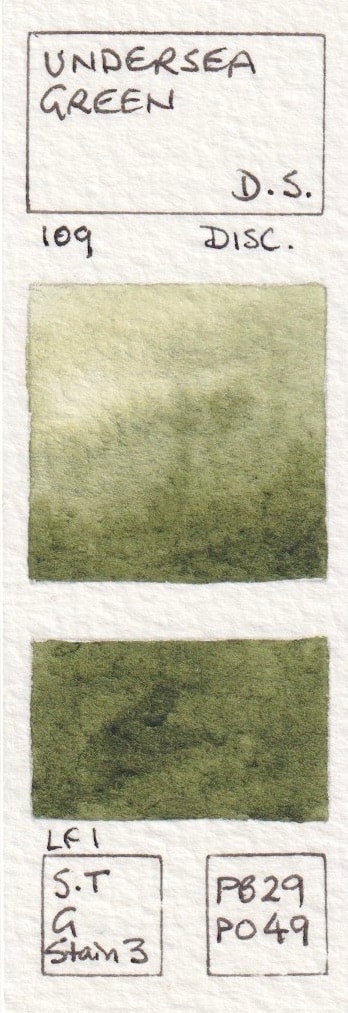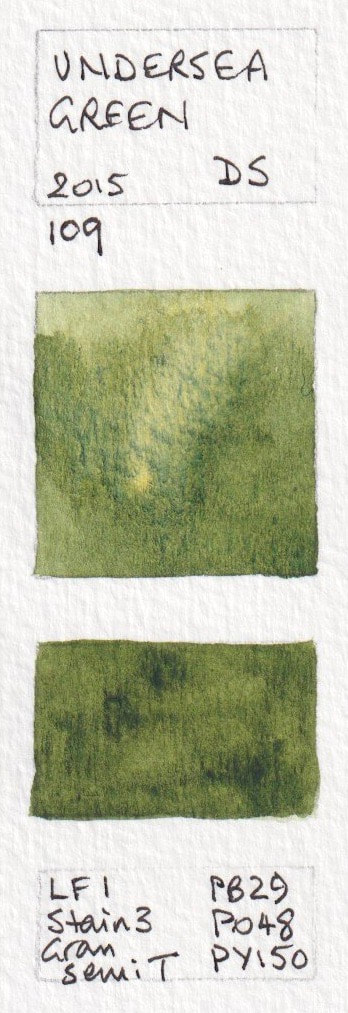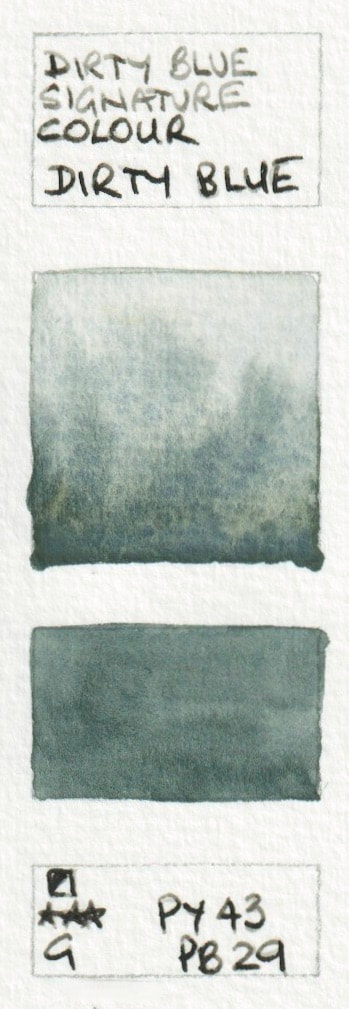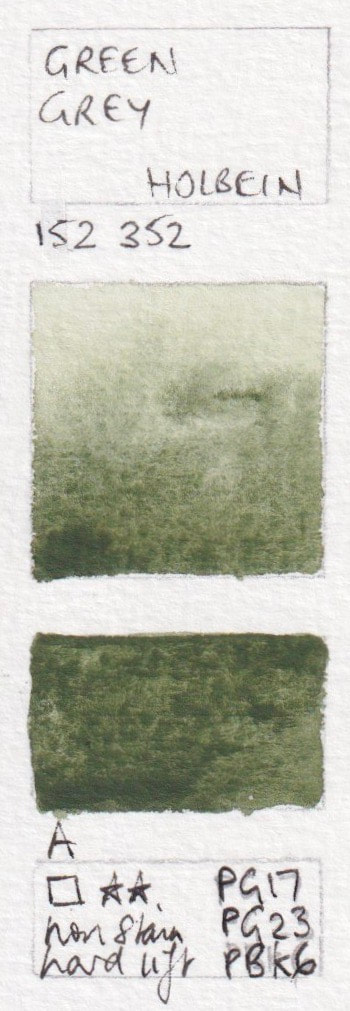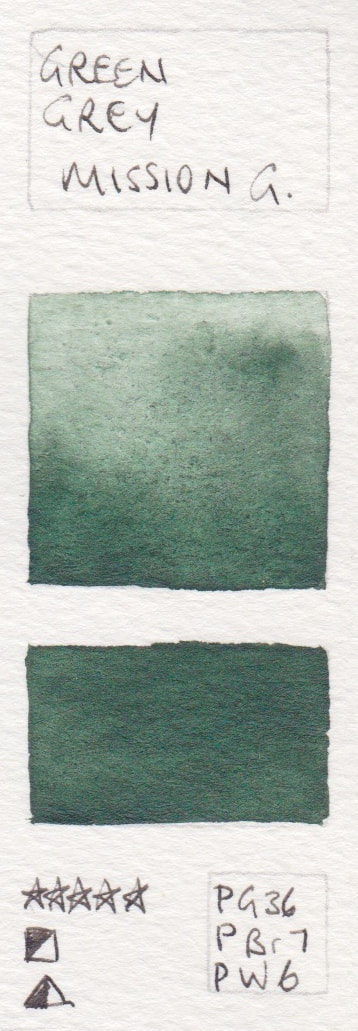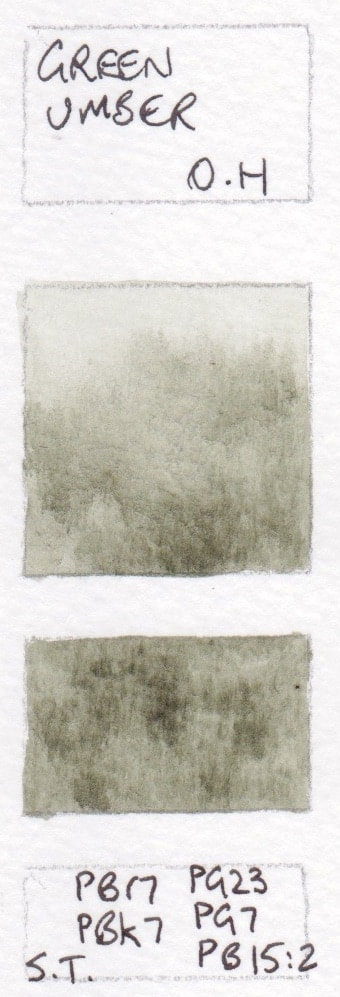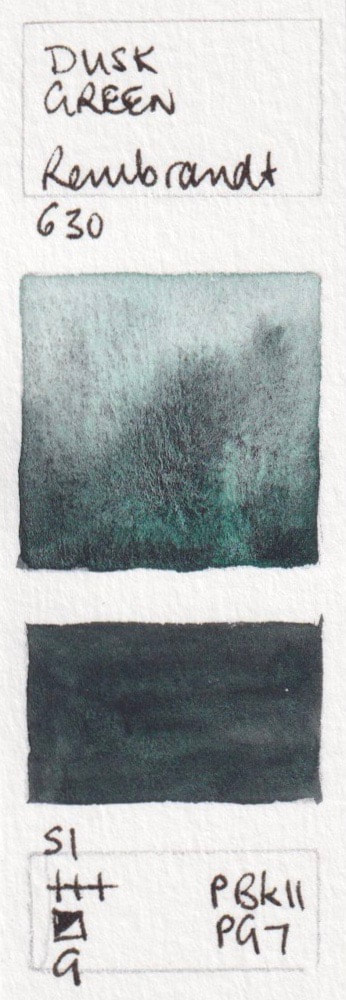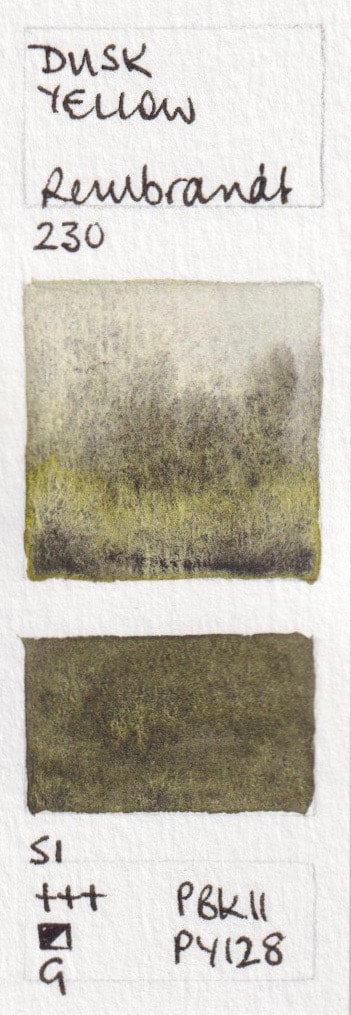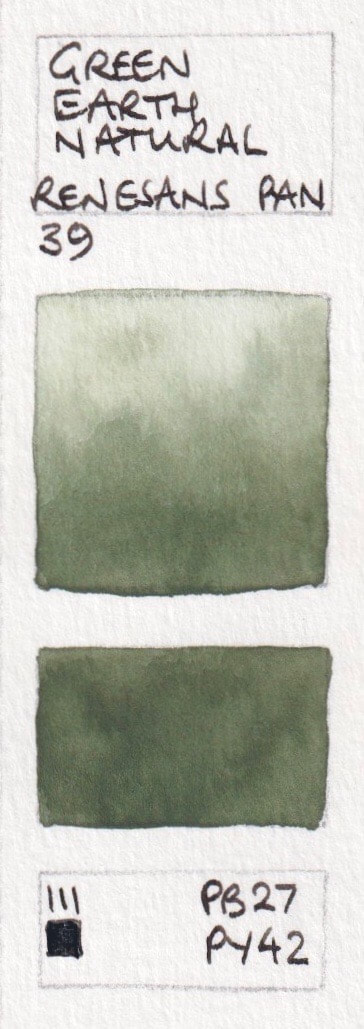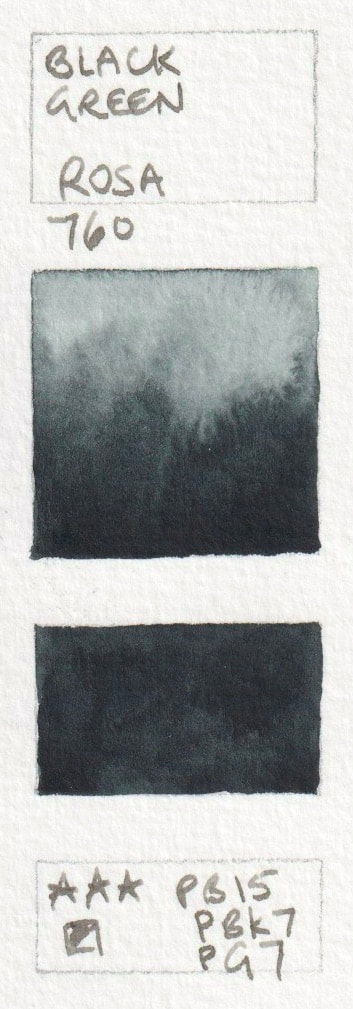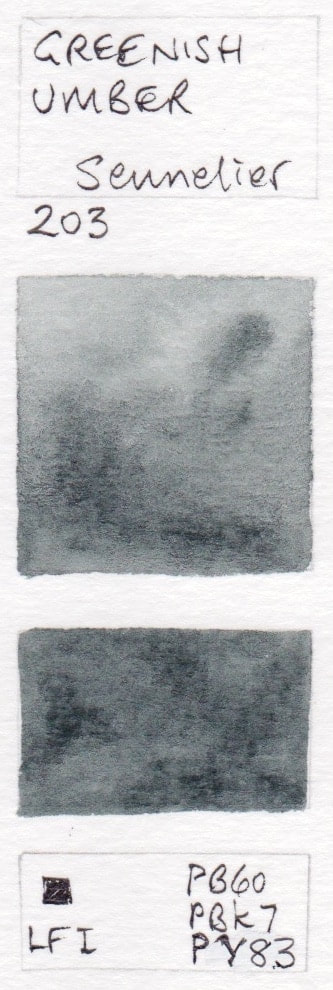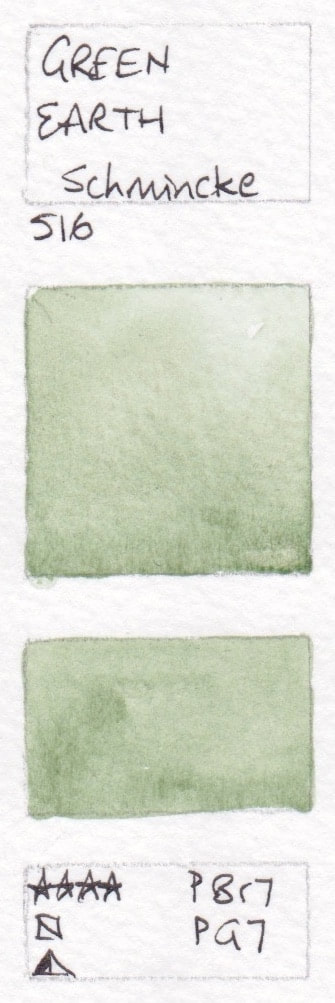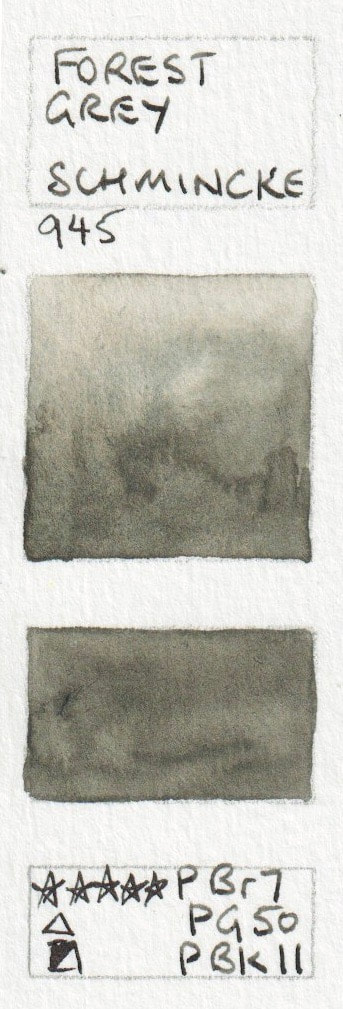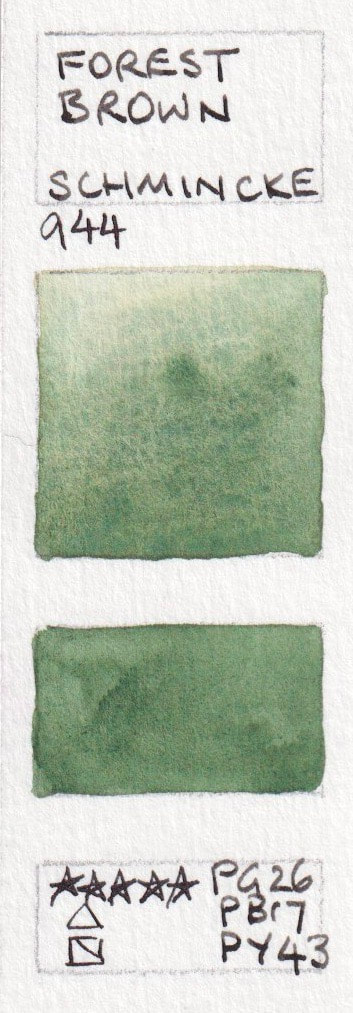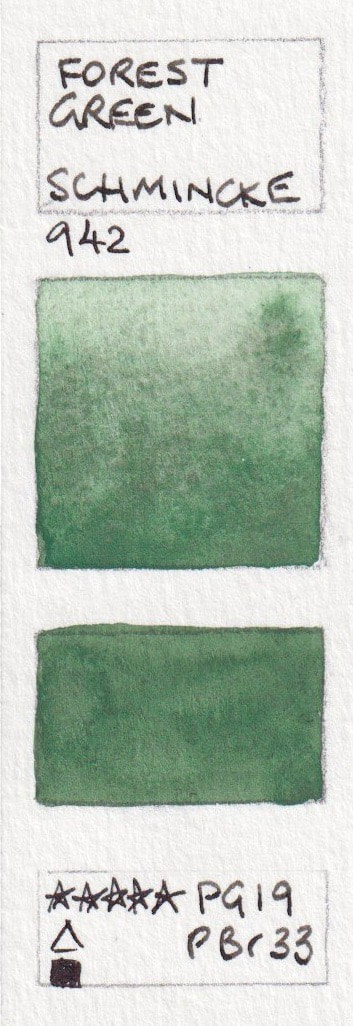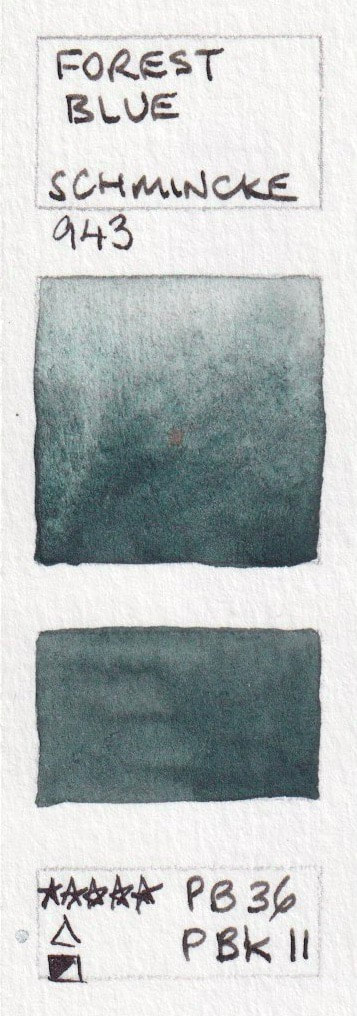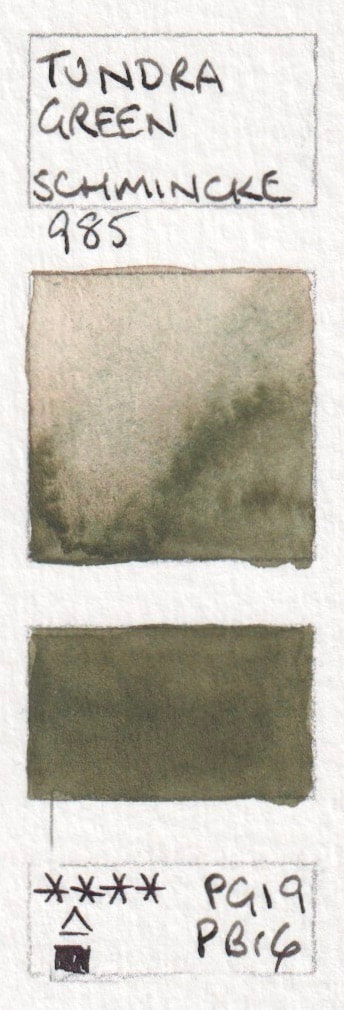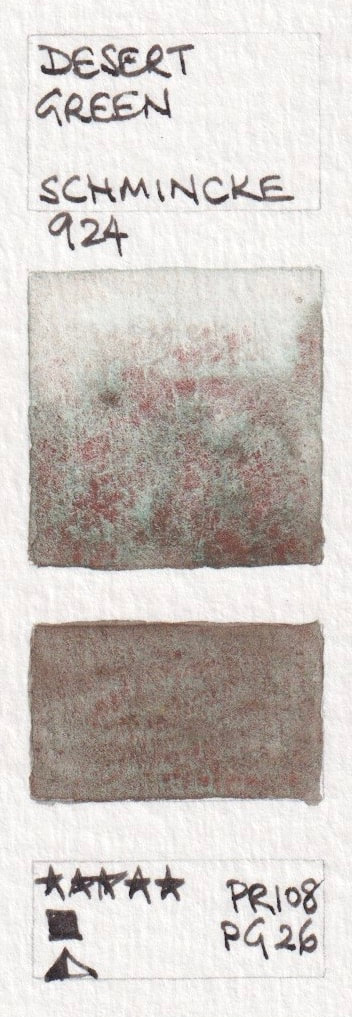8- Green Watercolour SwatchesThere are literally hundreds of artist quality watercolours available from many brands. I have tested many of them and created swatches as seen on the right. The square box is painted into a damp wash at the top to show the colour mixed in water, with more pigment added towards the bottom. The rectangle is painted in a juicy wash to show the mass-tone. The small squares at the bottom of the swatch have the pigment number and characteristics - staining, lightfast rating, granulation and transparency.
For more information on Green pigments, see the Artiscreation Green pigment database page here. The Handprint Green page is here, with comprehensive information based on lightfast tests completed in 2004. See some greens painted out on my YouTube channel here. (There is also a shorter version without commentary.) |
Single pigment Green Watercolours
Green pigments are denoted as PG followed by a number. Notice that Phthalo Green PG7 - a transparent, staining non-granulating green - is similar in hue to Viridian Green PG18, a transparent, non-staining granulating green. You can choose by colour and characteristics. Phthalo Green comes in GS (Green Shade) and YS (Yellow Shade).
NG2
While the only sample I have seen of this colour has been discontinued, I think it is helpful to be able to see what a natural green pigment looks like :-) The original sap greens were made from this pigment.
Buckthorn Green - A Gallo (discontinued)
Greens made with Phthalo Green PG7 - staining and transparent
An unrealistic looking colour alone, this is a wonderful mixing colour. It makes an amazing range of useful greens with a warm yellow, Burnt Sienna, Indian Red and other earth pigments, and crimsons and reds. Also known as phthalo green blue shade. It is a very consistent colour across the brands. Shown here, in alphabetical order by manufacturer:
- Joe's Green (Phthalo) - American Journey; Phthalo Green (Blue Shade) - Aquarius; Phthalo Green - Art Spectrum; Blockx Green - Blockx; Phthalo Green (Blue Shade)* - Daniel Smith;
- Phthalo Green - Da Vinci; Phthalo Green - Derivan; Viridian Hue - Holbein PG7; Cupric Green Deep - MaimeriBlu; Phthalo Green - M.Graham;
- Scheveningen Green Deep - Old Holland; Phthalo Green Blue Shade - QoR; Emerald Green - Renesans half pan; Emerald Green - Rosa; Phthalo Green - Schmincke;
- Richeson Green - Stephen Quiller; Viridian Hue - ShinHan PWC; Phthalo Green - Rembrandt; Winsor Green Blue Shade - Winsor & Newton; Winsor Green - Winsor & Newton.
PG8
This is a beautiful but fugitive green.
Hooker's Green Renesans pan; Green - Rosa; Green (Russian) - White Nights
Hooker's Green Renesans pan; Green - Rosa; Green (Russian) - White Nights
Greens made with Chromium Green Oxide - PG17
This is an interesting opaque and granulating pigment that is a very similar colour from each manufacturer, though the names for it vary a little.
- Chromium Oxide - A Gallo; Oxide of Chromium - Art Spectrum; Chromium Green Oxide* - Aquarius; Chrome Green - Blockx; Chromium Green* - Daniel Smith;
- Chromium Green Oxide - Da Vinci; Oxide Green* - Dirty Blue; Chrome Oxide Green - Kremer; Chromium Green Oxide, QoR; Chromium Oxide Green - Rembrandt;
- Chromium Oxide Green - Renesans half pan; Chromium Oxide* - Rosa; Chromium Oxide Green - Schmincke; Chromium Oxide Green - Sennelier; Oxide of Chromium - Winsor & Newton
Greens made with Viridian PG18 - granulating and liftable.
Although very similar in hue, Viridian is a much less powerful green in mixes than Phthalo Green. It is also granulating and non staining. It won't make the same wonderful blacks that can be created by mixing phthalo green with a crimson, bit it will make granulating colours that can be lifted out. It is a tricky pigment to make into a paint it seems, and may take a little more pre-wetting than most colours before use. I add a drop of glycerine to this in the palette and stir well to make rewetting easier.
- Viridian - American Journey; Viridian - Aquarius; Viridian - Blockx; Viridian* - Daniel Smith; Viridian - Daler Rowney;
- Viridian - Da Vinci; Viridian - Holbein; Viridian - MaimeriBlu, Viridian - QoR; Viridian - Rembrandt;
- Viridian - Schmincke; Viridian - Winsor & Newton
PG19
Cobalt Green Pale - Daniel Smith; Cobalt Green Bluish - Kremer; Cobalt Green Pure - Schmincke; Cobalt Green - Rembrandt (discontinued)
PG23
This gentle earth pigment doesn't have tinting strength but I enjoy using it for natural stones, rocks and landscape studies.
- Green Earth, Cool* - A Gallo; Green Earth, Warm* - A Gallo; Green Earth* - Aquarius; Glauconite* - Aquarius; Green Earth - Blockx;
- Rare Green Earth* - Daniel Smith; Green Earth* - Dirty Blue; Green Earth - Old Holland; Terre Vert - QoR; Terre Verte - Winsor & Newton;
- Terre Verte (Yellow Shade) - Winsor & Newton
Greens made with PG26
Cobalt Green Deep - Aquarius; Verona Green Earth - Lukas; Cobalt Green Deep - Old Holland; Cobalt Turquoise Green - Rembrandt; Cobalt Green Dark - Schmincke
Greens made with PBk31 - deep shadow greens
- Perylene Green* - Aquarius; Perylene Green* - Daniel Smith; Perylene Green - Da Vinci; Shadow Green - Holbein; Perylene Green - Schmincke;
- Shadow Green - ShinHen PWC; Perylene Green - Winsor & Newton
PBk32
Perylene Green Deep - Aquarius
Greens Made with Phthalo Green PG36
Best known as Phthalo Green Yellow Shade. Another bright, unrealistic, mixing green, that is more on the yellow side. Its mixing opposite is PR122 magenta. Shown here in alphabetical order by manufacturer:
- Phthalo Green (Yellow Shade) - Aquarius; Phthalo Green - Blockx; Phthalo Green (Yellow Shade) - Daniel Smith; Phthalo Green (Yellow Shade) - Da Vinci; Bamboo Green - Holbein;
- Phthalo Green Yellow Shade - M.Graham; Scheveningen Green - Old Holland; Emerald Green - Rembrandt; Phthalo Green Yellow - Rembrandt; Sennelier Green - Sennelier;
- Phthalo Green Yellow Shade - Turner; Winsor Green Yellow Shade - Winsor & Newton
Greens make with PB36 (see also Cerulean blues and Turquoises)
Cobalt Green - Sennelier; Cobalt Green Deep - Daler Rowney
Greens made with PY129
There are many names for this greenish yellow pigment. I like it as a cool yellow option, and for the glow of the sun shining through foliage.
- Green Gold - American Journey; Deep Green Gold* - Aquarius; Rich Green Gold* - Daniel Smith; Green Gold - Daler Rowney; Green Gold - Da Vinci;
- Green Gold* - Dirty Blue; Yellow, Greenish - Kremer; Azo Green - M.Graham; Gold Green - Old Holland; Green Gold - QoR;
- Azomethine Green Yellow - Rembrandt; Brown Green - Sennelier; Green Gold - Winsor & Newton
Cobalt Green Watercolours - made from PG50
It is interesting that you'll also find PG50 colours in the turquoise section.
- Cobalt Green (Genuine) - American Journey; Cobalt Green Light - Aquarius; Cobalt Green - Blockx; Cobalt Green* - Daniel Smith; Cobalt Green Light - MaimeriBlu;
- Cobalt Green - M. Graham; Cobalt Green - Old Holland; Cobalt Green - Renesans pan - Cobalt Green, Winsor & Newton
Daniel Smith Primatek greens
- Malachite* - Aquarius; Bohemian Green Earth* - Daniel Smith (discontinued); Malachite Genuine* - Daniel Smith (Discontinued); Serpentine Genuine* - Daniel Smith; Green Apatite Genuine*- Daniel Smith;
- Diopside Genuine* - Daniel Smith; Jadeite Genuine* - Daniel Smith; Ziozite Genuine* - Daniel Smith
Mixed Pigment Greens
Greens are complex. While the above are all single pigment, when painting we usually mix two to three pigments to create a realistic green. I've divided the mixed pigment greens into sections by colour name or colour hue or depth to try to make the mixed pigment greens easier to navigate. It can be convenient to have a mixed green in your palette, especially if it is made with pigments already in your palette for the best colour harmony.
Mixed or single pigment 'Hooker's' Greens
The name comes from William Hooker (1779-1832), an English Illustrator/botanical artist who created this mix to paint leaves. Originally made from Prussian Blue and Gamboge. Genuine Gamboge is fugitive, and not used in watercolour any more (I hope). The variety of mixes called Hooker's Green are vast and easy to mix oneself.
- Hooker's Green Light - American Journey; Hooker's Green Dark - American Journey; Hooker's Green - Aquarius PY150 + PB27; Hooker's Green - Blockx; Hooker's Green* - Daniel Smith (discontinued version);
- Hooker's Green* - Daniel Smith PG36 + PY3 + PY150 + PO48; Hooker's Green Light - Da Vinci; Hooker's Green Dark - Da Vinci; Hooker's Green - Holbein PG7 + PY110 + PY150; Hooker's Green - Jackson's PB29, PY153;
- Hooker's Green - MaimeriBlu PV49 + PG7 (discontinued); Hooker's Green Light Lake - Old Holland PY42 + PR 101 + PG7; Hooker's Green Lake Deep Extra - Old Holland PY42 + PG7 + PBk7; Hooker Green Deep - Rembrandt PG7 + PY150; Hooker's Green - Renesans pan PG8;
- Hooker's Green - Schmincke PB15:3 + PG7 + PY42; Hooker's Green - Sennelier PY83 + PG36; Hooker's Green - Winsor & Newton PG36 + PO49 (old version)
Mixed Pigment 'Olive' Greens
Olives come in many colours, as do these watercolours.
- Olive Green Deep* - A Gallo PY154 + PY110 + PB29; Olive Green* - American Journey PG7 + PY42; Olive Green Light* - Aquarius PBr25 + PB29 + PY129 + PY150; Olive Green Deep - Aquarius PY150 + PBk9 + PG17 + PBr25; Olive Green - Blockx PY154 + PG7 + PV19;
- Olive Green* - Daniel Smith PB29 + PY 97 + PBr7; Olive Green - Da Vinci PG7+PY42; Olive Green (old version)* - Holbein PY17 + PG36; Olive Green* - Holbein PY150, PG7, PBr25; Olive Green - M.Graham PG7 + PY110 + PBk9;
- Olive Green Dark - Old Holland PY129 + PB60 + PG7; Olive Green - Renesans pan PG8 + PY42 + PBk7 + PY83; Olive Green* - Rosa PG17 + PV1 + PBk7; Olive Green Yellowish - Schmincke PO62 + PG36; Permanent Olive Green - Schmincke PO62 + PG7 Schmincke;
- Permanent Green Olive - Schmincke PO62 + PG7; Olive Green - Schmincke PB15 + PG8; Forest Olive - Schmincke PG18 + PBr7 + PY43; Olive Green - Sennelier PY150 + PG36 + PBr23; Olive Green - Winsor & Newton PY42 + PG7
Mixed pigment 'Permanent' greens
- Permanent Green Light - Aquarius PY154 + PG7; Permanent Green - Blockx PY154 + PG7; Permanent Green* - Daniel Smith PY3 + PG7; Permanent Green Light* - Daniel Smith PG7 + PG3; Permanent Green #1 (old version) - Holbein PY1, PY53, PG7;
- Permanent Green #1 - Holbein PY3, PY53, PG7; Permanent Green #2 - Holbein PY74 + PY53 + PG7; Permanent Green #3 - Holbein PY3 + PY53 + PB15 (discontinued); Permanent Green Pale - M.Graham PY3 + PG7; Permanent Green Light - M.Graham PG7+PY151;
- Permanent Green Deep - MaimeriBlu PY175 + PG7 (discontinued); Permanent Green Deep - Old Holland PG7 + PY3 + PB29 + PW4; Permanent Green - Rembrandt PG7, PY154; Permanent Green - Schmincke PY155 + PG7; Permanent Green Light - Stephen Quiller PY154 + PG7;
Mixed pigment 'Prussian' Greens
Prussian Green* - Daniel Smith (Original version) PB27 + PY35 (discontinued); Prussian Green - Daniel Smith PB27 + PY 97; Prussian Green - Mission Gold PB27 + PG7; Prussian Green - Schmincke PG7 + PB60
Mixed Pigment 'Sap' Greens
I think nearly every range has a version sap green - all somewhat different. Sap green pigment was originally made from the juice of green buckthorn berries (see NG2 above), and was totally fugitive. While it is easy to mix your own sap green, a well chosen version that you like can be useful in the palette as a starting point. I particularly like the versions by Daniel Smith, Sennelier and Da Vinci.
- Sap Green - A Gallo PY83 + PG36 + PV19 + PR101; Sap Green - American Journey PG7 + PY42; Sap Green* - Aquarius PY150 + PG7; Sap Green Light* - Aquarius PY110 + PG7; Sap Green - Art Spectrum PY129 + PG7;
- Sap Green - Blockx PY154 + PG7; Sap Green* - Daniel Smith PO49 + PG7 (old version); Sap Green* (from 2015) - Daniel Smith PO48 + PG7 + PY150; Deep Sap Green* - Daniel Smith PB27 + PY3 + PO48; Sap Green - Da Vinci PG7 + PY42;
- Sap Green - Holbein PY150 + PG7 + PR122; Permanent Sap Green - Jackson's; Sap Green Permanent - M.Graham; Sap Green Lake Extra - Old Holland; Sap Green - QoR;
- Sap Green - Rembrandt; Sap Green - Renesans pan; Sap Green* - Rosa PY110 + PG7 + PBk6; Sap Green - Schmincke; Sap Green - Senneiler;
- Permanent Sap Green - Winsor & Newton
Mixed pigment Terre Verte hues
Terre Verte - Daler Rowney PBk11 + PY42 + PG18; Terre Verte* - Daniel Smith PG18 + PBr7; Terre Verte - Holbein PG17 + PG23; Terre Verte - Winsor & Newton PG18 + PG23 + PB28
Mixed Pigment 'Viridian' hues
Viridian (PG18) is a lovely gentle granulating green pigment. See gallery above. Often Phthalo green (PG7) is added to it to make it richer, or is used instead.
- Viridian Hue - A Gallo PG7 + PB29; Viridian Hue - Holbein PG7; Viridian - Jackson's PG18 + PG7; Viridian Green Deep - Old Holland PG18 + PB29; Viridian Green Light - Old Holland PG18 + PY3;
- Viridian - Sennelier PG7 + PG18;
Mixed pigment blue greens
These are cooler greens that lean towards the turquoise/blue end of the spectrum.
- Forest Green - A Gallo PG7 + PBk7 + PY43; Deep Sea Green - A Gallo PG18, PB29; Copper Blue - A Gallo PW4, + PG7 + PB15:3 + PY3; Blue Stone - American Journey PB36 + PY42; True Green - American Journey PG7 + PY43 (Discontinued);
- Mint Julip - American Journey PG7, PY3, PW6; Cascade Green* - Daniel Smith PBr7 + PB15; Cobalt Green - Holbein PG18 + PB28 + PW6; Cadmium Green Deep - Holbein PY35 + PG7 + PG18; Phthalocyanine Green Deep - Jackson's PB15:3 + PG7;
- Emerald Green - Old Holland PG36 + PG7 + PY74 + PW4; Ultramarine Green - Renesans pan PG7 + PB15:3; Mint - Rosa PG7 + PW6; Chromium Green Oxide Brilliant - Schmincke PG18 + PG7; Deep Sea Green - Schmincke PG18 + PB29;
- Glacier Green - Schmincke PR233 + PG50; Shire Blue - Schmincke PB29 + PG26 + PY159
Mixed pigment mid to yellow and golden greens
These are mid greens to warmer greens that lean towards the yellow end of the spectrum.
- Fig Green - A Gallo PY151, PG17; Malachite Hue, A Gallo Eggshells, PG7 + PG36 + PW6; Skip's Green (Thio Yellow Green) - American Journey PG7 + PY3; Spring Green (Permanent Green) - American Journey PG7 + PY3; Green Gold - Aquarius PY150 + PY129 + PG36
- Autumn Green* - Aquarius PG26 + PY150 + PR122; Golden Green - Blockx PY154 + PG36; Green Gold* - Daniel Smith PY150 + PY3 + PG36; Phthalo Yellow Green* - Daniel Smith PG7 + PY3; Spring Green* - Daniel Smith PY53 + PG36 + PY151H4G;
- Leaf Green - Da Vinci PG7 + PY65; Leaf Green - Holbein PY154 + PG7; Cadmium Green Pale - Holbein PY35 + PG18; Greenish Yellow - Holbein PY150 + PG7 + PBr25; Compose Green - Holbein PY3 + PG7 + PW6;
- Emerald Green Nova - Holbein PY3 + PG7 + PW6; Compose Green 3 - Holbien PY3 + PG8 (discontinued); Cadmium Green - Jackson's PG7, PY35; Permanent Green Yellowish - MaimeriBlu PY97 + PG36 (discontinued); Cadmium Green Light - Old Holland PG18 + PW4 + PY35;
- Cinnabar Green Deep Extra, Old Holland PG18+PY3+PW4; Golden Green - Renesans pan PY83 + PG17; Cinnabar Green - Renesans pan PG7 + PY3 + PY83; Zinc Green - Renesans pan PY3 + PG7; Cinnabar Green Deep - Renesans pan PG7 PY83;
- Bright Green - Rosa PY151 + PG7; Aureoline Green* - Rosa PY150 + PG7; Shire Olive - Schmincke PB35 + PY159; Shire Green - Schmincke PG18 + PY150; Bright Yellow Green - Sennelier PG7 + PY3;
- Leaf Green - ShinHan PWC PW6 + PG7 + PY74; Yellowish Green - White Nights PG7 + PY3
Mixed pigment deep and grey greens
- Chromium Oxide Green - American Journey PG17 + PG7; Earthen Green - American Journey PG7 + PY42 + PB29; Aquarius Green - Aquarius PY150 + PBr25 + PB29; Australian Leaf Green Dark - Art Spectrum PY129 + PG7 + PR175 + PY83; Undersea Green* - Daniel Smith PB29 + PO49 (original formulation);
- Undersea Green* - Daniel Smith PB29 + PO48 + PY150 (new formulation 2015); Dirty Blue Signature Colour - Dirty Blue PY43 + PB29; Green Grey - Holbein PG17 + PG23 + PBk6; Green Grey - Mission Gold PG36 + PBr7 + PW6; Green Umber - Old Holland PG23 + PG7 + PB15:2 + PBr7 + PBk7;
- Dusk Green - Rembrandt PBk11 + PG7; Dusk Yellow - Rembrandt Watercolour - PBk11, PY129; Green Earth Natural - Renesans pan watercolour PB27 + PY42; Black Green - Rosa PB15 + PBk7 + PBG7; Greenish Umber - Sennelier PB60 + PBk7 + PY83;
- Green Earth - Schmincke PBr7 + PG7; Forest Grey - Schmincke Br7 + PG50 + PBk11; Forest Brown - Schmincke PG26 + PBr7 + PY43; Forest Green - Schmincke PB36 + PBk11; Forest Blue - Schmincke PB36 + PBk11;
- Tundra Green - Schmincke PG19 + PBr6; Desert Green - Schmincke PR108 + PG26
These swatches are painted and added as a guide. The intention is to show the characteristics of each colour when painted. The colour reproduction is not perfect but hopefully will still be helpful used in conjunction with the manufacturer's website. Thank you to those of you, from Canada, Sweden, Australia and the USA, who have helped me with this section by sharing your favourite colours. If you notice errors please let me know so I can correct them. If you have artist quality watercolour that are not shown here and want to help me build up this resource, also please let me know :-)
|
If you find my website and blog useful, please consider making a one-off donation or perhaps a regular payment to help me keep my content free and up to date :-)
|
|
This page was last edited in December 2022.
